Paul van Yperen's Blog, page 97
February 6, 2023
Lex Barker
In Tarzan's Magic Fountain (Lee Sholem, 1949), Lex Barker became the tenth official Tarzan of the cinema. After a Hollywood career, Lex Barker moved to Europe. Here he worked with Federico Fellini and later became Old Shatterhand in the popular Karl May film series.
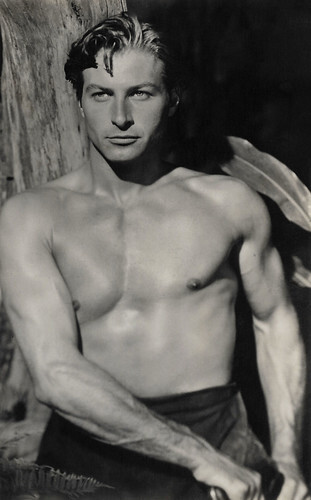
Spanish postcard by JDP, Barcelona, no. 1475. Lex Barker in Tarzan’s magic fountain (Lee Sholem, 1949).
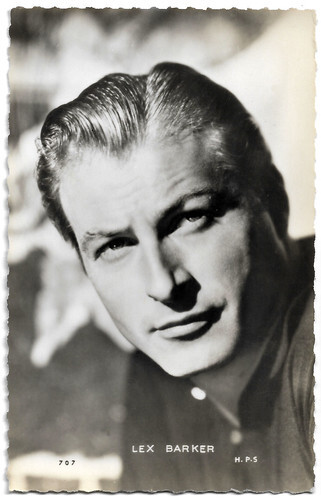
French postcard by Editions P.I., Paris, offered by Les Carbones Korès 'Carboplane', no. 37 G. Photo: H.P.S.
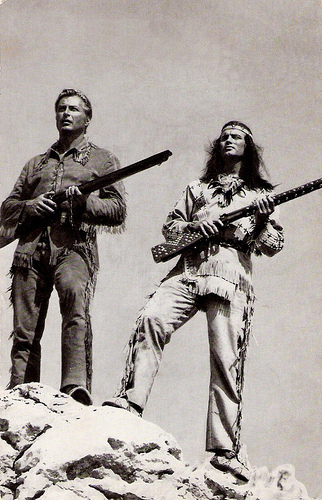
Vintage Dutch postcard. With Pierre Brice at right.
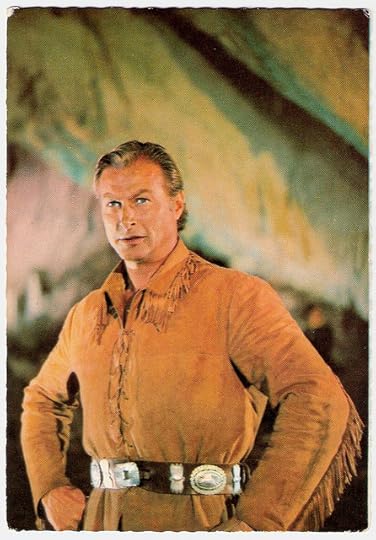
German postcard, no. E 82. Photo: Constantin. Publicity still for Der Schatz im Silbersee/Treasure of Silver Lake (1962).
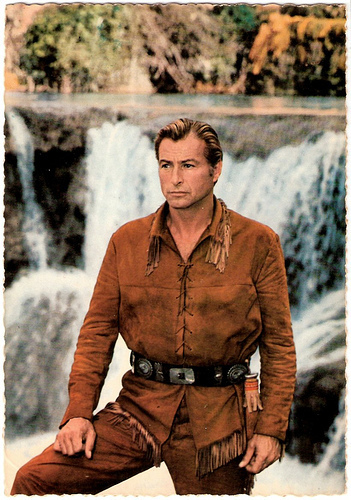
German postcard by Kruger. Photo: Bernard of Hollywood (Bruno Bernard) / CCC-Produktion. Publicity Still for Old Shatterhand (Hugo Fregonese, 1964).
Disowned by his family
Lex Barker was born Alexander Crichlow Barker, Jr. into a prominent and wealthy New York family in 1919 He was the second child of Alexander Crichlow Barker, Sr., a Canadian-born building contractor and his American wife, the former Marion Thornton Beals. His father later worked as a stockbroker.
Barker took time off from being a high-profile playboy to attend Princeton University but dropped out in order to join a theatrical stock company, much to the chagrin of his family. He made it to Broadway once, in a small role in a short run of William Shakespeare 's 'The Merry Wives of Windsor' in 1938. He also had a small role in Orson Welles 's disastrous 'Five Kings', which met with so many problems in Boston and Philadelphia that it never made it into New York.
Barker reportedly was spotted by scouts from Twentieth Century Fox and offered a film contract in 1939, but could not convince his parents to sign it (he was underage). Disowned by his family for his choice of an acting career, he worked in a steel mill and studied engineering at night.
In February 1941, ten months before the attack on Pearl Harbor, Barker left his fledgling acting career and enlisted in the US Army. He rose to the rank of major during the war. He was wounded in action fighting in Sicily.
Back in the United States, Barker recuperated at an Arkansas military hospital, then upon his discharge from service, travelled to Los Angeles. Within a short time, he landed a small role in his first film, Doll Face (Lewis Seiler, 1945) starring Vivian Blaine. A string of small roles followed, the best of which was Emmett Dalton in the Western Return of the Bad Men (Ray Enright, 1948). Barker then found the role that would bring him fame.
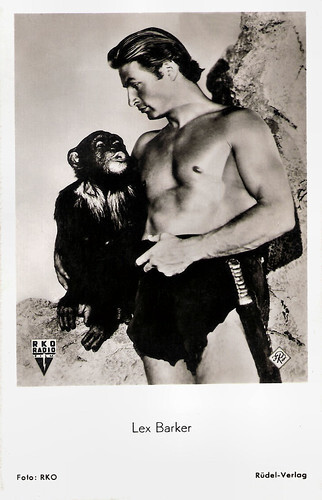
German postcard by Rüdel-Verlag, Hamburg-Bergedorf, no. 449. Photo: Alex Kahle / RKO Radio Film. Lex Barker in Tarzan's Magic Fountain (Lee Sholem, 1949).
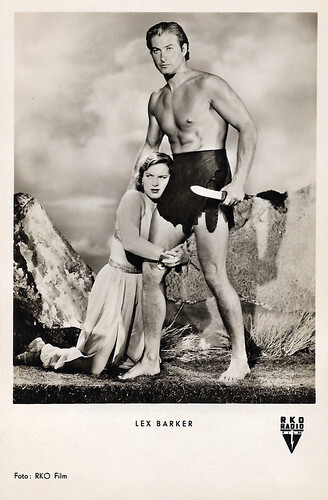
German postcard by Kunst und Bild, Berlin, no. A 580. Photo: RKO. Publicity still for Tarzan And The Slave Girl (Lee Sholem, 1950) with Denise Darcel .
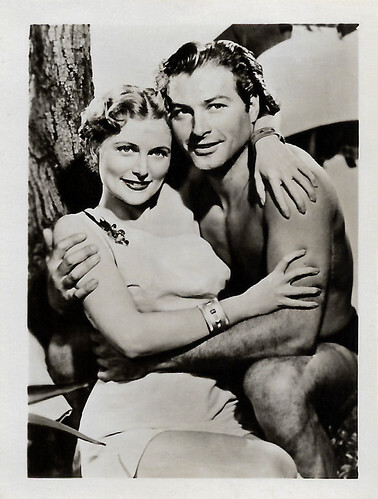
West German collectors card in the Filmstars der Welt series by Greiling-Sammelbilder, series C, no. 103. Photo: RKO. Virginia Huston and Lex Barker in Tarzan’s Peril (Byron Haskin, 1951).
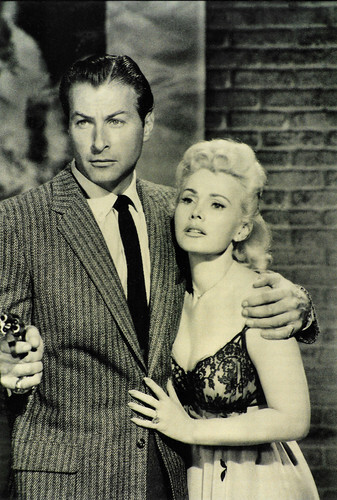
Vintage photo. Lex Barker and Zsa Zsa Gabor in The Girl in the Kremlin (Russell Birdwell, 1957).
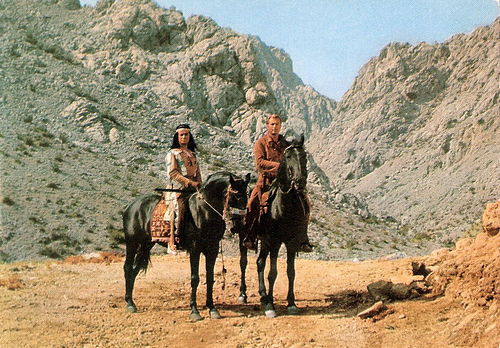
Dutch postcard by Facet Publishers, Lunteren, no. 4. Photo: Rank Film Distributors (Holland) N.V. Publicity still from Der Schatz im Silbersee (1963) with Pierre Brice .
Ape-ManIn Tarzan's Magic Fountain (Lee Sholem, 1949), Lex Barker became the tenth official Tarzan of the cinema. He replaced Johnny Weissmuller . His blond, stunningly handsome, and intelligent appearance, as well as his athletic frame, helped make him popular in the role of Edgar Rice Burroughs’ ape-man. Barker made only five Tarzan films produced by Sol Lesser between 1949 and 1953, but he remains one of the actors best known for the role.
His stardom as Tarzan led him to a variety of heroic roles in other films, primarily Westerns, and one interesting (and quite non-heroic) part in a World War II film, Away All Boats (Joseph Pevney, 1956) starring Jeff Chandler. Barker's film career began to stall; the rise of television had erased many roles for the handsome leading man.
In 1957, he moved to Europe. Via England, he made his way to Italy where he was very much at home in the wave of Peplums. He also filmed in Spain and France. In Italy, he had a short but prestigious role as Anita Ekberg 's fiancé in Federico Fellini 's La Dolce Vita (1960).
But Barker had his greatest success in Germany. There he starred in two films based on the Doctor Mabuse stories (formerly filmed by Fritz Lang ). As the hunter of the notorious Dr. Mabuse he played F.B.I. man Joe Como in the two black-and-white crime thrillers Im Stahlnetz des Dr. Mabuse/Return Of Dr. Mabuse (Harald Reinl, 1961) and Die Unsichtbare Krallen des Dr. Mabuse/Invisible Dr. Mabuse (Harald Reinl, 1962).
He also starred in the drama Frauenarzt Dr. Sibelius/Dr. Sibelius (Rudolf Jugert, 1962) and the comedy Frühstück im Doppelbett/Breakfast in Bed (Axel von Ambesser, 1963) with O.W. Fischer . His most successful film was the Karl May adaptation Der Schatz im Silbersee/Treasure of Silver Lake (Harald Reinl, 1962) with Pierre Brice as Winnetou.
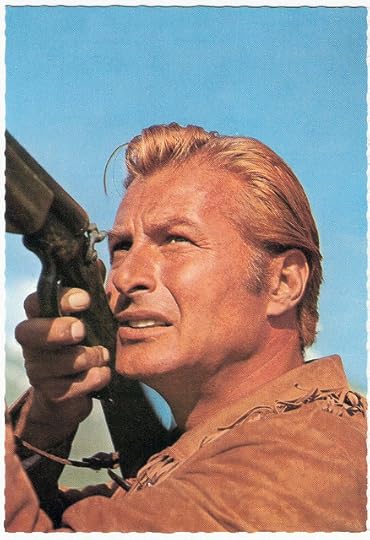
German postcard, no. E 79. Photo: Constantin. Publicity still for Der Schatz im Silbersee (1962).
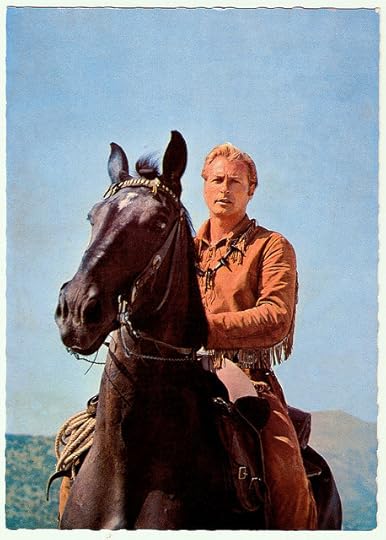
German postcard, no. E 53. Photo: Constantin. Publicity still for Der Schatz im Silbersee (1962).
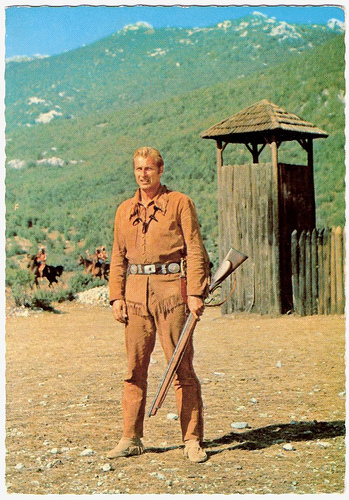
German postcard, no. E 57. Photo: Constantin. Publicity still for Der Schatz im Silbersee (1962).
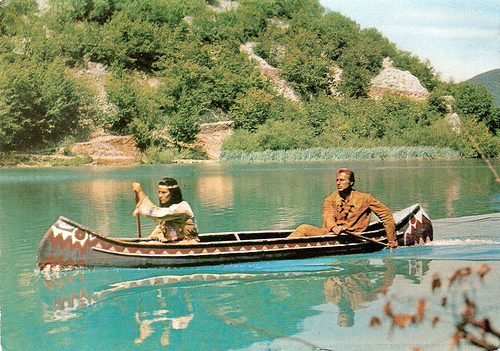
Dutch postcard by Gebr. Spanjersberg N.V., Rotterdam / Edition Facet Publishers. Photo: Rank Film Publishers (Holland) N.V. Publicity Still for Der Schatz im Silbersee (1962).
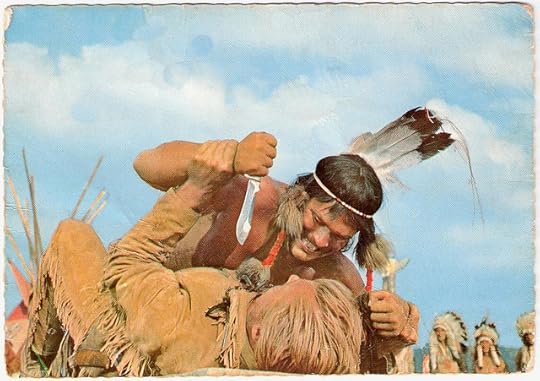
German postcard, no. E 72. Photo: Constantin. Publicity Still for Der Schatz im Silbersee (1962).
James Bond rip-offs
In the following years, Lex Barker played in 12 more films based on novels by Karl May in which he played such well-known May characters as Old Shatterhand, Kara Ben Nemsi, and Dr. Karl Sternau.
While American audiences forgot about him, his popularity in Europe quickly soared above the popularity of stars like John Wayne . In 1966, Barker was awarded the Bambi Award as Best Foreign Actor in Germany. He even recorded a single, in German, with Martin Böttcher, the composer of some of the soundtracks of the Karl May films: Ich bin morgen auf dem Weg zu dir (I'll be on the way to you tomorrow) and Mädchen in Samt und Seide (Girl in Silk and Velvet).
Barker returned to the United States occasionally and made a handful of guest appearances on American television episodes. But Europe, and especially Germany, was his professional home for the remainder of his life.
He showed up in a handful of James Bond rip-offs. In 1967, he appeared with Shirley MacLaine in one part of an American seven-part film Woman Times Seven (1967), directed by Vittorio de Sica .
Lex Barker died of a heart attack in 1973 in New York. He was 54. Barker had been married five times. His wives were Constance Rhodes Thurlow (1942-1950), actress Arlene Dahl (1951-1952), actress Lana Turner (1953-1957), Swiss actress Irene Labhardt (1957-1962) and Carmen Cervera (1965-1972), former Miss Spain. He left behind two sons and one daughter. One of his sons is actor Christopher Barker, from his marriage to Irene Labhart.
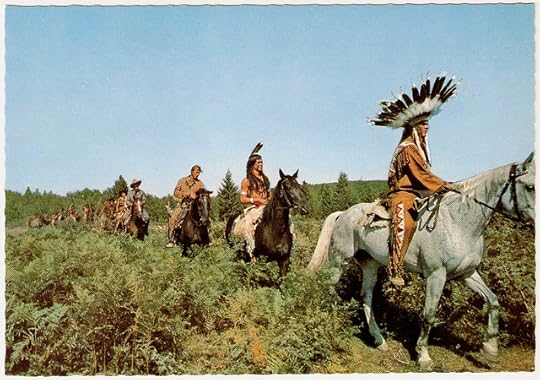
German postcard, no. E 66. Photo: Constantin. Publicity still for Der Schatz in Silbersee (1962).
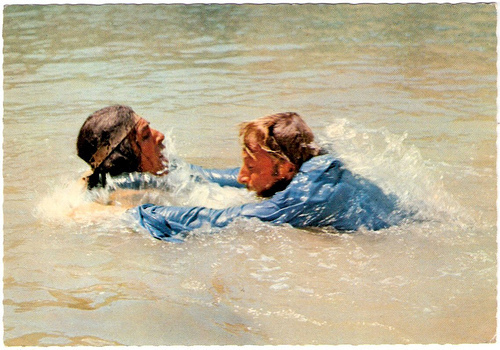
German postcard, no. E 25. Photo: Constantin. Publicity still for Winnetou I (1963) with Mavid Popovic. Caption: "In the water, there is a bitter fight between Old Shatterhand and Winnetou's father, the chief of the Apaches."
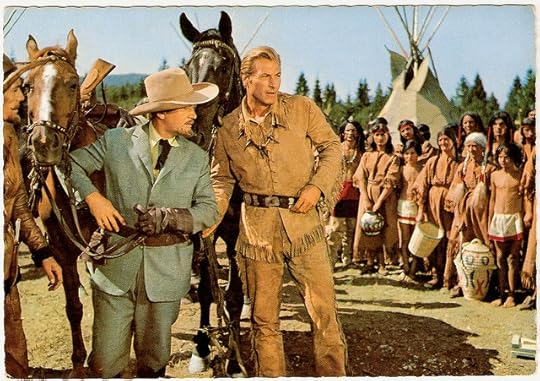
German postcard, no. E 68. Photo: Constantin. Publicity still for Der Schatz in Silbersee (1962) with Jan Sid.
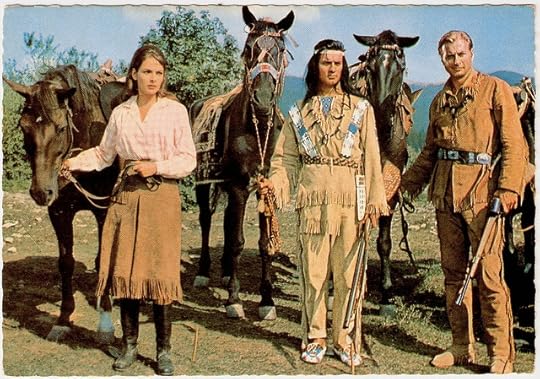
German postcard, no. E 64. Photo: Constantin. Publicity still for Der Schatz in Silbersee (1962) with Karin Dor and Pierre Brice .
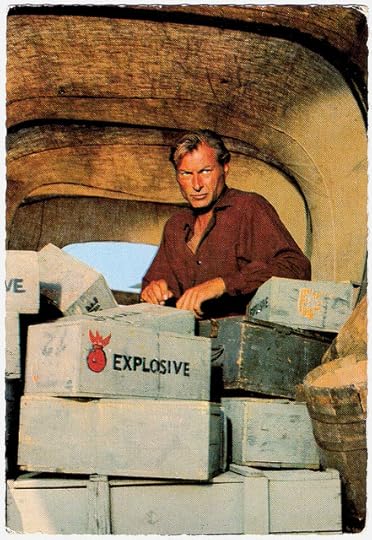
German postcard, no. E 9. Photo: Constantin. Still from Winnetou - 1. Teil/Apache Gold (Harald Reinl, 1963). Caption: "Old Shatterhand puts a rat in the ammunition and saves himself with a bold leap onto the horse. The remaining car, surrounded by Kiowas, explodes."
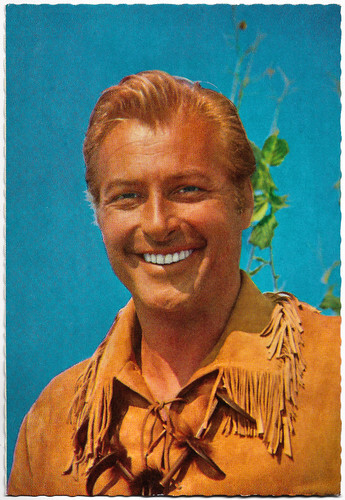
German postcard, no. E 28. Photo: Constantin. Lex Barker in Winnetou - 1. Teil/Apache Gold (1963). Caption: The blood brotherhood between Winnetou and Old Shatterhand is sealed with a solemn ceremony.
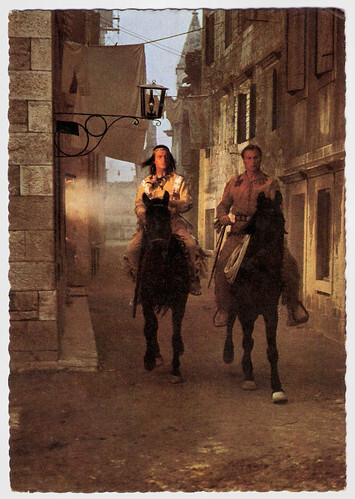
German postcard, no. 3. Photo: Rialto / Constantin. Publicity still for Winnetou III. Teil/Winnetou: The Last Shot (Harald Reinl, 1963) with Pierre Brice and Lex Barker. Caption: "Während Winnetou und Old Shatterhand zurückreiten, berichtet der Sekretär des Gouverneurs - der dem Letter des Desperados als Spitzel dient - von der Unterredung. Man beschliesst den Tod Winnetous und Old Shatterhands, der als Unfall hergestellt werden soll, und zwar durch vorzeitige Sprengung des Steinbruchs." (While Winnetou and Old Shatterhand ride back, the secretary of the governor reports about the conversation - which letter serves the spying Desperados. They decide to kill Winnetou and Old Shatterhand, produced as an accident, by premature detonation of the quarry.)
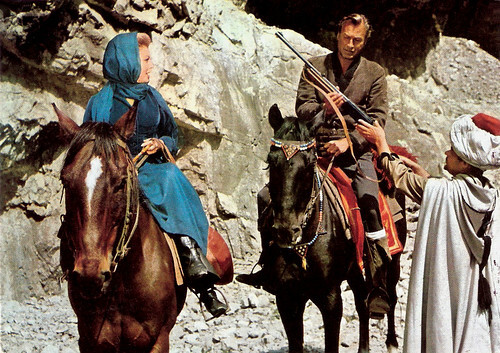
German postcard by Heinerle Karl-May-Postkarten, no. 29. Photo: CCC / Gloria. Marianne Hold and Lex Barker in Der Schut/The Yellow One (Robert Siodmak, 1964). Caption: "Wie froh bin ich, dass Ihnen nichts passiert ist, Mister Kara. Ich hörte die Schüsse..." - "Wie Sie sehen, ist mit diesem Mübarek alles gut gegangen, Madame Galingré. Fein dass Sie die Pferde mitgebracht haben. Da können Omar, Halef und Ich gleich die Verfolgung des Schut aufnehmen." ("How glad I am that nothing happened to you, Mister Kara (Lex Barker). I heard the shots ...." - "As you can see, everything went well with this Mübarek, Madame Galingré ( Marianne Hold ). Fine that you brought the horses. Omar, Halef and I can immediately do on with the persecution of The Yellow One.")
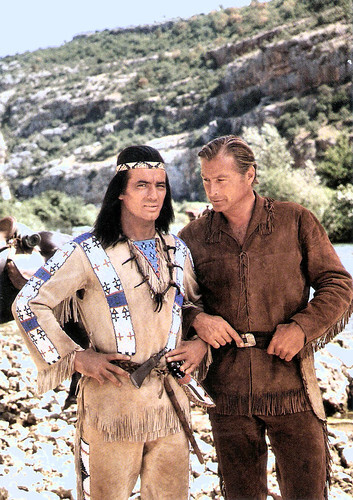
German postcard, no. 9. Photo: CCC / Constantin. Pierre Brice and Lex Barker in Winnetou und Shatterhand in Tal der Toten/The Valley of Death (Harald Reinl, 1968). Caption: "Old Shatterhand und Winnetou entwerfen einen Schlachtplan gegen die Murdock-Banditen." (Old Shatterhand and Winnetou devise a battle plan against the Murdock Bandits).
Sources: Hal Erickson (AllMovie), Lex Barker Official Site, Brian J. Walker (Brian's Drive-In Theater), Wikipedia and .

Spanish postcard by JDP, Barcelona, no. 1475. Lex Barker in Tarzan’s magic fountain (Lee Sholem, 1949).

French postcard by Editions P.I., Paris, offered by Les Carbones Korès 'Carboplane', no. 37 G. Photo: H.P.S.

Vintage Dutch postcard. With Pierre Brice at right.

German postcard, no. E 82. Photo: Constantin. Publicity still for Der Schatz im Silbersee/Treasure of Silver Lake (1962).

German postcard by Kruger. Photo: Bernard of Hollywood (Bruno Bernard) / CCC-Produktion. Publicity Still for Old Shatterhand (Hugo Fregonese, 1964).
Disowned by his family
Lex Barker was born Alexander Crichlow Barker, Jr. into a prominent and wealthy New York family in 1919 He was the second child of Alexander Crichlow Barker, Sr., a Canadian-born building contractor and his American wife, the former Marion Thornton Beals. His father later worked as a stockbroker.
Barker took time off from being a high-profile playboy to attend Princeton University but dropped out in order to join a theatrical stock company, much to the chagrin of his family. He made it to Broadway once, in a small role in a short run of William Shakespeare 's 'The Merry Wives of Windsor' in 1938. He also had a small role in Orson Welles 's disastrous 'Five Kings', which met with so many problems in Boston and Philadelphia that it never made it into New York.
Barker reportedly was spotted by scouts from Twentieth Century Fox and offered a film contract in 1939, but could not convince his parents to sign it (he was underage). Disowned by his family for his choice of an acting career, he worked in a steel mill and studied engineering at night.
In February 1941, ten months before the attack on Pearl Harbor, Barker left his fledgling acting career and enlisted in the US Army. He rose to the rank of major during the war. He was wounded in action fighting in Sicily.
Back in the United States, Barker recuperated at an Arkansas military hospital, then upon his discharge from service, travelled to Los Angeles. Within a short time, he landed a small role in his first film, Doll Face (Lewis Seiler, 1945) starring Vivian Blaine. A string of small roles followed, the best of which was Emmett Dalton in the Western Return of the Bad Men (Ray Enright, 1948). Barker then found the role that would bring him fame.

German postcard by Rüdel-Verlag, Hamburg-Bergedorf, no. 449. Photo: Alex Kahle / RKO Radio Film. Lex Barker in Tarzan's Magic Fountain (Lee Sholem, 1949).

German postcard by Kunst und Bild, Berlin, no. A 580. Photo: RKO. Publicity still for Tarzan And The Slave Girl (Lee Sholem, 1950) with Denise Darcel .

West German collectors card in the Filmstars der Welt series by Greiling-Sammelbilder, series C, no. 103. Photo: RKO. Virginia Huston and Lex Barker in Tarzan’s Peril (Byron Haskin, 1951).

Vintage photo. Lex Barker and Zsa Zsa Gabor in The Girl in the Kremlin (Russell Birdwell, 1957).

Dutch postcard by Facet Publishers, Lunteren, no. 4. Photo: Rank Film Distributors (Holland) N.V. Publicity still from Der Schatz im Silbersee (1963) with Pierre Brice .
Ape-ManIn Tarzan's Magic Fountain (Lee Sholem, 1949), Lex Barker became the tenth official Tarzan of the cinema. He replaced Johnny Weissmuller . His blond, stunningly handsome, and intelligent appearance, as well as his athletic frame, helped make him popular in the role of Edgar Rice Burroughs’ ape-man. Barker made only five Tarzan films produced by Sol Lesser between 1949 and 1953, but he remains one of the actors best known for the role.
His stardom as Tarzan led him to a variety of heroic roles in other films, primarily Westerns, and one interesting (and quite non-heroic) part in a World War II film, Away All Boats (Joseph Pevney, 1956) starring Jeff Chandler. Barker's film career began to stall; the rise of television had erased many roles for the handsome leading man.
In 1957, he moved to Europe. Via England, he made his way to Italy where he was very much at home in the wave of Peplums. He also filmed in Spain and France. In Italy, he had a short but prestigious role as Anita Ekberg 's fiancé in Federico Fellini 's La Dolce Vita (1960).
But Barker had his greatest success in Germany. There he starred in two films based on the Doctor Mabuse stories (formerly filmed by Fritz Lang ). As the hunter of the notorious Dr. Mabuse he played F.B.I. man Joe Como in the two black-and-white crime thrillers Im Stahlnetz des Dr. Mabuse/Return Of Dr. Mabuse (Harald Reinl, 1961) and Die Unsichtbare Krallen des Dr. Mabuse/Invisible Dr. Mabuse (Harald Reinl, 1962).
He also starred in the drama Frauenarzt Dr. Sibelius/Dr. Sibelius (Rudolf Jugert, 1962) and the comedy Frühstück im Doppelbett/Breakfast in Bed (Axel von Ambesser, 1963) with O.W. Fischer . His most successful film was the Karl May adaptation Der Schatz im Silbersee/Treasure of Silver Lake (Harald Reinl, 1962) with Pierre Brice as Winnetou.

German postcard, no. E 79. Photo: Constantin. Publicity still for Der Schatz im Silbersee (1962).

German postcard, no. E 53. Photo: Constantin. Publicity still for Der Schatz im Silbersee (1962).

German postcard, no. E 57. Photo: Constantin. Publicity still for Der Schatz im Silbersee (1962).

Dutch postcard by Gebr. Spanjersberg N.V., Rotterdam / Edition Facet Publishers. Photo: Rank Film Publishers (Holland) N.V. Publicity Still for Der Schatz im Silbersee (1962).

German postcard, no. E 72. Photo: Constantin. Publicity Still for Der Schatz im Silbersee (1962).
James Bond rip-offs
In the following years, Lex Barker played in 12 more films based on novels by Karl May in which he played such well-known May characters as Old Shatterhand, Kara Ben Nemsi, and Dr. Karl Sternau.
While American audiences forgot about him, his popularity in Europe quickly soared above the popularity of stars like John Wayne . In 1966, Barker was awarded the Bambi Award as Best Foreign Actor in Germany. He even recorded a single, in German, with Martin Böttcher, the composer of some of the soundtracks of the Karl May films: Ich bin morgen auf dem Weg zu dir (I'll be on the way to you tomorrow) and Mädchen in Samt und Seide (Girl in Silk and Velvet).
Barker returned to the United States occasionally and made a handful of guest appearances on American television episodes. But Europe, and especially Germany, was his professional home for the remainder of his life.
He showed up in a handful of James Bond rip-offs. In 1967, he appeared with Shirley MacLaine in one part of an American seven-part film Woman Times Seven (1967), directed by Vittorio de Sica .
Lex Barker died of a heart attack in 1973 in New York. He was 54. Barker had been married five times. His wives were Constance Rhodes Thurlow (1942-1950), actress Arlene Dahl (1951-1952), actress Lana Turner (1953-1957), Swiss actress Irene Labhardt (1957-1962) and Carmen Cervera (1965-1972), former Miss Spain. He left behind two sons and one daughter. One of his sons is actor Christopher Barker, from his marriage to Irene Labhart.

German postcard, no. E 66. Photo: Constantin. Publicity still for Der Schatz in Silbersee (1962).

German postcard, no. E 25. Photo: Constantin. Publicity still for Winnetou I (1963) with Mavid Popovic. Caption: "In the water, there is a bitter fight between Old Shatterhand and Winnetou's father, the chief of the Apaches."

German postcard, no. E 68. Photo: Constantin. Publicity still for Der Schatz in Silbersee (1962) with Jan Sid.

German postcard, no. E 64. Photo: Constantin. Publicity still for Der Schatz in Silbersee (1962) with Karin Dor and Pierre Brice .

German postcard, no. E 9. Photo: Constantin. Still from Winnetou - 1. Teil/Apache Gold (Harald Reinl, 1963). Caption: "Old Shatterhand puts a rat in the ammunition and saves himself with a bold leap onto the horse. The remaining car, surrounded by Kiowas, explodes."

German postcard, no. E 28. Photo: Constantin. Lex Barker in Winnetou - 1. Teil/Apache Gold (1963). Caption: The blood brotherhood between Winnetou and Old Shatterhand is sealed with a solemn ceremony.

German postcard, no. 3. Photo: Rialto / Constantin. Publicity still for Winnetou III. Teil/Winnetou: The Last Shot (Harald Reinl, 1963) with Pierre Brice and Lex Barker. Caption: "Während Winnetou und Old Shatterhand zurückreiten, berichtet der Sekretär des Gouverneurs - der dem Letter des Desperados als Spitzel dient - von der Unterredung. Man beschliesst den Tod Winnetous und Old Shatterhands, der als Unfall hergestellt werden soll, und zwar durch vorzeitige Sprengung des Steinbruchs." (While Winnetou and Old Shatterhand ride back, the secretary of the governor reports about the conversation - which letter serves the spying Desperados. They decide to kill Winnetou and Old Shatterhand, produced as an accident, by premature detonation of the quarry.)

German postcard by Heinerle Karl-May-Postkarten, no. 29. Photo: CCC / Gloria. Marianne Hold and Lex Barker in Der Schut/The Yellow One (Robert Siodmak, 1964). Caption: "Wie froh bin ich, dass Ihnen nichts passiert ist, Mister Kara. Ich hörte die Schüsse..." - "Wie Sie sehen, ist mit diesem Mübarek alles gut gegangen, Madame Galingré. Fein dass Sie die Pferde mitgebracht haben. Da können Omar, Halef und Ich gleich die Verfolgung des Schut aufnehmen." ("How glad I am that nothing happened to you, Mister Kara (Lex Barker). I heard the shots ...." - "As you can see, everything went well with this Mübarek, Madame Galingré ( Marianne Hold ). Fine that you brought the horses. Omar, Halef and I can immediately do on with the persecution of The Yellow One.")

German postcard, no. 9. Photo: CCC / Constantin. Pierre Brice and Lex Barker in Winnetou und Shatterhand in Tal der Toten/The Valley of Death (Harald Reinl, 1968). Caption: "Old Shatterhand und Winnetou entwerfen einen Schlachtplan gegen die Murdock-Banditen." (Old Shatterhand and Winnetou devise a battle plan against the Murdock Bandits).
Sources: Hal Erickson (AllMovie), Lex Barker Official Site, Brian J. Walker (Brian's Drive-In Theater), Wikipedia and .
Published on February 06, 2023 22:00
February 5, 2023
Brenda Joyce
Brenda Joyce (1917-2009) was an American film actress, who starred in many B-movies of the 1940s. The buxom blonde, excellent athlete, and swimmer is best-remembered as the seventh actress to play Jane in the Tarzan films.
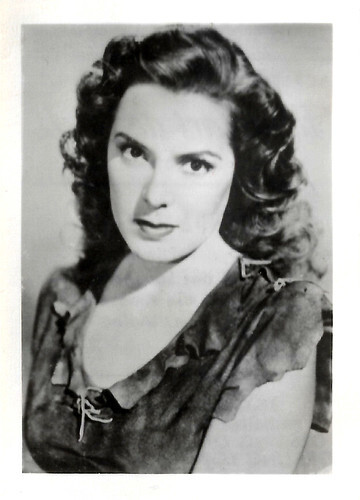
West German collectors card in the Filmstars der Welt series by Greiling-Sammelbilder, series E, no. 171. Photo: RKO. Brenda Joyce as Jane in one of the Tarzan films.
Smiling in glossy magazines in new automobiles, using toothpaste, and modelling shoes
Brenda Joyce was born Betty Graftina Leabo in 1917 (some sources suggest 1912) in Excelsior Springs, Missouri, and was known to family and friends as Graftina. She was the daughter of Mr. and Mrs. Grafton Leabo. When she was 5 years old, she moved with her mother to San Bernardino, California, staying there through her junior high school years.
They moved to Los Angeles, California, where she was educated at San Bernardino and Los Angeles High Schools, and attended one semester at USC and three more at UCLA. Between her years in college and those in film, Joyce was a model for photographers. She appeared smiling in glossy magazines in new automobiles, using toothpaste, and modelling shoes.
Then a talent scout from 20th Century Fox spotted her in one of these fashion magazine layouts, and she was signed to a two-picture contract. 20th Century Fox changed her name to Brenda Joyce after the silent screen actress Alice Joyce .
Joyce made her film debut as Fern Simon, the second female lead in the Oscar-winning earthquake epic The Rains Came (Clarence Brown, 1939) opposite Myrna Loy and Tyrone Power . The role won her good reviews and after Here I Am a Stranger (Roy Del Ruth, 1939), about a young Englishman ( Richard Greene ) in search of his alcoholic father ( Richard Dix ), Joyce was signed indefinitely.
She played Harriet Livingstone in the historical drama Little Old New York (Henry King, 1940); co-starred with Walter Brennan and Hattie McDaniel in Maryland (Henry King, 1940); tried her luck as a comedienne in Public Deb No 1 (Gregory Ratoff, 1940) with George Murphy; and walked up the aisle in Marry the Boss's Daughter (Thornton Freeland, 1941).
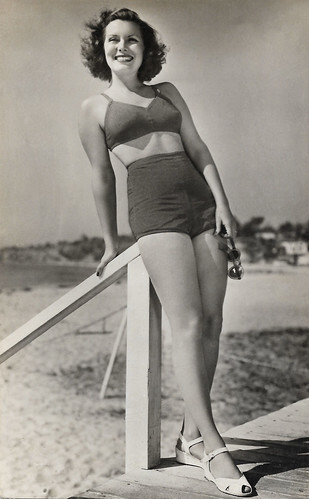
Spanish postcard in the Hollywood (California) series. Photo: Universal International.
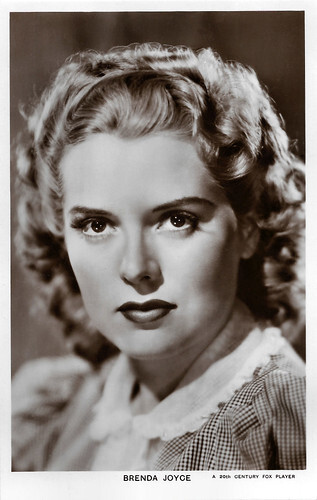
British postcard in the Picturegoer Series, London, no. 1361. Photo: 20th Century Fox.
Tarzan's Mate
Brenda Joyce was billed as a sexy 'available' blonde, but Fox's most favoured pin-up of 1940 married Owen Ward, an Army officer. The studio punished her by relegating her to a string of B-pictures. She was also cast as Maris Hanover in Little Tokyo, U.S.A. (Otto Brower, 1942) with Preston Foster, produced in the period immediately following Pearl Harbor, and the United States entered World War II.
Little Tokyo, U.S.A. used a quasi-documentary style of filming and Twentieth Century Fox sent its cameramen to the Japanese quarter of Los Angeles to shoot the actual evacuation there. Little Tokyo, U.S.A. was meant to alert Americans to the dangers of foreign agents, but it is now controversial for its largely negative portrayal of Japanese Americans. More notable roles saw her star in such B-chillers as Pillow of Death (Wallace Fox, 1945) with Lon Chaney Jr., and The Spider Woman Strikes Back (Arthur Lubin, 1946) starring Gale Sondergaard.
Brenda Joyce is now best-remembered as the seventh actress to play Jane in the Tarzan film series. In Tarzan and the Amazons (Kurt Neumann, 1945), she succeeded Maureen O'Sullivan in the series and appeared in the role five times. Her first four appearances as Jane were opposite Johnny Weissmuller as Tarzan. However, her last performance as Jane, in Tarzan's Magic Fountain (Lee Sholem, 1949), was with Lex Barker as Tarzan. Joyce and Karla Schramm, from the silent era, were the only two actresses to play Jane opposite two different actors playing Tarzan.
It was to be her final film. According to the Daily Telegraph: "Away from the jungle sets at Metro-Goldwyn-Mayer's Culver City lot, Brenda Joyce admitted to detesting the role of Jane, and of being scared of the MGM lion (which was brought out of retirement for Tarzan and the Amazons in 1945 and was by then toothless). Also, she was upset at Johnny Weissmuller 's persistent sexual harassment."
In 1949, Joyce retired from acting to raise a family. Later, as Betty Ward, she became director of the Catholic Resettlement Office in Monterey, California, and helped refugees. She was married to Owen Ward, whom she had known since high school, from 1941 until their divorce in 1960. They had three children, Pamela Ann, Timothy Owen and Beth Victoria. In 1971, she appeared in two episodes of the PBS children's show Mister Rogers' Neighborhood before retiring for good.
Brenda Joyce died of pneumonia in 2009, in a nursing home in Santa Monica, California. She was 92. Colleagues at the Department of Immigration had no idea that she had once been Brenda Joyce and Tarzan's mate, as she decided not to tell. She also concealed her past from staff at the nursing home in Santa Monica where she spent her last years – although she did agree to a visit from the actor Johnny Sheffield, who played her adopted son Boy in the Tarzan series.
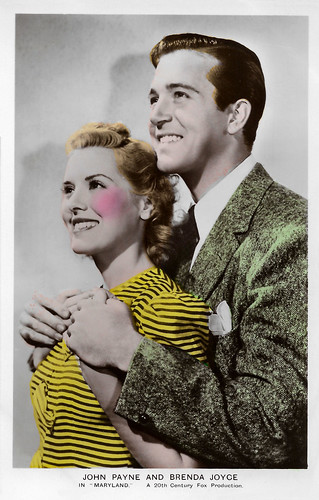
British postcard in the Film Partners Series, London, no PC 320. Photo: 20th Century Fox. John Payne and Brenda Joyce in Maryland (Henry King, 1940).
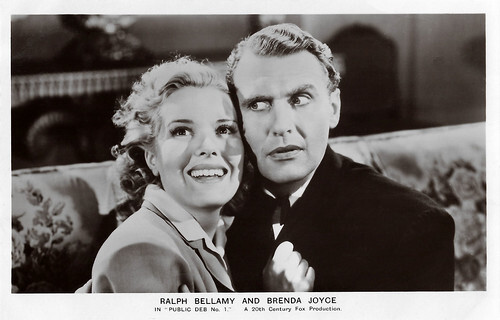
British postcard in the Film Partners Series, London, no. P322. Photo: 20th Century Fox. Ralph Bellamy and Brenda Joyce in Public Deb No. 1 (Gregory Ratoff, 1940).
Sources: Daily Telegraph, Wikipedia and .

West German collectors card in the Filmstars der Welt series by Greiling-Sammelbilder, series E, no. 171. Photo: RKO. Brenda Joyce as Jane in one of the Tarzan films.
Smiling in glossy magazines in new automobiles, using toothpaste, and modelling shoes
Brenda Joyce was born Betty Graftina Leabo in 1917 (some sources suggest 1912) in Excelsior Springs, Missouri, and was known to family and friends as Graftina. She was the daughter of Mr. and Mrs. Grafton Leabo. When she was 5 years old, she moved with her mother to San Bernardino, California, staying there through her junior high school years.
They moved to Los Angeles, California, where she was educated at San Bernardino and Los Angeles High Schools, and attended one semester at USC and three more at UCLA. Between her years in college and those in film, Joyce was a model for photographers. She appeared smiling in glossy magazines in new automobiles, using toothpaste, and modelling shoes.
Then a talent scout from 20th Century Fox spotted her in one of these fashion magazine layouts, and she was signed to a two-picture contract. 20th Century Fox changed her name to Brenda Joyce after the silent screen actress Alice Joyce .
Joyce made her film debut as Fern Simon, the second female lead in the Oscar-winning earthquake epic The Rains Came (Clarence Brown, 1939) opposite Myrna Loy and Tyrone Power . The role won her good reviews and after Here I Am a Stranger (Roy Del Ruth, 1939), about a young Englishman ( Richard Greene ) in search of his alcoholic father ( Richard Dix ), Joyce was signed indefinitely.
She played Harriet Livingstone in the historical drama Little Old New York (Henry King, 1940); co-starred with Walter Brennan and Hattie McDaniel in Maryland (Henry King, 1940); tried her luck as a comedienne in Public Deb No 1 (Gregory Ratoff, 1940) with George Murphy; and walked up the aisle in Marry the Boss's Daughter (Thornton Freeland, 1941).

Spanish postcard in the Hollywood (California) series. Photo: Universal International.

British postcard in the Picturegoer Series, London, no. 1361. Photo: 20th Century Fox.
Tarzan's Mate
Brenda Joyce was billed as a sexy 'available' blonde, but Fox's most favoured pin-up of 1940 married Owen Ward, an Army officer. The studio punished her by relegating her to a string of B-pictures. She was also cast as Maris Hanover in Little Tokyo, U.S.A. (Otto Brower, 1942) with Preston Foster, produced in the period immediately following Pearl Harbor, and the United States entered World War II.
Little Tokyo, U.S.A. used a quasi-documentary style of filming and Twentieth Century Fox sent its cameramen to the Japanese quarter of Los Angeles to shoot the actual evacuation there. Little Tokyo, U.S.A. was meant to alert Americans to the dangers of foreign agents, but it is now controversial for its largely negative portrayal of Japanese Americans. More notable roles saw her star in such B-chillers as Pillow of Death (Wallace Fox, 1945) with Lon Chaney Jr., and The Spider Woman Strikes Back (Arthur Lubin, 1946) starring Gale Sondergaard.
Brenda Joyce is now best-remembered as the seventh actress to play Jane in the Tarzan film series. In Tarzan and the Amazons (Kurt Neumann, 1945), she succeeded Maureen O'Sullivan in the series and appeared in the role five times. Her first four appearances as Jane were opposite Johnny Weissmuller as Tarzan. However, her last performance as Jane, in Tarzan's Magic Fountain (Lee Sholem, 1949), was with Lex Barker as Tarzan. Joyce and Karla Schramm, from the silent era, were the only two actresses to play Jane opposite two different actors playing Tarzan.
It was to be her final film. According to the Daily Telegraph: "Away from the jungle sets at Metro-Goldwyn-Mayer's Culver City lot, Brenda Joyce admitted to detesting the role of Jane, and of being scared of the MGM lion (which was brought out of retirement for Tarzan and the Amazons in 1945 and was by then toothless). Also, she was upset at Johnny Weissmuller 's persistent sexual harassment."
In 1949, Joyce retired from acting to raise a family. Later, as Betty Ward, she became director of the Catholic Resettlement Office in Monterey, California, and helped refugees. She was married to Owen Ward, whom she had known since high school, from 1941 until their divorce in 1960. They had three children, Pamela Ann, Timothy Owen and Beth Victoria. In 1971, she appeared in two episodes of the PBS children's show Mister Rogers' Neighborhood before retiring for good.
Brenda Joyce died of pneumonia in 2009, in a nursing home in Santa Monica, California. She was 92. Colleagues at the Department of Immigration had no idea that she had once been Brenda Joyce and Tarzan's mate, as she decided not to tell. She also concealed her past from staff at the nursing home in Santa Monica where she spent her last years – although she did agree to a visit from the actor Johnny Sheffield, who played her adopted son Boy in the Tarzan series.

British postcard in the Film Partners Series, London, no PC 320. Photo: 20th Century Fox. John Payne and Brenda Joyce in Maryland (Henry King, 1940).

British postcard in the Film Partners Series, London, no. P322. Photo: 20th Century Fox. Ralph Bellamy and Brenda Joyce in Public Deb No. 1 (Gregory Ratoff, 1940).
Sources: Daily Telegraph, Wikipedia and .
Published on February 05, 2023 22:00
February 4, 2023
Gordon Scott
Good-looking and muscular American actor Gordon Scott (1926–2007) is best known as the eleventh Tarzan. He portrayed Tarzan in five films from 1955 to 1960. Then Scott moved to Italy, where he became a popular star of the Peplum film genre, the sword-and-sandal epics. As the Peplum faded, Scott starred in Spaghetti Westerns and Eurospy films.
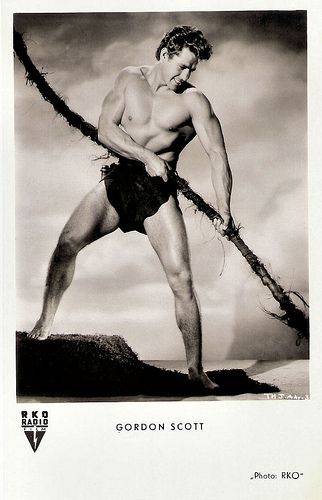
German postcard by Kunst und Bild, no. I 411. Photo: RKO. Publicity still for Tarzan's Hidden Jungle (Harold D. Schuster, 1955).
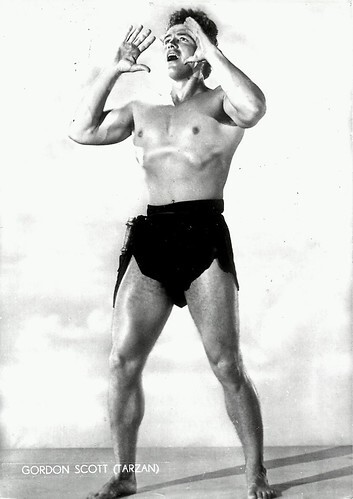
Italian 'vera fotografia' (real photo) postcard, no. 401. Gordon Scott as Tarzan.

German collectors card by J & M Serienbilder Produktion Saar, no. 68. Photo: Gloria Film. Publicity still for Buffalo Bill, l'eroe del far west/Buffalo Bill, Hero of the Far West (Mario Costa, 1965). Caption: "In einem Zweikampf auf Leben und Tod hat Buffalo Bill, der berühmteste Held des Wilden Westens, seinen gefährlichsten Feind bezwungen. Der edle Kämpfer schenkt seinem Gegner das Leben. Die Indianer selbst sollen seine Strafe bestimmen." (In a duel to the death, Buffalo Bill, the famous hero of the Wild West, has defeated his most dangerous enemy. The noble warrior gives his opponent his life. The Indians themselves have to determine his punishment.)
Handsome features, muscular physique, and imposing height
Gordon Scott was born Gordon Merrill Werschkul in Portland, Oregon, in 1926. He was one of nine children of advertising man Stanley Werschkul and his wife Alice. He was raised in Oregon and studied Physical Education at the University of Oregon for one semester.
Upon leaving school, he joined the U.S. Army in 1944. He served as a drill sergeant and military policeman and specialised in close-order drill, judo and hand-to-hand combat. After his honourable discharge in 1947, he took on a variety of jobs, including fireman, cowboy, and farm-machinery salesman. In 1953 he was working as a lifeguard at the Sahara Hotel in Las Vegas when he was spotted by Hollywood agents, Ed and Walter Mayers. They were impressed by his handsome features, muscular physique, and imposing height.
Scott then beat out 200 contestants to replace Lex Barker as Edgar Rice Burroughs' famous jungle hero Tarzan. Film producer Sol Lesser offered him a 7-year contract, a loincloth and a new last name. Reportedly, ‘Werschkul’ sounded too much like ‘Weissmuller’. Renamed Gordon Scott, he debuted in the low-budget Tarzan’s Hidden Jungle (Harold D. Schuster, 1955).
It led to a romance with co-star Vera Miles, who became his wife in 1956. They divorced in 1959. Tarzan’s Hidden Jungle was followed by Tarzan and the Lost Safari (H. Bruce Humberstone, 1957), the first Tarzan film in colour. It was filmed in Nairobi, British East Africa. In his early Tarzan films, Scott played the character as unworldly and inarticulate, in the mould of Johnny Weissmuller .
In 1958, Sol Lesser sold Scott's contract to Sy Weintraub. The new producer took his star to Paramount Pictures and, fueled by bigger production budgets, made two of the most successful Tarzan films, Tarzan's Greatest Adventure (John Guillermin, 1959) with Anthony Quayle and Sean Connery, and Tarzan the Magnificent (Robert Day, 1960) with Jock Mahoney. In these later films, Scott played a Tarzan who was educated and spoke perfect English, as in the original Edgar Rice Burroughs novels. Gordon Scott was the only actor to play Tarzan in both styles.
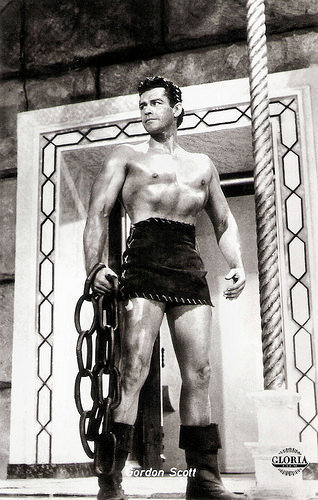
German postcard by Kolibri/Friedrich W. Sander-Verlag, Minden/Westf., no. 2322. Photo: Gloria Film. Publicity still for Maciste contro il vampiro/Maciste Vs. the Vampire (Giacomo Gentilomo, 1961).
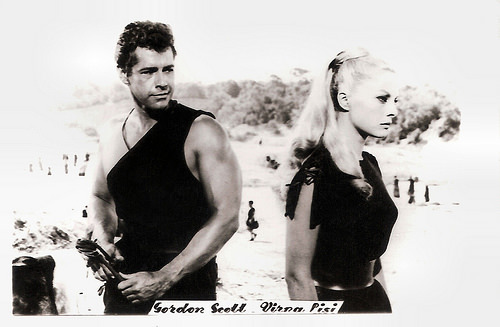
Small Romanian collectors card. Photo: Gordon Scott and Virna Lisi in Romolo e Remo/Duel of the Titans (Sergio Corbucci, 1961).
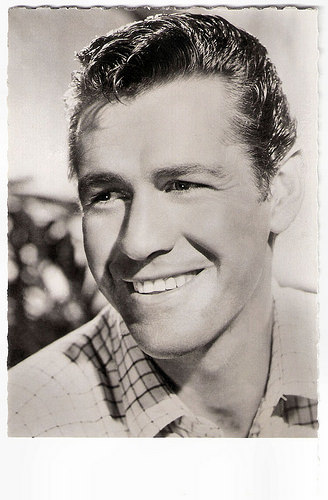
Vintage postcard.
Sword-and-sandal epics
Fearing he would become typecast as Tarzan, Gordon Scott moved to Italy. There he became a popular star of the Peplum genre, the sword-and-sandal epics featuring handsome bodybuilders as various characters from Greek and Roman myth.
Scott was an old training buddy of Hercules star Steve Reeves. Reeves had agreed to star in the Sergio Leone-penned saga Romolo e Remo/Duel of the Titans (Sergio Corbucci, 1961) about the two brothers of Roman Mythology, who founded Rome. The producer wanted Reeves to play both Romulus and Remus, but Reeves objected that the film would be more effective with another actor in the role of Remus. He recommended Gordon Scott, and the film co-starred Virna Lisi , Laura Solari, Massimo Girotti and Jacques Sernas . Scott was given the highest salary he had earned thus far for taking the role.
Next followed Maciste alla corte del Gran Khan/Maciste at the Court of the Great Khan (Riccardo Freda, 1961), which re-used the sets, extras and Yoko Tani as a princess from Marco Polo (Piero Pierotti, Hugo Fregonese, 1961) and Freda's I mongoli/The Mongols (André De Toth, Leopoldo Savona, Riccardo Freda, 1961).
Scott played Julius Caesar opposite Pascale Petit as Cleopatra in the historical drama Una regina per Cesare/A Queen for Caesar (Piero Pierotti, Victor Tourjansky, 1962) set in Egypt in 48 BC. Unlike other films about Caesar and Cleopatra, this film focuses entirely on the dynastic struggle within Egypt leading up to the arrival of Caesar, and in fact, we only see him in the closing scene of the film when he arrives at The Ptolemaic Palace in Alexandria. 20th Century Fox bought the rights for the film to keep it out of release lest it competed with their own Cleopatra, featuring Elizabeth Taylor. Scott also played Hercules in a couple of international co-productions during the mid-1960s.
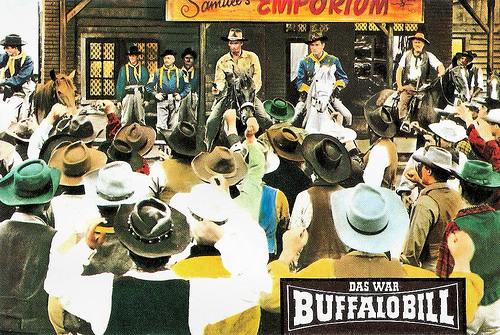
German collectors card by J & M Serienbilder Produktion Saar, no. 34. Photo: Gloria Film. Publicity still for Buffalo Bill, l'eroe del far west/Buffalo Bill, Hero of the Far West (Mario Costa, 1965) with Gordon Douglas. Caption: "Buffalo Bill hat sich auf die Fährte des weissen Waffenhändlers gesetzt, der die Rothäute zum Kampf aufwiegelt. Furchtlos hält Bill eine Übermacht rauher Burschen in Schach." (Buffalo Bill has set himself at the trail of the white arms dealer who incites the redskins to fight. Fearless Bill holds a a superior force of rough boys at bay.)

German collectors card by J & M Serienbilder Produktion Saar, no. 35. Photo: Gloria Film. Publicity still for Buffalo Bill, l'eroe del far west/Buffalo Bill, Hero of the Far West (Mario Costa, 1965) with Gordon Douglas. Caption: "Buffalo Bill, der Held des Wilden Westens ohne Furcht und Tadel, fürchtete selbst die gefährlichtsen Gegner nicht. Er ist entschlossen den illegalen Waffenhändlern das Handwerk zu legen." (Buffalo Bill, the hero of the Wild West without fear and without reproach, did not fear even the most dangerous opponent. He is determined to put down the business of the illegal arms dealers.)
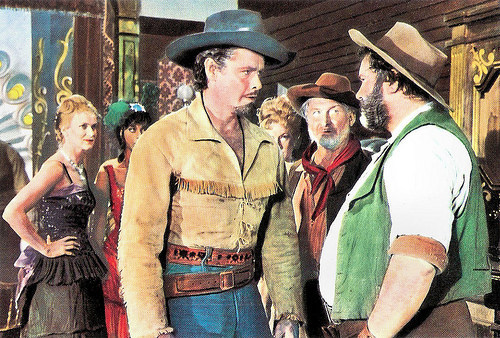
German collectors card by J & M Serienbilder Produktion Saar, no. 43. Photo: Gloria Film. Publicity still for Buffalo Bill, l'eroe del far west/Buffalo Bill, Hero of the Far West (Mario Costa, 1965) with Gordon Douglas. Caption: "Buffalo Bill begibt sich mit seinem Gefährten in die Höhle des Löwen. Als harmloser Gast horcht er in der Bar des Dunkelmannes Monroe herum, um zu erfahren wo die entführte Häuptlingstochter 'Mondstrahl' gefangen gehalten wird." (Buffalo Bill embarks with his companions in the lion's den. As harmless guest he listens around in the bar of the dark man Monroe to find out where 'Moonbeam', the chief's kidnapped daughter, is being held captive.)
Buffalo Bill
As the Peplum genre faded, Gordon Scott starred in other genre films. His first Spaghetti Western was Buffalo Bill, l'eroe del far west/Buffalo Bill, Hero of the Far West (Mario Costa, 1964) with Jan Hendriks .
He also starred in the Eurospy film Il Raggio infernale/Danger!! Death Ray (Gianfranco Baldanello, 1967). It was released at a time when the James Bond films, and spy films in general, were very popular internationally. His early military combat and martial arts training made it possible for him to do many of his own stunts.
His final film appearance was in the Spaghetti Western Gli uomini dal passo pesante/The Tramplers (Albert Band, Mario Sequi, 1966-1968) with Joseph Cotten and Franco Nero . He left Italy and never made another film. He was trailed by a reputation as a ladies' man who seldom paid his bills, according to a 1987 article in the Toronto Star. For the last two decades of his life, Scott was a popular guest at film conventions and autograph shows and sold knives.
In 2007, Gordon Scott died, aged 80, in Baltimore, Maryland, of lingering complications from multiple heart surgeries earlier in the year. Adam Bernstein in his obituary in The Washington Post: “He lived with a series of obliging friends and ‘Tarzan’ fans, most recently in Baltimore. He had a troubled marriage with Miles, who apparently was under the impression that she was his first wife. She was his second or third, by varying accounts. He was seldom in contact with his surviving family, which includes a brother and two sisters. He had a son with Miles, and it's unclear how many other children he might have had. He was estranged from nearly everyone.”
Scott was married three times. His first marriage was with Janice Mae Wynkoop, of Oakland, California. They met when he was a lifeguard at Lake Temescal, located in Oakland, California. The couple married in Reno, Nevada, in 1948, and had one child, Karen Judith Werschkul (1948), before divorcing in 1949. His second marriage was to a woman he met while they were both working at the Sahara Hotel in Las Vegas. Gordon as a lifeguard and his wife as a PBX operator. They soon married and had a son, Eric, but the marriage ended once Gordon's acting career took off. With Vera Miles, he had one son, Michael (1957).
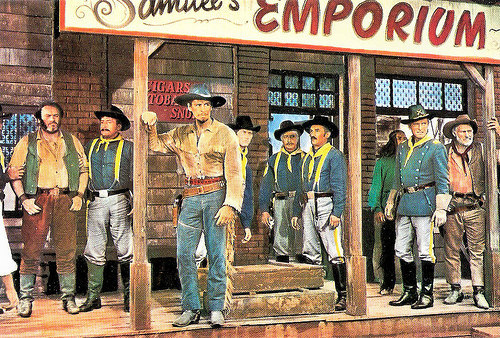
German collectors card by J & M Serienbilder Produktion Saar, no. 46. Photo: Gloria Film. Publicity still for Buffalo Bill, l'eroe del far west/Buffalo Bill, Hero of the Far West (Mario Costa, 1965). Caption: "Der erste Schurke, Big Sam, ist gefasst. Buffalo Bill hat bei ihm die Schiesseisen für die Rothäute gefunden. Big Sam gehört zu den Banditen, auf deren Konto die neunen Kämpfe zwischen Sioux und Weissen kommen." (The first villain, Big Sam is taken. Buffalo Bill has found at his place the firearms for the Redskins. Big Sam is one of the bandits, on whose account comes the new fighting between Sioux and whites.)
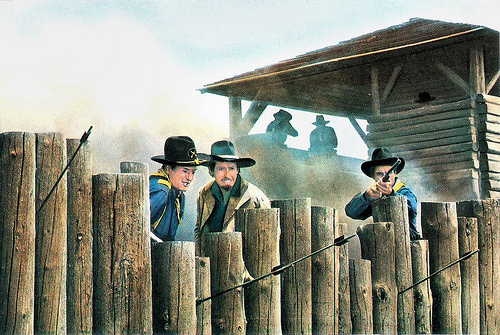
German collectors card by J & M Serienbilder Produktion Saar, no. 51. Photo: Gloria Film. Publicity still for Buffalo Bill, l'eroe del far west/Buffalo Bill, Hero of the Far West (Mario Costa, 1965) with Gordon Douglas. Caption: "'Gelbe Hand' vom Stamm der Sioux sieht seine hinterhältigen Manöver durchschaut. Er holt zum letzten Schlag gegen Fort Adam aus. Die von einem weissen Verräter gelieferten Feuerwaffen, den Buffalo Bill erledigt hat, sollen den Rothäuten den Sieg erkämpfen." ('Yellow Hand' of the tribe of Sioux sees his sneaky maneuver comprehended. He brings out the final blow to Fort Adam. The firearms, delivered by a white traitor, who Buffalo Bill has done in, have to help the Redskins to a victory.)
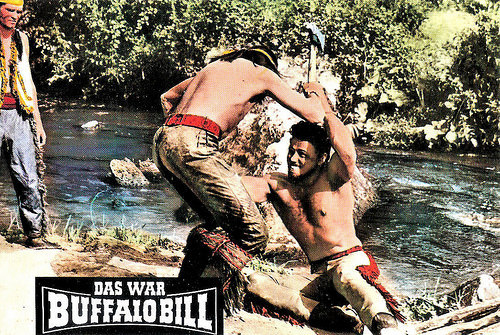
German collectors card by J & M Serienbilder Produktion Saar, no. 67. Photo: Gloria Film. Publicity still for Buffalo Bill, l'eroe del far west/Buffalo Bill, Hero of the Far West (Mario Costa, 1965) with Mirko Ellis and Gordon Scott (at right). Caption: "Wieder beweist der feige Häuptling Gelbe Hand'' im atemberaubenden Zweikampf mit Buffalo Bill seine Heimtücke. Er schmettert den Tomahawk auf den waffenlosen Gegner und deshalb verachten ihn jetzt sogar die eigenen Stammesgenossen." (Again the cowardly chief Yellow Hand hows his maliciousness in a breathtaking duel with Buffalo Bill. He smashes the Tomahawk on his unarmed opponent and therefore even his own tribesmen now despise him.)
Sources: Adam Bernstein (The Washington Post), Brian J. Walker (Brian’s Drive-In Theater), Bill Hillman (ERBzine), Mark Cerulli (Tarzan.cc), Wikipedia, and .

German postcard by Kunst und Bild, no. I 411. Photo: RKO. Publicity still for Tarzan's Hidden Jungle (Harold D. Schuster, 1955).

Italian 'vera fotografia' (real photo) postcard, no. 401. Gordon Scott as Tarzan.

German collectors card by J & M Serienbilder Produktion Saar, no. 68. Photo: Gloria Film. Publicity still for Buffalo Bill, l'eroe del far west/Buffalo Bill, Hero of the Far West (Mario Costa, 1965). Caption: "In einem Zweikampf auf Leben und Tod hat Buffalo Bill, der berühmteste Held des Wilden Westens, seinen gefährlichsten Feind bezwungen. Der edle Kämpfer schenkt seinem Gegner das Leben. Die Indianer selbst sollen seine Strafe bestimmen." (In a duel to the death, Buffalo Bill, the famous hero of the Wild West, has defeated his most dangerous enemy. The noble warrior gives his opponent his life. The Indians themselves have to determine his punishment.)
Handsome features, muscular physique, and imposing height
Gordon Scott was born Gordon Merrill Werschkul in Portland, Oregon, in 1926. He was one of nine children of advertising man Stanley Werschkul and his wife Alice. He was raised in Oregon and studied Physical Education at the University of Oregon for one semester.
Upon leaving school, he joined the U.S. Army in 1944. He served as a drill sergeant and military policeman and specialised in close-order drill, judo and hand-to-hand combat. After his honourable discharge in 1947, he took on a variety of jobs, including fireman, cowboy, and farm-machinery salesman. In 1953 he was working as a lifeguard at the Sahara Hotel in Las Vegas when he was spotted by Hollywood agents, Ed and Walter Mayers. They were impressed by his handsome features, muscular physique, and imposing height.
Scott then beat out 200 contestants to replace Lex Barker as Edgar Rice Burroughs' famous jungle hero Tarzan. Film producer Sol Lesser offered him a 7-year contract, a loincloth and a new last name. Reportedly, ‘Werschkul’ sounded too much like ‘Weissmuller’. Renamed Gordon Scott, he debuted in the low-budget Tarzan’s Hidden Jungle (Harold D. Schuster, 1955).
It led to a romance with co-star Vera Miles, who became his wife in 1956. They divorced in 1959. Tarzan’s Hidden Jungle was followed by Tarzan and the Lost Safari (H. Bruce Humberstone, 1957), the first Tarzan film in colour. It was filmed in Nairobi, British East Africa. In his early Tarzan films, Scott played the character as unworldly and inarticulate, in the mould of Johnny Weissmuller .
In 1958, Sol Lesser sold Scott's contract to Sy Weintraub. The new producer took his star to Paramount Pictures and, fueled by bigger production budgets, made two of the most successful Tarzan films, Tarzan's Greatest Adventure (John Guillermin, 1959) with Anthony Quayle and Sean Connery, and Tarzan the Magnificent (Robert Day, 1960) with Jock Mahoney. In these later films, Scott played a Tarzan who was educated and spoke perfect English, as in the original Edgar Rice Burroughs novels. Gordon Scott was the only actor to play Tarzan in both styles.

German postcard by Kolibri/Friedrich W. Sander-Verlag, Minden/Westf., no. 2322. Photo: Gloria Film. Publicity still for Maciste contro il vampiro/Maciste Vs. the Vampire (Giacomo Gentilomo, 1961).

Small Romanian collectors card. Photo: Gordon Scott and Virna Lisi in Romolo e Remo/Duel of the Titans (Sergio Corbucci, 1961).

Vintage postcard.
Sword-and-sandal epics
Fearing he would become typecast as Tarzan, Gordon Scott moved to Italy. There he became a popular star of the Peplum genre, the sword-and-sandal epics featuring handsome bodybuilders as various characters from Greek and Roman myth.
Scott was an old training buddy of Hercules star Steve Reeves. Reeves had agreed to star in the Sergio Leone-penned saga Romolo e Remo/Duel of the Titans (Sergio Corbucci, 1961) about the two brothers of Roman Mythology, who founded Rome. The producer wanted Reeves to play both Romulus and Remus, but Reeves objected that the film would be more effective with another actor in the role of Remus. He recommended Gordon Scott, and the film co-starred Virna Lisi , Laura Solari, Massimo Girotti and Jacques Sernas . Scott was given the highest salary he had earned thus far for taking the role.
Next followed Maciste alla corte del Gran Khan/Maciste at the Court of the Great Khan (Riccardo Freda, 1961), which re-used the sets, extras and Yoko Tani as a princess from Marco Polo (Piero Pierotti, Hugo Fregonese, 1961) and Freda's I mongoli/The Mongols (André De Toth, Leopoldo Savona, Riccardo Freda, 1961).
Scott played Julius Caesar opposite Pascale Petit as Cleopatra in the historical drama Una regina per Cesare/A Queen for Caesar (Piero Pierotti, Victor Tourjansky, 1962) set in Egypt in 48 BC. Unlike other films about Caesar and Cleopatra, this film focuses entirely on the dynastic struggle within Egypt leading up to the arrival of Caesar, and in fact, we only see him in the closing scene of the film when he arrives at The Ptolemaic Palace in Alexandria. 20th Century Fox bought the rights for the film to keep it out of release lest it competed with their own Cleopatra, featuring Elizabeth Taylor. Scott also played Hercules in a couple of international co-productions during the mid-1960s.

German collectors card by J & M Serienbilder Produktion Saar, no. 34. Photo: Gloria Film. Publicity still for Buffalo Bill, l'eroe del far west/Buffalo Bill, Hero of the Far West (Mario Costa, 1965) with Gordon Douglas. Caption: "Buffalo Bill hat sich auf die Fährte des weissen Waffenhändlers gesetzt, der die Rothäute zum Kampf aufwiegelt. Furchtlos hält Bill eine Übermacht rauher Burschen in Schach." (Buffalo Bill has set himself at the trail of the white arms dealer who incites the redskins to fight. Fearless Bill holds a a superior force of rough boys at bay.)

German collectors card by J & M Serienbilder Produktion Saar, no. 35. Photo: Gloria Film. Publicity still for Buffalo Bill, l'eroe del far west/Buffalo Bill, Hero of the Far West (Mario Costa, 1965) with Gordon Douglas. Caption: "Buffalo Bill, der Held des Wilden Westens ohne Furcht und Tadel, fürchtete selbst die gefährlichtsen Gegner nicht. Er ist entschlossen den illegalen Waffenhändlern das Handwerk zu legen." (Buffalo Bill, the hero of the Wild West without fear and without reproach, did not fear even the most dangerous opponent. He is determined to put down the business of the illegal arms dealers.)

German collectors card by J & M Serienbilder Produktion Saar, no. 43. Photo: Gloria Film. Publicity still for Buffalo Bill, l'eroe del far west/Buffalo Bill, Hero of the Far West (Mario Costa, 1965) with Gordon Douglas. Caption: "Buffalo Bill begibt sich mit seinem Gefährten in die Höhle des Löwen. Als harmloser Gast horcht er in der Bar des Dunkelmannes Monroe herum, um zu erfahren wo die entführte Häuptlingstochter 'Mondstrahl' gefangen gehalten wird." (Buffalo Bill embarks with his companions in the lion's den. As harmless guest he listens around in the bar of the dark man Monroe to find out where 'Moonbeam', the chief's kidnapped daughter, is being held captive.)
Buffalo Bill
As the Peplum genre faded, Gordon Scott starred in other genre films. His first Spaghetti Western was Buffalo Bill, l'eroe del far west/Buffalo Bill, Hero of the Far West (Mario Costa, 1964) with Jan Hendriks .
He also starred in the Eurospy film Il Raggio infernale/Danger!! Death Ray (Gianfranco Baldanello, 1967). It was released at a time when the James Bond films, and spy films in general, were very popular internationally. His early military combat and martial arts training made it possible for him to do many of his own stunts.
His final film appearance was in the Spaghetti Western Gli uomini dal passo pesante/The Tramplers (Albert Band, Mario Sequi, 1966-1968) with Joseph Cotten and Franco Nero . He left Italy and never made another film. He was trailed by a reputation as a ladies' man who seldom paid his bills, according to a 1987 article in the Toronto Star. For the last two decades of his life, Scott was a popular guest at film conventions and autograph shows and sold knives.
In 2007, Gordon Scott died, aged 80, in Baltimore, Maryland, of lingering complications from multiple heart surgeries earlier in the year. Adam Bernstein in his obituary in The Washington Post: “He lived with a series of obliging friends and ‘Tarzan’ fans, most recently in Baltimore. He had a troubled marriage with Miles, who apparently was under the impression that she was his first wife. She was his second or third, by varying accounts. He was seldom in contact with his surviving family, which includes a brother and two sisters. He had a son with Miles, and it's unclear how many other children he might have had. He was estranged from nearly everyone.”
Scott was married three times. His first marriage was with Janice Mae Wynkoop, of Oakland, California. They met when he was a lifeguard at Lake Temescal, located in Oakland, California. The couple married in Reno, Nevada, in 1948, and had one child, Karen Judith Werschkul (1948), before divorcing in 1949. His second marriage was to a woman he met while they were both working at the Sahara Hotel in Las Vegas. Gordon as a lifeguard and his wife as a PBX operator. They soon married and had a son, Eric, but the marriage ended once Gordon's acting career took off. With Vera Miles, he had one son, Michael (1957).

German collectors card by J & M Serienbilder Produktion Saar, no. 46. Photo: Gloria Film. Publicity still for Buffalo Bill, l'eroe del far west/Buffalo Bill, Hero of the Far West (Mario Costa, 1965). Caption: "Der erste Schurke, Big Sam, ist gefasst. Buffalo Bill hat bei ihm die Schiesseisen für die Rothäute gefunden. Big Sam gehört zu den Banditen, auf deren Konto die neunen Kämpfe zwischen Sioux und Weissen kommen." (The first villain, Big Sam is taken. Buffalo Bill has found at his place the firearms for the Redskins. Big Sam is one of the bandits, on whose account comes the new fighting between Sioux and whites.)

German collectors card by J & M Serienbilder Produktion Saar, no. 51. Photo: Gloria Film. Publicity still for Buffalo Bill, l'eroe del far west/Buffalo Bill, Hero of the Far West (Mario Costa, 1965) with Gordon Douglas. Caption: "'Gelbe Hand' vom Stamm der Sioux sieht seine hinterhältigen Manöver durchschaut. Er holt zum letzten Schlag gegen Fort Adam aus. Die von einem weissen Verräter gelieferten Feuerwaffen, den Buffalo Bill erledigt hat, sollen den Rothäuten den Sieg erkämpfen." ('Yellow Hand' of the tribe of Sioux sees his sneaky maneuver comprehended. He brings out the final blow to Fort Adam. The firearms, delivered by a white traitor, who Buffalo Bill has done in, have to help the Redskins to a victory.)

German collectors card by J & M Serienbilder Produktion Saar, no. 67. Photo: Gloria Film. Publicity still for Buffalo Bill, l'eroe del far west/Buffalo Bill, Hero of the Far West (Mario Costa, 1965) with Mirko Ellis and Gordon Scott (at right). Caption: "Wieder beweist der feige Häuptling Gelbe Hand'' im atemberaubenden Zweikampf mit Buffalo Bill seine Heimtücke. Er schmettert den Tomahawk auf den waffenlosen Gegner und deshalb verachten ihn jetzt sogar die eigenen Stammesgenossen." (Again the cowardly chief Yellow Hand hows his maliciousness in a breathtaking duel with Buffalo Bill. He smashes the Tomahawk on his unarmed opponent and therefore even his own tribesmen now despise him.)
Sources: Adam Bernstein (The Washington Post), Brian J. Walker (Brian’s Drive-In Theater), Bill Hillman (ERBzine), Mark Cerulli (Tarzan.cc), Wikipedia, and .
Published on February 04, 2023 22:00
February 3, 2023
Johnny Sheffield
Johnny Sheffield (1931-2010) was one of Hollywood's most famous child stars. He was unforgettable as Tarzan's adopted son Boy in eight Tarzan films starring Johnny Weissmuller. Between 1949 and 1955, he starred in twelve Bomba films for Monogram Pictures.
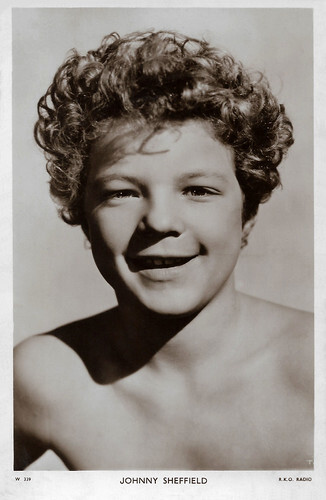
British postcard in the Picturegoer Series, London, no. W 339. Photo: R.K.O. Radio.
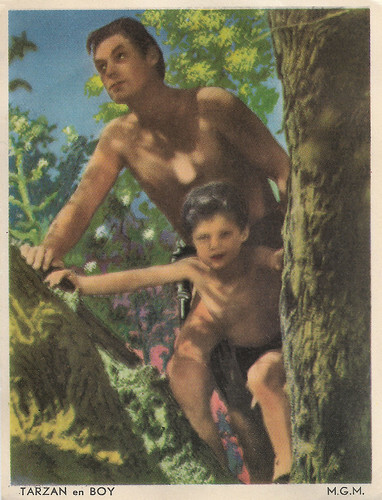
Dutch collectors card. Photo: Metro-Goldwyn-Mayer Pictures. Johnny Weissmuller as Tarzan and Johnny Sheffield as Boy in Tarzan Finds a Son (Richard Thorpe, 1939).
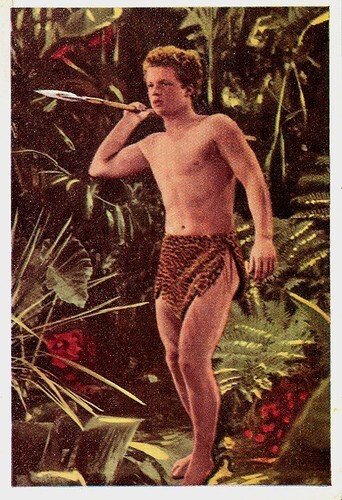
Vintage postcard. Johnny Sheffield in Bomba: The Jungle Boy (Ford Beebe, 1949).
Tarzan finds a son
Johnny Sheffield was born John Matthew Sheffield Cassan in 1931 in Pasadena, California, USA. His father was the actor Reginald Sheffield who began as a child star and later turned to character acting.
In 1938, Sheffield became a child star after he was cast in the juvenile lead of a West Coast production of the highly successful Broadway play 'On Borrowed Time', which starred Dudley Digges and featured Victor Moore as Gramps. The seven-year-old Sheffield played the role of Pud, a long role for a child. He later went to New York as a replacement and performed the role on Broadway.
That year he also played Napoleon's son in the short MGM film The Man on the Rock (Edward L. Cahn, 1938). When Maureen O'Sullivan wanted out of her Jane role in the Johnny Weissmuller Tarzan series, it was decided that she and Tarzan would adopt a son before she died. They had to adopt, according to the Legion of Decency, because they weren't married.
Weissmuller personally selected Sheffield from 300 boys for the part of Boy. The role was inspired by Bobby Nelson's portrayal in Tarzan the Mighty (Jack Nelson, Ray Taylor, 1928). Athletic by nature, little Johnny was taught to swim by swimming Olympian Weissmuller.
Johnny Sheffield's feature debut in Tarzan Finds a Son! (Richard Thorpe, 1939) was such a success that MGM signed him to six more films as Tarzan's Boy. Sheffield played Boy in three Tarzan films at MGM, and in another five after Johnny Weissmuller , and production of the film series moved to RKO. Brenda Joyce played Jane in the last three Tarzan films in which Sheffield appeared.
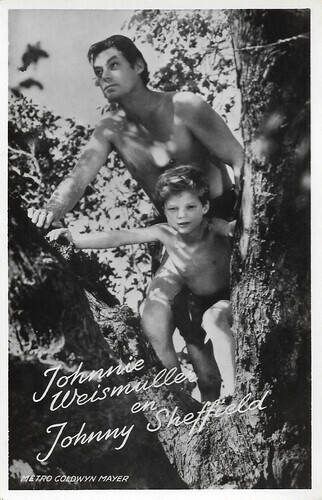
Dutch postcard by Takken, Utrecht, no. 428. Photo: Metro-Goldwyn-Mayer Pictures. Johnny Weismüller and Johnny Sheffield in Tarzan Finds a Son (1939).
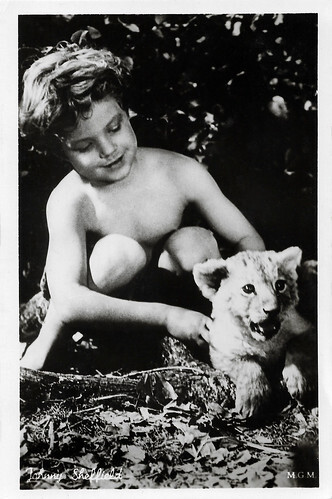
Belgian postcard by Nieuwe Merksemsche Chocolaterie S.P.R.L., Merksem (Anvers). Photo: Metro-Goldwyn-Mayer (MGM).
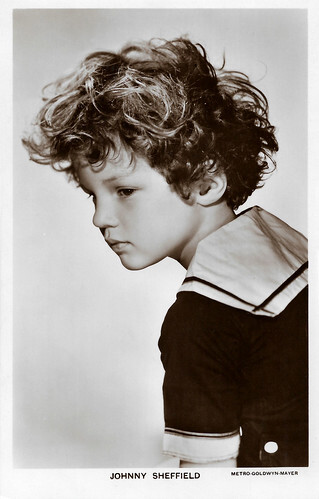
British postcard in the Picturegoer Series, London, no. 1331. Photo: Metro-Goldwyn-Mayer.
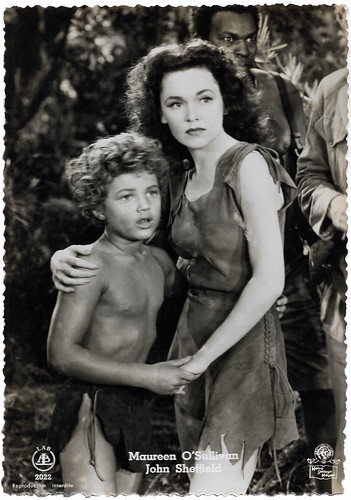
Belgian postcard by Les Editions d'Art L.A.B., Bruxelles, no. 2022. Photo: Metro-Goldwyn-Mayer. Maureen O'Sullivan and Johnny Sheffield in Tarzan's Secret Treasure (Richard Thorpe, 1941).
Bomba, the jungle boy
In between the Tarzan films, Johnny Sheffield played supporting parts in other films. Sheffield appeared in the musical Babes in Arms (Busby Berkeley, 1939) with Mickey Rooney and Judy Garland , classmates of his at the studio school. Johnny and his brother Billy Sheffield were both in Knute Rockne All American (Lloyd Bacon, 1940), playing football player and coach, Knute Rockne at different ages.
By the time of Tarzan and the Mermaids (Robert Florey, 1948), Johnny Sheffield was too big for the part of Boy. The film merely said he was away at school. When Monogram Studios learned Sheffield had been dropped, they picked him up for s series of B-films based on Roy Rockwood's adventure novel 'Bomba'. The first was Bomba: The Jungle Boy (Ford Beebe, 1949). Between 1949 and 1955, Sheffield made twelve Bomba films for 'Poverty Row' studio Monogram Pictures. Sheffield retired from films at age 24 after starring in his twelfth Bomba film Lord of the Jungle (Ford Beebe, 1955).
He then made a pilot for a television series, Bantu the Zebra Boy, which was created, produced, and directed by his father, Reginald Sheffield. Although the production values were high compared to other TV jungle shows of the day, a sponsor was not found and the show was not taken up as a weekly series. In his later years, Sheffield sold bootlegged copies of the pilot to collectors on videotape.
After leaving show business, Sheffield completed a business degree at UCLA. Turning his attention to other fields, he involved himself variously in farming, real estate and construction. For a time, he was a representative for the Santa Monica Seafood Company importing lobsters from Baja California in Mexico.
In 1959 he married his wife Patricia and they would have three children, Stewart, Regina and Patrick Sheffield. In 2010, Johnny suffered a fatal heart attack at his home in Chula Vista, California, four hours after he fell off a ladder while pruning a palm tree. Sheffield was 79. His brother Billy Sheffield died two months later.
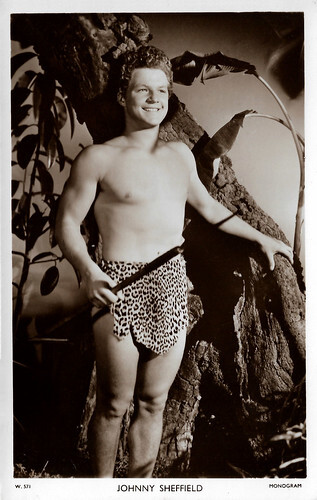
British postcard in the Picturegoer Series, London, no. W 571. Photo: Monogram. Johnny Sheffield in Bomba: The Jungle Boy (Ford Beebe, 1949).
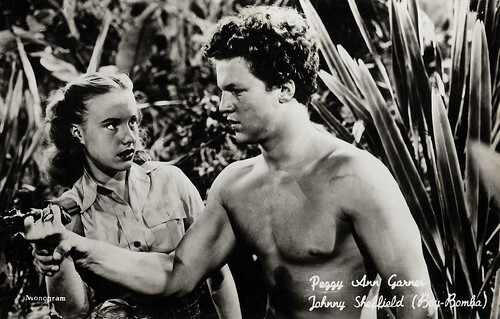
Vintage card. Photo: Monogram. Peggy Ann Garner and Johnny Sheffield in Bomba: The Jungle Boy (Ford Beebe, 1949).
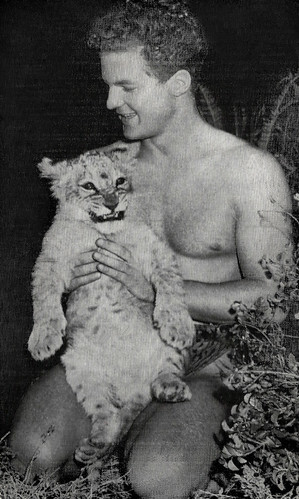
American postcard. Photo: Monogram. Johnny Sheffield as Bomba, the Jungle Boy.
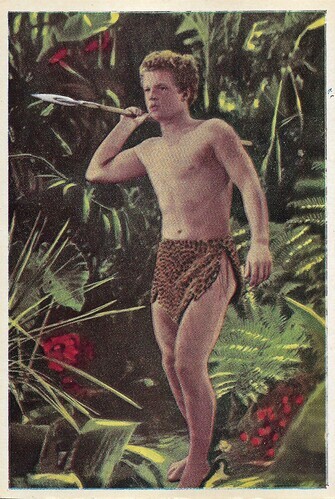
Belgian collectors card, Series KF, no. 12. Photo: Monogram. Johnny Sheffield in Bomba: The Jungle Boy (Ford Beebe, 1949).
Sources: (IMDb), Find A Grave, Wikipedia and .

British postcard in the Picturegoer Series, London, no. W 339. Photo: R.K.O. Radio.

Dutch collectors card. Photo: Metro-Goldwyn-Mayer Pictures. Johnny Weissmuller as Tarzan and Johnny Sheffield as Boy in Tarzan Finds a Son (Richard Thorpe, 1939).

Vintage postcard. Johnny Sheffield in Bomba: The Jungle Boy (Ford Beebe, 1949).
Tarzan finds a son
Johnny Sheffield was born John Matthew Sheffield Cassan in 1931 in Pasadena, California, USA. His father was the actor Reginald Sheffield who began as a child star and later turned to character acting.
In 1938, Sheffield became a child star after he was cast in the juvenile lead of a West Coast production of the highly successful Broadway play 'On Borrowed Time', which starred Dudley Digges and featured Victor Moore as Gramps. The seven-year-old Sheffield played the role of Pud, a long role for a child. He later went to New York as a replacement and performed the role on Broadway.
That year he also played Napoleon's son in the short MGM film The Man on the Rock (Edward L. Cahn, 1938). When Maureen O'Sullivan wanted out of her Jane role in the Johnny Weissmuller Tarzan series, it was decided that she and Tarzan would adopt a son before she died. They had to adopt, according to the Legion of Decency, because they weren't married.
Weissmuller personally selected Sheffield from 300 boys for the part of Boy. The role was inspired by Bobby Nelson's portrayal in Tarzan the Mighty (Jack Nelson, Ray Taylor, 1928). Athletic by nature, little Johnny was taught to swim by swimming Olympian Weissmuller.
Johnny Sheffield's feature debut in Tarzan Finds a Son! (Richard Thorpe, 1939) was such a success that MGM signed him to six more films as Tarzan's Boy. Sheffield played Boy in three Tarzan films at MGM, and in another five after Johnny Weissmuller , and production of the film series moved to RKO. Brenda Joyce played Jane in the last three Tarzan films in which Sheffield appeared.

Dutch postcard by Takken, Utrecht, no. 428. Photo: Metro-Goldwyn-Mayer Pictures. Johnny Weismüller and Johnny Sheffield in Tarzan Finds a Son (1939).

Belgian postcard by Nieuwe Merksemsche Chocolaterie S.P.R.L., Merksem (Anvers). Photo: Metro-Goldwyn-Mayer (MGM).

British postcard in the Picturegoer Series, London, no. 1331. Photo: Metro-Goldwyn-Mayer.

Belgian postcard by Les Editions d'Art L.A.B., Bruxelles, no. 2022. Photo: Metro-Goldwyn-Mayer. Maureen O'Sullivan and Johnny Sheffield in Tarzan's Secret Treasure (Richard Thorpe, 1941).
Bomba, the jungle boy
In between the Tarzan films, Johnny Sheffield played supporting parts in other films. Sheffield appeared in the musical Babes in Arms (Busby Berkeley, 1939) with Mickey Rooney and Judy Garland , classmates of his at the studio school. Johnny and his brother Billy Sheffield were both in Knute Rockne All American (Lloyd Bacon, 1940), playing football player and coach, Knute Rockne at different ages.
By the time of Tarzan and the Mermaids (Robert Florey, 1948), Johnny Sheffield was too big for the part of Boy. The film merely said he was away at school. When Monogram Studios learned Sheffield had been dropped, they picked him up for s series of B-films based on Roy Rockwood's adventure novel 'Bomba'. The first was Bomba: The Jungle Boy (Ford Beebe, 1949). Between 1949 and 1955, Sheffield made twelve Bomba films for 'Poverty Row' studio Monogram Pictures. Sheffield retired from films at age 24 after starring in his twelfth Bomba film Lord of the Jungle (Ford Beebe, 1955).
He then made a pilot for a television series, Bantu the Zebra Boy, which was created, produced, and directed by his father, Reginald Sheffield. Although the production values were high compared to other TV jungle shows of the day, a sponsor was not found and the show was not taken up as a weekly series. In his later years, Sheffield sold bootlegged copies of the pilot to collectors on videotape.
After leaving show business, Sheffield completed a business degree at UCLA. Turning his attention to other fields, he involved himself variously in farming, real estate and construction. For a time, he was a representative for the Santa Monica Seafood Company importing lobsters from Baja California in Mexico.
In 1959 he married his wife Patricia and they would have three children, Stewart, Regina and Patrick Sheffield. In 2010, Johnny suffered a fatal heart attack at his home in Chula Vista, California, four hours after he fell off a ladder while pruning a palm tree. Sheffield was 79. His brother Billy Sheffield died two months later.

British postcard in the Picturegoer Series, London, no. W 571. Photo: Monogram. Johnny Sheffield in Bomba: The Jungle Boy (Ford Beebe, 1949).

Vintage card. Photo: Monogram. Peggy Ann Garner and Johnny Sheffield in Bomba: The Jungle Boy (Ford Beebe, 1949).

American postcard. Photo: Monogram. Johnny Sheffield as Bomba, the Jungle Boy.

Belgian collectors card, Series KF, no. 12. Photo: Monogram. Johnny Sheffield in Bomba: The Jungle Boy (Ford Beebe, 1949).
Sources: (IMDb), Find A Grave, Wikipedia and .
Published on February 03, 2023 22:00
February 2, 2023
Larry 'Buster' Crabbe
American film star Larry 'Buster' Crabbe (1908-1983) was also a two-time Olympic swimmer. He was the only actor who played Flash Gordon, Buck Rogers and Tarzan - the top three pulp heroes of the 1930s.

Big German card by Ross Verlag. Photo: Paramount. Buster Crabbe in Tarzan the Fearless (Robert F. Hill, 1933).

French postcard by Europe, no. 2111.

French postcard by A.N., Paris, no. 948. Photo: Paramount.
From Tarzan to Flash Gordon
Clarence Linden Crabbe was born in 1908 in Oakland, California, USA. He was the son of Edward Clinton Crabbe, a real estate broker, and his wife Agnes Lucy McNamara. "Larry" attended and graduated from Punahou School in Honolulu, Hawaii in 1927 and graduated from the University of Southern California. He was the school's first All-American swimmer (1931) and a 1931 NCAA freestyle titlist. The talented swimmer was on the 1928 and 1932 United States Olympic swimming teams. Crabbe won a bronze medal in the 1500 Meter Freestyle at Amsterdam in 1928. He won also a gold medal in the 400 Meter Swimming Freestyle at the 1932 Summer Olympics in Los Angeles. He broke the record held by another actor-athlete, Johnny Weissmuller .
The Olympic success launched his career on the silver screen. In 1931, while working on That's My Boy (Roy William Neill, 1932) for Columbia Pictures, Larry was tested by MGM for Tarzan but rejected. Paramount Pictures put him instead in King of the Jungle (H. Bruce Humberstone, Max Marcin, 1933) as Kaspa, the Lion Man. The film was based on a book of that title but clearly a copy of the Tarzan stories. Publicity for this film emphasised his having won the 1932 Olympic 400-meter freestyle swimming championship and suggested a rivalry with Johnny Weissmuller .
Producer Sol Lesser wanted Crabbe for the independent film Tarzan the Fearless (Robert F. Hill, 1933), though he first had to get James Pierce to waive rights to the part already promised to him by his father-in-law, Edgar Rice Burroughs. The film was released as both a feature and a serial. Most houses showed only the first serial episode, which critics panned as a badly organised feature.
Just prior to the film's release, Larry married his college sweetheart and gave himself one year to either make it as an actor or start law school at USC. He starred in several popular films, including The Sweetheart of Sigma Chi (Edwin L. Marin, 1933) with Betty Grable , and Search for Beauty (Erle C. Kenton, 1934) with Ida Lupino . Paramount also put him in a number of Zane Grey Westerns.
Then Universal Pictures gave him the lead in the very successful Sci-Fi serial Flash Gordon (Frederick Stephani, 1936). He bleached his hair and changed his name to Buster when he became 'Flash'. He starred in three Flash Gordon serials: Flash Gordon (Frederick Stephani, 1936), Flash Gordon's Trip to Mars (Ford Beebe, Robert F. Hill, 1938) and Flash Gordon Conquers the Universe (Ford Beebe, Ray Taylor, 1940). He was also the star of another popular serial, Buck Rogers (Ford Beebe, Saul A. Goodkind, 1939). That year, he also starred again with Betty Grable in the comedy hit Million Dollar Legs (Nick Grinde, 1939).

Spanish collectors card by Ferber y Blay, no. 3 of 15 cromos. Photo: Sol Lesser Productions. Buster Crabbe in Tarzan the Fearless (Robert F. Hill, 1933). The Spanish release title was Tarzan de la las fieras.
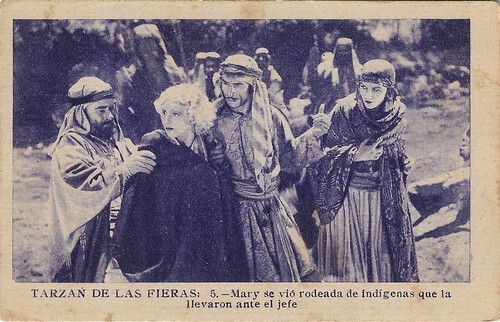
Spanish collectors card by Ferber y Blay, no. 5 of 15 cromos. Photo: Sol Lesser Productions. Julie Bishop as Mary in Tarzan the Fearless (Robert F. Hill, 1933). The Spanish release title was Tarzan de la las fieras.
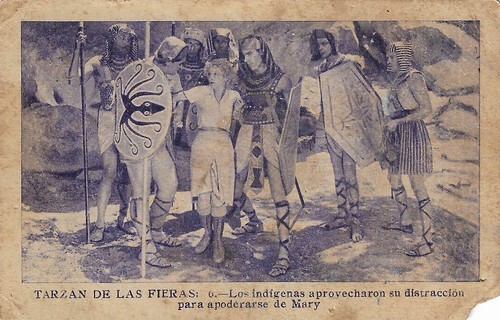
Spanish collectors card by Ferber y Blay, no. 6 of 15 cromos. Photo: Sol Lesser Productions. Julie Bishop as Mary in Tarzan the Fearless (Robert F. Hill, 1933). The Spanish release title was Tarzan de la las fieras.
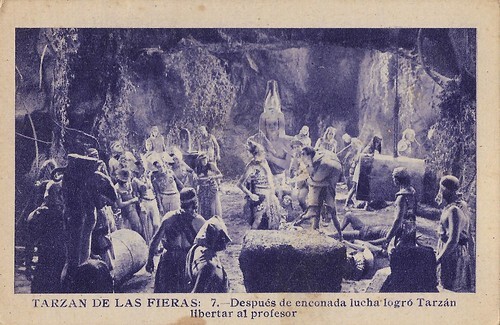
Spanish collectors card by Ferber y Blay, no. 7 of 15 cromos. Photo: Sol Lesser Productions. Buster Crabbe in Tarzan the Fearless (Robert F. Hill, 1933). The Spanish release title was Tarzan de la las fieras.
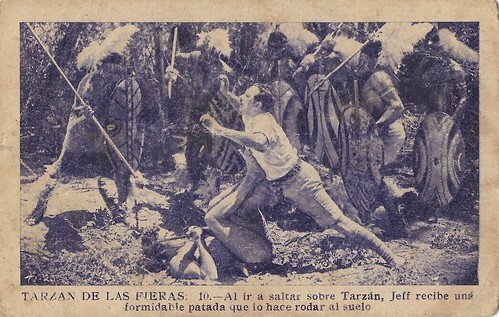
Spanish collectors card by Ferber y Blay, no. 10 of 15 cromos. Photo: Sol Lesser Productions. Buster Crabbe in Tarzan the Fearless (Robert F. Hill, 1933). The Spanish release title was Tarzan de la las fieras.
Billy the Kid and Billy Carson
In 1940, Buster Crabbe began a string of Billy the Kid Westerns for low-budget studio PRC. The first was Billy the Kid Wanted (Sam Newfield, 1941). He played Billy the Kid in 13 films, and then Billy Carson in 23 films. His counterpart in most of these Westerns was Al St. John.
After World War II, Crabbe appeared opposite Johnny Weissmuller as a rival in two jungle films, Swamp Fire (William H. Pine, 1946) and Captive Girl (William Berke, 1950). He devoted much of his time to his Southern California swimming pool-building company and the operation of a boys' camp in New York. In 1950, he made the serials Pirates of the High Seas (Spencer Gordon Bennet, Thomas Carr, 1950) and King of the Congo (Spencer Gordon Bennet, Wallace Grissell, 1952).
In addition, he was very active on television in the 1950s. In 1953, he hosted a local show in New York City that featured his serials. He played the title role in the adventure series Captain Gallant of the Foreign Legion (1955). His real-life son, Cullen Crabbe, appeared in the series as the character "Cuffy Sanders". During television's 'Golden Age', he had several 'meaty' lead roles on such weekly anthology series as Kraft Theater and Philco Television Playhouse.
He later returned to Western features to play Wyatt Earp in Badman's Country (Fred F. Sears, 1958) and gave a stellar performance. In the 1970s, he was the commercial spokesperson for Continental Airlines. He also kept swimming. In 1971, Crabbe broke the world swimming record for the over-sixties in the 400-meter freestyle. He also authored 'Energetics', a book on physical fitness for people over 50. In 1979, he appeared in an episode of the TV series Buck Rogers in the 25th Century. He played a retired fighter pilot named "Brigadier Gordon", in honour of Flash Gordon.
Crabbe later returned to the screen for a large role in The Alien Dead (Fred Olen Ray, 1980). In 1982, he could still be seen in the film The Comeback Trail (Harry Hurwitz, 1982) with Chuck McCann. It was his last role. In 1983, Buster Crabbe died at age 75 of a heart attack after tripping over a wastebasket in his home in Scottsdale, Arizona. Crabbe was married to Adah Virginia Held from 1933 till his death. They had three children, Cullen, Sande and Susan Crabbe. Sande died of anorexia nervosa aged 20.
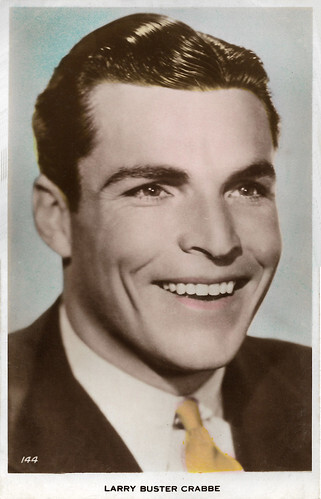
British Art Photo postcard, no. 144.
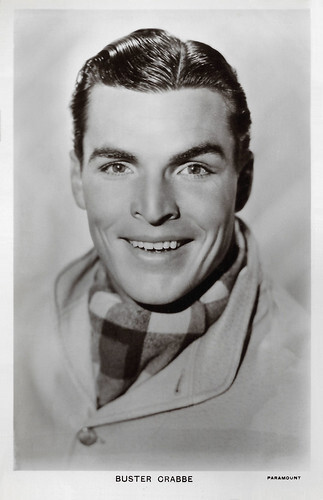
British postcard in the Picturegoer Series, London, no. 794a. Photo: Paramount.
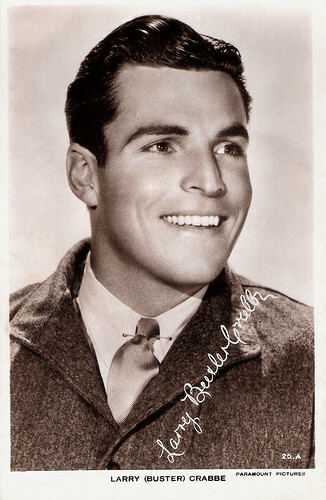
British Real Photograph postcard, no. 20 A. Photo: Paramount Pictures. Sent by mail in 1942.
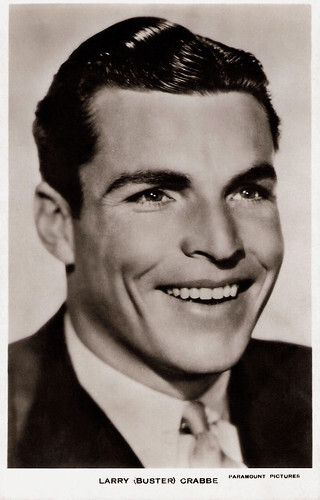
British Real Photograph postcard. Photo: Paramount Pictures.
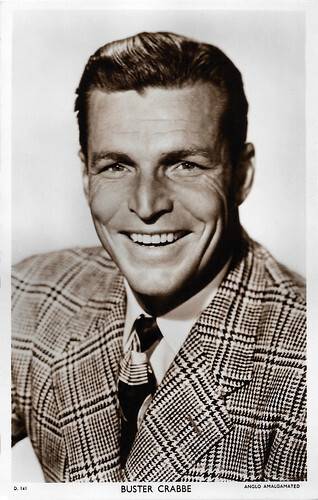
British postcard in the Picturegoer Series, London, no. D. 141. Photo: Anglo Amalgamated.
Sources: (IMDb), Wikipedia (Dutch and English) and .

Big German card by Ross Verlag. Photo: Paramount. Buster Crabbe in Tarzan the Fearless (Robert F. Hill, 1933).

French postcard by Europe, no. 2111.

French postcard by A.N., Paris, no. 948. Photo: Paramount.
From Tarzan to Flash Gordon
Clarence Linden Crabbe was born in 1908 in Oakland, California, USA. He was the son of Edward Clinton Crabbe, a real estate broker, and his wife Agnes Lucy McNamara. "Larry" attended and graduated from Punahou School in Honolulu, Hawaii in 1927 and graduated from the University of Southern California. He was the school's first All-American swimmer (1931) and a 1931 NCAA freestyle titlist. The talented swimmer was on the 1928 and 1932 United States Olympic swimming teams. Crabbe won a bronze medal in the 1500 Meter Freestyle at Amsterdam in 1928. He won also a gold medal in the 400 Meter Swimming Freestyle at the 1932 Summer Olympics in Los Angeles. He broke the record held by another actor-athlete, Johnny Weissmuller .
The Olympic success launched his career on the silver screen. In 1931, while working on That's My Boy (Roy William Neill, 1932) for Columbia Pictures, Larry was tested by MGM for Tarzan but rejected. Paramount Pictures put him instead in King of the Jungle (H. Bruce Humberstone, Max Marcin, 1933) as Kaspa, the Lion Man. The film was based on a book of that title but clearly a copy of the Tarzan stories. Publicity for this film emphasised his having won the 1932 Olympic 400-meter freestyle swimming championship and suggested a rivalry with Johnny Weissmuller .
Producer Sol Lesser wanted Crabbe for the independent film Tarzan the Fearless (Robert F. Hill, 1933), though he first had to get James Pierce to waive rights to the part already promised to him by his father-in-law, Edgar Rice Burroughs. The film was released as both a feature and a serial. Most houses showed only the first serial episode, which critics panned as a badly organised feature.
Just prior to the film's release, Larry married his college sweetheart and gave himself one year to either make it as an actor or start law school at USC. He starred in several popular films, including The Sweetheart of Sigma Chi (Edwin L. Marin, 1933) with Betty Grable , and Search for Beauty (Erle C. Kenton, 1934) with Ida Lupino . Paramount also put him in a number of Zane Grey Westerns.
Then Universal Pictures gave him the lead in the very successful Sci-Fi serial Flash Gordon (Frederick Stephani, 1936). He bleached his hair and changed his name to Buster when he became 'Flash'. He starred in three Flash Gordon serials: Flash Gordon (Frederick Stephani, 1936), Flash Gordon's Trip to Mars (Ford Beebe, Robert F. Hill, 1938) and Flash Gordon Conquers the Universe (Ford Beebe, Ray Taylor, 1940). He was also the star of another popular serial, Buck Rogers (Ford Beebe, Saul A. Goodkind, 1939). That year, he also starred again with Betty Grable in the comedy hit Million Dollar Legs (Nick Grinde, 1939).

Spanish collectors card by Ferber y Blay, no. 3 of 15 cromos. Photo: Sol Lesser Productions. Buster Crabbe in Tarzan the Fearless (Robert F. Hill, 1933). The Spanish release title was Tarzan de la las fieras.

Spanish collectors card by Ferber y Blay, no. 5 of 15 cromos. Photo: Sol Lesser Productions. Julie Bishop as Mary in Tarzan the Fearless (Robert F. Hill, 1933). The Spanish release title was Tarzan de la las fieras.

Spanish collectors card by Ferber y Blay, no. 6 of 15 cromos. Photo: Sol Lesser Productions. Julie Bishop as Mary in Tarzan the Fearless (Robert F. Hill, 1933). The Spanish release title was Tarzan de la las fieras.

Spanish collectors card by Ferber y Blay, no. 7 of 15 cromos. Photo: Sol Lesser Productions. Buster Crabbe in Tarzan the Fearless (Robert F. Hill, 1933). The Spanish release title was Tarzan de la las fieras.

Spanish collectors card by Ferber y Blay, no. 10 of 15 cromos. Photo: Sol Lesser Productions. Buster Crabbe in Tarzan the Fearless (Robert F. Hill, 1933). The Spanish release title was Tarzan de la las fieras.
Billy the Kid and Billy Carson
In 1940, Buster Crabbe began a string of Billy the Kid Westerns for low-budget studio PRC. The first was Billy the Kid Wanted (Sam Newfield, 1941). He played Billy the Kid in 13 films, and then Billy Carson in 23 films. His counterpart in most of these Westerns was Al St. John.
After World War II, Crabbe appeared opposite Johnny Weissmuller as a rival in two jungle films, Swamp Fire (William H. Pine, 1946) and Captive Girl (William Berke, 1950). He devoted much of his time to his Southern California swimming pool-building company and the operation of a boys' camp in New York. In 1950, he made the serials Pirates of the High Seas (Spencer Gordon Bennet, Thomas Carr, 1950) and King of the Congo (Spencer Gordon Bennet, Wallace Grissell, 1952).
In addition, he was very active on television in the 1950s. In 1953, he hosted a local show in New York City that featured his serials. He played the title role in the adventure series Captain Gallant of the Foreign Legion (1955). His real-life son, Cullen Crabbe, appeared in the series as the character "Cuffy Sanders". During television's 'Golden Age', he had several 'meaty' lead roles on such weekly anthology series as Kraft Theater and Philco Television Playhouse.
He later returned to Western features to play Wyatt Earp in Badman's Country (Fred F. Sears, 1958) and gave a stellar performance. In the 1970s, he was the commercial spokesperson for Continental Airlines. He also kept swimming. In 1971, Crabbe broke the world swimming record for the over-sixties in the 400-meter freestyle. He also authored 'Energetics', a book on physical fitness for people over 50. In 1979, he appeared in an episode of the TV series Buck Rogers in the 25th Century. He played a retired fighter pilot named "Brigadier Gordon", in honour of Flash Gordon.
Crabbe later returned to the screen for a large role in The Alien Dead (Fred Olen Ray, 1980). In 1982, he could still be seen in the film The Comeback Trail (Harry Hurwitz, 1982) with Chuck McCann. It was his last role. In 1983, Buster Crabbe died at age 75 of a heart attack after tripping over a wastebasket in his home in Scottsdale, Arizona. Crabbe was married to Adah Virginia Held from 1933 till his death. They had three children, Cullen, Sande and Susan Crabbe. Sande died of anorexia nervosa aged 20.

British Art Photo postcard, no. 144.

British postcard in the Picturegoer Series, London, no. 794a. Photo: Paramount.

British Real Photograph postcard, no. 20 A. Photo: Paramount Pictures. Sent by mail in 1942.

British Real Photograph postcard. Photo: Paramount Pictures.

British postcard in the Picturegoer Series, London, no. D. 141. Photo: Anglo Amalgamated.
Sources: (IMDb), Wikipedia (Dutch and English) and .
Published on February 02, 2023 22:00
February 1, 2023
Johnny Weissmuller
Hungarian-born American competition swimmer and actor Johnny Weissmuller (1904-1984) is best known for playing Tarzan in films of the 1930s and 1940s. Weissmuller was one of the world's fastest swimmers in the 1920s, winning five Olympic gold medals for swimming and one bronze medal for water polo. After his swimming career, he became the sixth actor to portray Edgar Rice Burroughs's ape man, Tarzan, a role he played in twelve films. The first was Tarzan the Apeman (W. S. Van Dyke, 1932) with Maureen O'Sullivan as Jane. Dozens of other actors have also played Tarzan, but Weissmuller is forever the best-known. His character's distinctive Tarzan yell is still often used in films. But who did that yell actually?
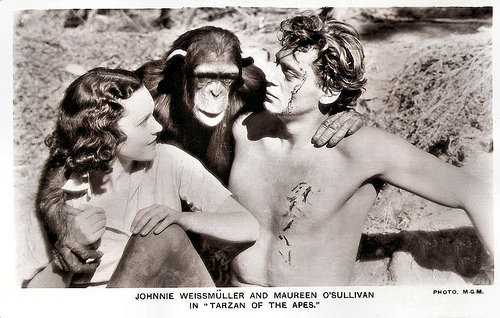
British postcard in the Picturegoer Series, no. 680. Photo: M.G.M. Publicity still for Tarzan the Ape Man (W. S. Van Dyke, 1932) with Maureen O'Sullivan , Cheeta and Johnny Weissmuller.
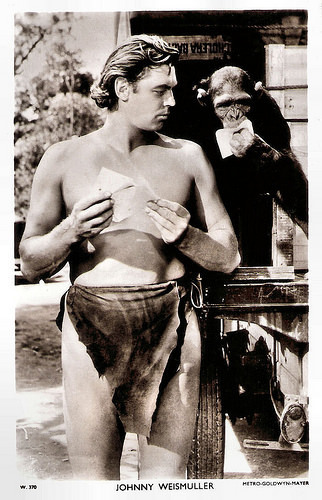
British postcard in the Picturegoer series, London, no. W 370. Photo: Metro-Goldwyn-Mayer.
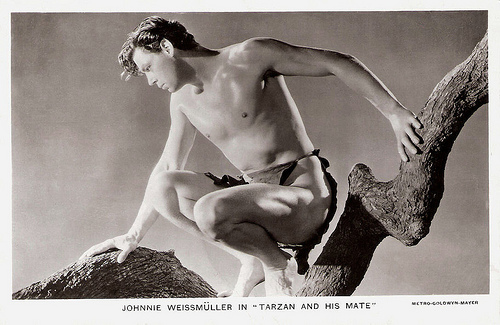
British postcard in the Picturegoer Series, London, no. 864. Photo: Metro-Goldwyn-Mayer. Publicity still for Tarzan and his Mate (W. S. Van Dyke, 1934).
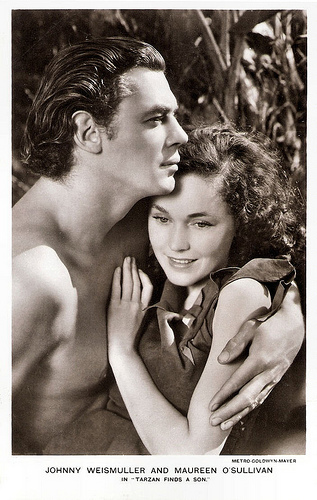
British postcard by Real Photograph, London, no. FS 208. Photo: Metro-Goldwyn-Mayer (MGM). Publicity still for Tarzan Finds A Son (Richard Thorpe, 1939) with Johnny Weissmuller and Maureen O'Sullivan .
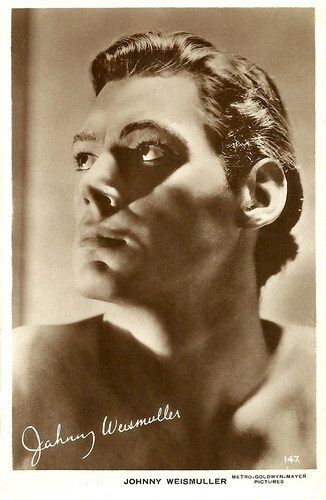
British postcard by Milton, no. 147. Photo: Metro-Goldwyn-Mayer Pictures.
An adonis clad only in a fig leaf
In 1904, Johnny Weissmuller was born as Peter Johann Weißmüller in Freidorf, today Szabadfalva, in the district of the city of Timisoara in Romania, then a part of the Austro-Hungarian Empire. Weissmuller would later claim to have been born in Windber, Pennsylvania, probably to ensure his eligibility to compete as part of the US Olympic team. Weissmüller was one of two boys born to Petrus Weissmuller, a miner, and his wife Elisabeth Kersch, who were both Banat Swabians, an ethnic German population in Southeast Europe. The family arrived in the United States in 1905 when Johnny was 7 months old.
At age nine, young John Weissmüller contracted polio. He took up swimming on the advice of a doctor. After school, he worked as a bellhop and elevator operator at the Plaza Hotel in Chicago and trained for the Olympics with a swim coach at the Illinois Athletic Club. There he developed his revolutionary high-riding front crawl. He made his amateur debut in 1921, winning his first AAU race in the 50-yard freestyle.
From 1921 till 1929 Weismuller won every freestyle race he entered, from 100 yards to the half-mile. He won 67 world titles and 52 national titles. At the Olympic Games of 1924 and 1928, he won 5 Gold Medals and broke the record in each race. In 1929, Weissmuller signed a contract with BVD to be a model and representative. He travelled throughout the country doing swim shows, handing out leaflets promoting that brand of swimwear, signing autographs and going on the radio. That year he made his film debut in Glorifying the American Girl (John W. Harkrider, Millard Webb, 1929), appearing as an Adonis clad only in a fig leaf in the segment Loveland.
After great success with a jungle movie, MGM head Louis B. Mayer, via Irving Thalberg, optioned two of Edgar Rice Burroughs' Tarzan stories. Cyril Hume, working on the adaptation of Tarzan the Ape Man (W.S. Van Dyke, 1932), noticed Johnny Weissmuller swimming in the pool at his hotel and suggested him for the part of Tarzan. MGM got him released from his BVD contract by agreeing to pose for many of its female stars in BVD swimsuits. Weissmuller signed a seven-year contract with Metro-Goldwyn-Mayer
The studio billed him as "the only man in Hollywood who's natural in the flesh and can act without clothes". The film was an immediate box office and critical hit. And Weissmuller became an overnight international sensation. Seeing that he was wildly popular with girls, the studio told him to divorce his wife and paid her $10,000 to agree to it. Weissmuller starred in six Tarzan movies for MGM with actress Maureen O'Sullivan as Jane and Cheeta the Chimpanzee. The last three also included Johnny Sheffield as Boy.
After 1942, however, MGM had used up its options; it dropped the Tarzan series and Weissmuller, too. He then moved to RKO and made six more Tarzans with markedly reduced production values. Sheffield also appeared as Boy in the first five features for RKO. Brenda Joyce took over the role of Jane in Weissmuller's last four Tarzan movies (the first two RKO films had not featured Jane). Unlike MGM, RKO allowed Weissmuller to play other roles, though a three-picture contract with Pine-Thomas Productions led to only one film, Swamp Fire (William H. Pine, 1946), co-starring Virginia Grey and Buster Crabbe.
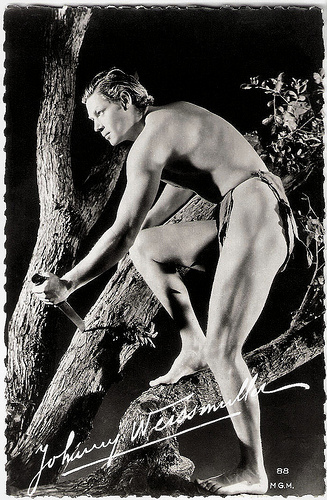
French postcard by Editions en Publications Cinematographiques, no. 88. Photo: Metro-Goldwyn-Mayer.
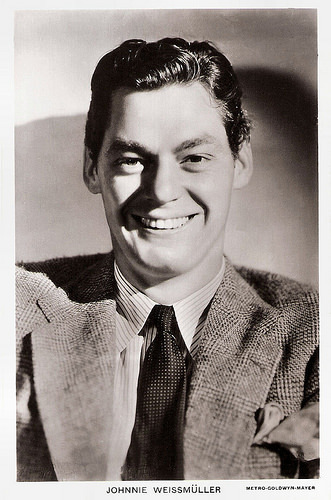
British postcard in the Picturegoer series, London, no. 668b. Photo: Metro-Goldwyn-Mayer.
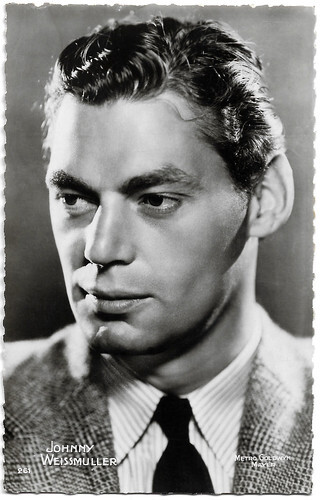
French postcard, no. 261. Photo: Metro-Goldwyn-Mayer (M.G.M).
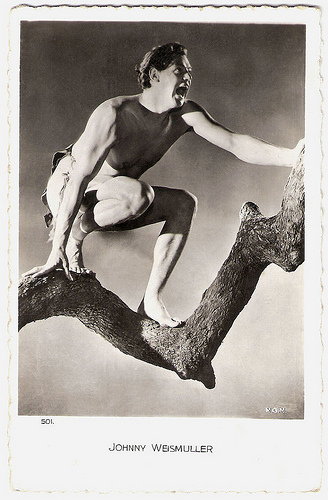
French postcard by Ed. Chantal, Paris no. 501. Photo: M.G.M.
International swimming hall of fame
After his Tarzan career was over, Johnny Weissmuller traded his loincloth costume for a slouch hat and safari suit for the role of Jungle Jim (William Berke, 1948), set in Africa. He made sixteen Jungle Jim films for Columbia between 1948 and 1954. Devil Goddess (Spencer G. Bennet, 1955) was the last entry in the series, as well as being Weissmuller's last feature film.
In 1955, he began production of the Jungle Jim television adventure series for Screen Gems, a film subsidiary of Columbia. The show produced only twenty-six episodes, which were subsequently played repeatedly on the network and syndicated television. Aside from his first screen appearance as Adonis in Glorifying the American Girl (1929) and the role of Johnny Duval in Swamp Fire (1946), Weissmuller played only three roles in films during the heyday of his Hollywood career: Tarzan, Jungle Jim, and himself. In the late 1950s after retiring from acting, Weissmuller moved back to Chicago and started a swimming pool company. He also lent his name to other business ventures, but did not have a great deal of success. He retired in 1965 and moved to Fort Lauderdale, Florida, where he was the Founding Chairman of the International Swimming Hall of Fame.
In 1970, he made a cameo appearance with his former Tarzan co-star Maureen O'Sullivan in the obscure comedy The Phynx (Lee H. Katzin, 1970). In 1973, he moved from Florida to Las Vegas where he was a greeter at the MGM Grand Hotel for a time. In 1974, he broke a hip and leg. While hospitalised he learned that, in spite of his strength and a lifelong daily regimen of swimming and exercise, he had a serious heart condition.
In 1976, he appeared for the last time in a film as a crewman who is fired by a movie mogul (Art Carney) in Won Ton Ton, the Dog Who Saved Hollywood (Michael Winner, 1976), and he also made his final public appearance in that year when he was inducted into the Body Building Guild Hall of Fame. In 1984, 'Big John' Weissmuller died in Acapulco, Mexico of pulmonary oedema after a series of strokes. At his request, a recording of his trademark Tarzan yell which he invented was played as his coffin was lowered into the ground.
He married five times and divorced four times. His wives were the band and club singer Bobbe Arnst (1931-1933), Mexican film star Lupe Velez (1933-1939), Beryl Scott (1939-1948), Ailene Gates (1948-1962) and Maria Bauman (1963-1984; his death). He had three children with Beryl Scott: actor Johnny Weissmuller Jr. (1940-2006), Wendy Anne (1942), and Heidi Elizabeth (1943-1962). His daughter Heidi died in a car crash. She had been driving south along the Pacific Coast Highway, on the way to return her husband and a friend to the naval base in San Diego where they were stationed. A few miles north of Laguna Beach, she fell asleep at the wheel and crashed. Heidi and her unborn child died. Her husband and his friend survived. According to his son, Weissmuller never got over the loss of his daughter and unborn grandchild.
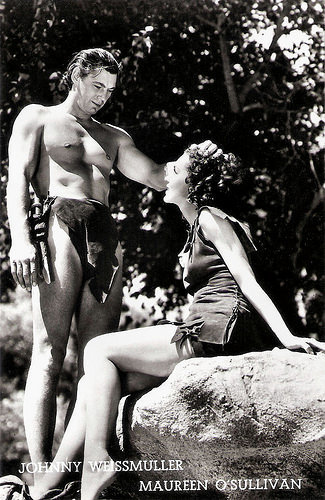
Belgian postcard. Photo: M.G.M. Johnny Weissmuller and Maureen O'Sullivan .
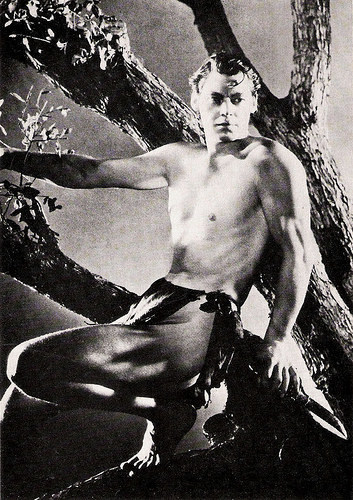
Vintage postcard.
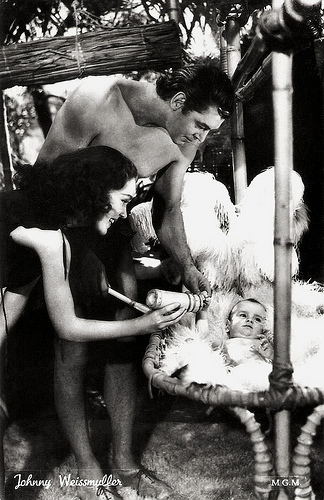
Vintage card. Photo: M.G.M. Publicity still for Tarzan Finds a Son! (Richard Thorpe, 1939) with Johnny Weissmuller and Maureen O'Sullivan .

Dutch postcard by Takken, Utrecht, no. 428. Photo: Metro-Goldwyn-Mayer Pictures. Johnny Weismüller and Johnny Sheffield in Tarzan Finds a Son (1939).
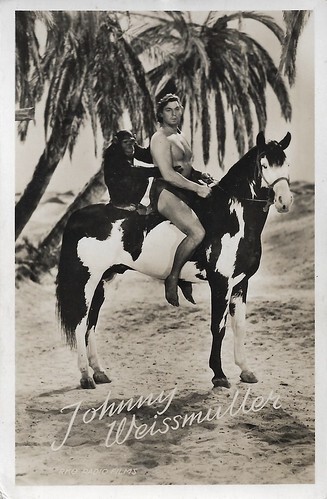
Dutch postcard by Film en Toneel, no. 3457.
Who did the yell in the Tarzan films?
According to Johnny Weissmuller he did the yell himself and he was inspired by the yodelling of his German neighbours, along with his own success in a yodelling contest he’d won as a boy.
However, MGM claimed to have enhanced the yell in post-production. Reportedly, they added and mixed the following:
1. A second track of Weismuller’s voice, amplified
2. A track of a hyena howl, played backwards
3. A note sung by a female opera soprano, with the speed varied to produce a fluttery sound
4. The growl of a dog
5. The bleat of a camel
6. The raspy note of a violin’s G-string being bowed.
And there are more stories...
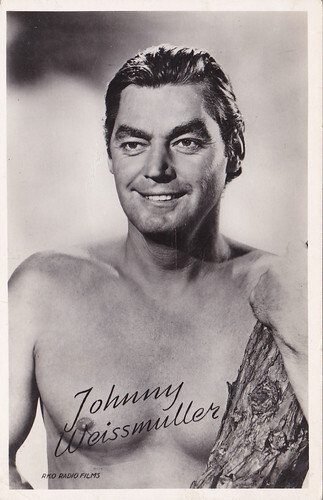
Dutch postcard by Archief Film en Toneel, no. 3458. Photo: RKO Radio Films. Johnny Weissmuller. Collection: Carla Bosch.
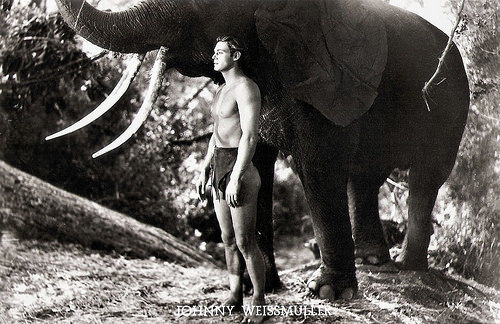
Dutch postcard, no. 751. Photo: M.G.M.
Trailer for Tarzan The Ape Man Trailer (1932) - with the yell. Source: Movieclips Trailer Vault (YouTube).
Sources: (IMDb), Mental Floss, Wikipedia and .

British postcard in the Picturegoer Series, no. 680. Photo: M.G.M. Publicity still for Tarzan the Ape Man (W. S. Van Dyke, 1932) with Maureen O'Sullivan , Cheeta and Johnny Weissmuller.

British postcard in the Picturegoer series, London, no. W 370. Photo: Metro-Goldwyn-Mayer.

British postcard in the Picturegoer Series, London, no. 864. Photo: Metro-Goldwyn-Mayer. Publicity still for Tarzan and his Mate (W. S. Van Dyke, 1934).

British postcard by Real Photograph, London, no. FS 208. Photo: Metro-Goldwyn-Mayer (MGM). Publicity still for Tarzan Finds A Son (Richard Thorpe, 1939) with Johnny Weissmuller and Maureen O'Sullivan .

British postcard by Milton, no. 147. Photo: Metro-Goldwyn-Mayer Pictures.
An adonis clad only in a fig leaf
In 1904, Johnny Weissmuller was born as Peter Johann Weißmüller in Freidorf, today Szabadfalva, in the district of the city of Timisoara in Romania, then a part of the Austro-Hungarian Empire. Weissmuller would later claim to have been born in Windber, Pennsylvania, probably to ensure his eligibility to compete as part of the US Olympic team. Weissmüller was one of two boys born to Petrus Weissmuller, a miner, and his wife Elisabeth Kersch, who were both Banat Swabians, an ethnic German population in Southeast Europe. The family arrived in the United States in 1905 when Johnny was 7 months old.
At age nine, young John Weissmüller contracted polio. He took up swimming on the advice of a doctor. After school, he worked as a bellhop and elevator operator at the Plaza Hotel in Chicago and trained for the Olympics with a swim coach at the Illinois Athletic Club. There he developed his revolutionary high-riding front crawl. He made his amateur debut in 1921, winning his first AAU race in the 50-yard freestyle.
From 1921 till 1929 Weismuller won every freestyle race he entered, from 100 yards to the half-mile. He won 67 world titles and 52 national titles. At the Olympic Games of 1924 and 1928, he won 5 Gold Medals and broke the record in each race. In 1929, Weissmuller signed a contract with BVD to be a model and representative. He travelled throughout the country doing swim shows, handing out leaflets promoting that brand of swimwear, signing autographs and going on the radio. That year he made his film debut in Glorifying the American Girl (John W. Harkrider, Millard Webb, 1929), appearing as an Adonis clad only in a fig leaf in the segment Loveland.
After great success with a jungle movie, MGM head Louis B. Mayer, via Irving Thalberg, optioned two of Edgar Rice Burroughs' Tarzan stories. Cyril Hume, working on the adaptation of Tarzan the Ape Man (W.S. Van Dyke, 1932), noticed Johnny Weissmuller swimming in the pool at his hotel and suggested him for the part of Tarzan. MGM got him released from his BVD contract by agreeing to pose for many of its female stars in BVD swimsuits. Weissmuller signed a seven-year contract with Metro-Goldwyn-Mayer
The studio billed him as "the only man in Hollywood who's natural in the flesh and can act without clothes". The film was an immediate box office and critical hit. And Weissmuller became an overnight international sensation. Seeing that he was wildly popular with girls, the studio told him to divorce his wife and paid her $10,000 to agree to it. Weissmuller starred in six Tarzan movies for MGM with actress Maureen O'Sullivan as Jane and Cheeta the Chimpanzee. The last three also included Johnny Sheffield as Boy.
After 1942, however, MGM had used up its options; it dropped the Tarzan series and Weissmuller, too. He then moved to RKO and made six more Tarzans with markedly reduced production values. Sheffield also appeared as Boy in the first five features for RKO. Brenda Joyce took over the role of Jane in Weissmuller's last four Tarzan movies (the first two RKO films had not featured Jane). Unlike MGM, RKO allowed Weissmuller to play other roles, though a three-picture contract with Pine-Thomas Productions led to only one film, Swamp Fire (William H. Pine, 1946), co-starring Virginia Grey and Buster Crabbe.

French postcard by Editions en Publications Cinematographiques, no. 88. Photo: Metro-Goldwyn-Mayer.

British postcard in the Picturegoer series, London, no. 668b. Photo: Metro-Goldwyn-Mayer.

French postcard, no. 261. Photo: Metro-Goldwyn-Mayer (M.G.M).

French postcard by Ed. Chantal, Paris no. 501. Photo: M.G.M.
International swimming hall of fame
After his Tarzan career was over, Johnny Weissmuller traded his loincloth costume for a slouch hat and safari suit for the role of Jungle Jim (William Berke, 1948), set in Africa. He made sixteen Jungle Jim films for Columbia between 1948 and 1954. Devil Goddess (Spencer G. Bennet, 1955) was the last entry in the series, as well as being Weissmuller's last feature film.
In 1955, he began production of the Jungle Jim television adventure series for Screen Gems, a film subsidiary of Columbia. The show produced only twenty-six episodes, which were subsequently played repeatedly on the network and syndicated television. Aside from his first screen appearance as Adonis in Glorifying the American Girl (1929) and the role of Johnny Duval in Swamp Fire (1946), Weissmuller played only three roles in films during the heyday of his Hollywood career: Tarzan, Jungle Jim, and himself. In the late 1950s after retiring from acting, Weissmuller moved back to Chicago and started a swimming pool company. He also lent his name to other business ventures, but did not have a great deal of success. He retired in 1965 and moved to Fort Lauderdale, Florida, where he was the Founding Chairman of the International Swimming Hall of Fame.
In 1970, he made a cameo appearance with his former Tarzan co-star Maureen O'Sullivan in the obscure comedy The Phynx (Lee H. Katzin, 1970). In 1973, he moved from Florida to Las Vegas where he was a greeter at the MGM Grand Hotel for a time. In 1974, he broke a hip and leg. While hospitalised he learned that, in spite of his strength and a lifelong daily regimen of swimming and exercise, he had a serious heart condition.
In 1976, he appeared for the last time in a film as a crewman who is fired by a movie mogul (Art Carney) in Won Ton Ton, the Dog Who Saved Hollywood (Michael Winner, 1976), and he also made his final public appearance in that year when he was inducted into the Body Building Guild Hall of Fame. In 1984, 'Big John' Weissmuller died in Acapulco, Mexico of pulmonary oedema after a series of strokes. At his request, a recording of his trademark Tarzan yell which he invented was played as his coffin was lowered into the ground.
He married five times and divorced four times. His wives were the band and club singer Bobbe Arnst (1931-1933), Mexican film star Lupe Velez (1933-1939), Beryl Scott (1939-1948), Ailene Gates (1948-1962) and Maria Bauman (1963-1984; his death). He had three children with Beryl Scott: actor Johnny Weissmuller Jr. (1940-2006), Wendy Anne (1942), and Heidi Elizabeth (1943-1962). His daughter Heidi died in a car crash. She had been driving south along the Pacific Coast Highway, on the way to return her husband and a friend to the naval base in San Diego where they were stationed. A few miles north of Laguna Beach, she fell asleep at the wheel and crashed. Heidi and her unborn child died. Her husband and his friend survived. According to his son, Weissmuller never got over the loss of his daughter and unborn grandchild.

Belgian postcard. Photo: M.G.M. Johnny Weissmuller and Maureen O'Sullivan .

Vintage postcard.

Vintage card. Photo: M.G.M. Publicity still for Tarzan Finds a Son! (Richard Thorpe, 1939) with Johnny Weissmuller and Maureen O'Sullivan .

Dutch postcard by Takken, Utrecht, no. 428. Photo: Metro-Goldwyn-Mayer Pictures. Johnny Weismüller and Johnny Sheffield in Tarzan Finds a Son (1939).

Dutch postcard by Film en Toneel, no. 3457.
Who did the yell in the Tarzan films?
According to Johnny Weissmuller he did the yell himself and he was inspired by the yodelling of his German neighbours, along with his own success in a yodelling contest he’d won as a boy.
However, MGM claimed to have enhanced the yell in post-production. Reportedly, they added and mixed the following:
1. A second track of Weismuller’s voice, amplified
2. A track of a hyena howl, played backwards
3. A note sung by a female opera soprano, with the speed varied to produce a fluttery sound
4. The growl of a dog
5. The bleat of a camel
6. The raspy note of a violin’s G-string being bowed.
And there are more stories...

Dutch postcard by Archief Film en Toneel, no. 3458. Photo: RKO Radio Films. Johnny Weissmuller. Collection: Carla Bosch.

Dutch postcard, no. 751. Photo: M.G.M.
Trailer for Tarzan The Ape Man Trailer (1932) - with the yell. Source: Movieclips Trailer Vault (YouTube).
Sources: (IMDb), Mental Floss, Wikipedia and .
Published on February 01, 2023 22:00
January 31, 2023
Tarzan, the king of the jungle
Tarzan is a fictional hero conceived by Edgar Rice Burroughs. He first appeared in the novel 'Tarzan of the Apes' in 1912. The book was a great success, resulting in the author going on to write 23 more adventures featuring Tarzan. Burroughs' books were so successful that Hollywood showed interest in film adaptations. Some 90 films were made about Tarzan since 1918. Most of these Tarzan films do not do justice to the original character created by writer Burroughs, but their less complex portrayal of the wild 'ape-man' became proverbial. Tarzan, his girlfriend Jane and the animals in the jungle appealed wildly to audiences all over the world.
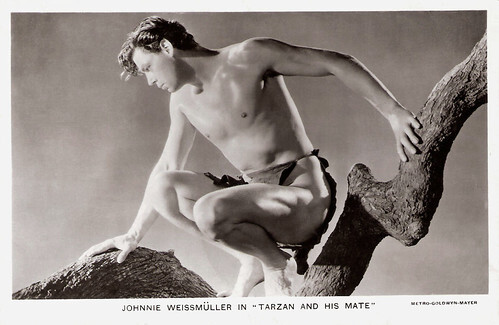
British postcard in the Picturegoer Series, London, no. 864. Photo: Metro-Goldwyn-Mayer. Johnny Weissmuller in Tarzan and his Mate (W. S. Van Dyke, 1934).

Spanish postcard by JDP, Barcelona, no. 1475. Lex Barker in Tarzan’s magic fountain (1949).

Italian Real Photo postcard, no. 401. Gordon Scott as Tarzan
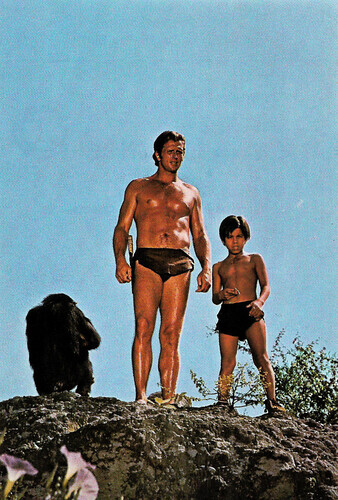
German collectors card by Penny in the series 'Unsere Bambi-Lieblinge', no. 27. Ron Ely as Tarzan and Manuel Padilla Jr. as Jai with Cheeta in the TV series Tarzan (1966-1968).
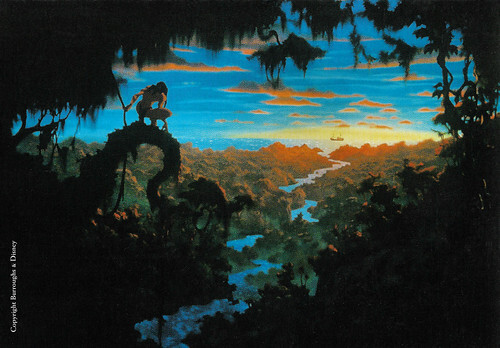
French double card. Image: Burroughs / Disney. An animated Tarzan in Tarzan (Chris Buck, Kevin Lima, 1999).
White skin
American writer Edgar Rice Burroughs (1875-1950) published 'A Princess of Mars' under the title 'Under the Moons of Mars' in six parts between February and July of 1912. The same All-Story Magazine put out his immediately successful 'Tarzan of the Apes' in October of that year. Two years later the hardback book appeared.
Tarzan is the orphaned son of aristocratic English parents, John and Alice Clayton, or Lord and Lady Greystoke, who are stranded on the west coast of Africa in the late 19th century after a mutiny aboard the ship taking them to Africa. They try to survive in the coastal jungle.
When his parents die, the human baby is adopted and raised by the ape Kala, who has just lost her own young. Tarzan's real name is John Clayton, Lord Greystoke, but Tarzan ('white skin') is the new name given to him by Kala. The only people Tarzan comes into contact with during the first 18 years of his life are members of a cannibal tribe. One of them, Kulonga, kills Tarzan's nurse Kala, after which Tarzan takes bloody revenge.
Years later, Tarzan finds some children's books in his real parents' cabin. Using the pictures and letters, he teaches himself to read and write, but a human language he does not learn until much later - when he is discovered by white people.
The first people he meets are young American Jane Porter, her father and French lieutenant commander Paul D'Arnot. From the latter, he learns to speak the first human language, which is French, and later English. D'Arnot will also remain Tarzan's best friend for the rest of his life, taking him into the civilised world. The Porters, along with another group of people, are left behind in Africa by mutineers. Tarzan and Jane meet and instantly fall in love. When Jane returns to America, Tarzan eventually goes after her. In later books, the two are married and have a son named Jack, whose name in the monkey language is Korak ('the slayer').

British postcard in the Picturegoer Series, no. 680. Photo: M.G.M. Publicity still for Tarzan the Ape Man (W. S. Van Dyke, 1932) with Johnny Weissmuller and Maureen O'Sullivan .
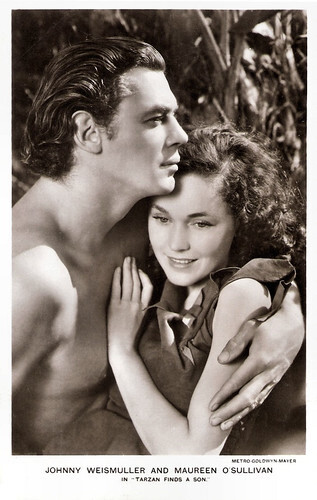
British postcard by Real Photograph, London, no. FS 208. Photo: Metro-Goldwyn-Mayer (MGM). Johnny Weissmuller and Maureen O'Sullivan in Tarzan Finds A Son (Richard Thorpe, 1939).
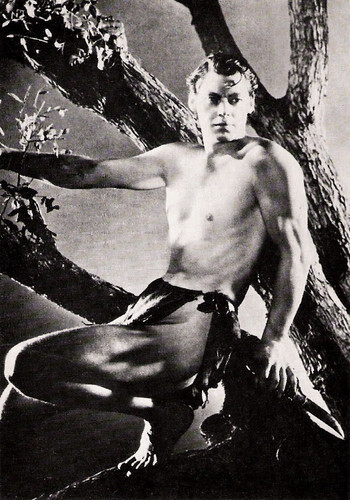
Vintage postcard. Johnny Weissmuller .
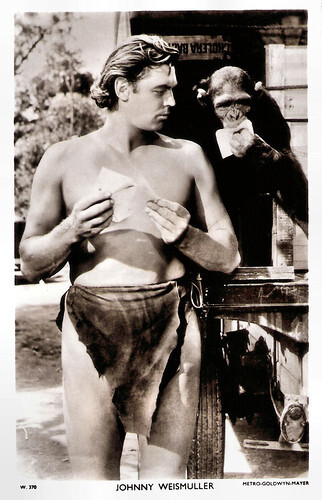
British postcard in the Picturegoer series, London, no. W 370. Photo: Metro-Goldwyn-Mayer.
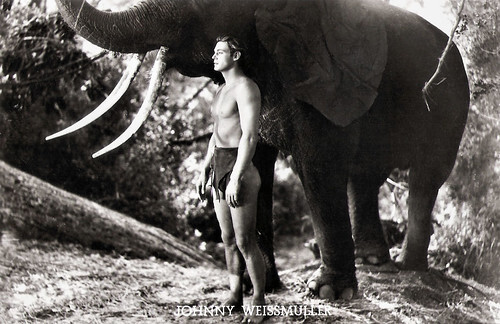
Dutch postcard, no. 751. Photo: M.G.M.
Eternal youth
'Tarzan of the Apes' was a great success, but Edgar Rice Burroughs's later books were often less well-received. A common criticism was that the books maintained too much of a fixed formula that was repeated over and over again. However, Tarzan is one of the world's best-known fictional characters. Apart from almost 30 books by Burroughs and some by other authors, he also appears in many films, television series, comic book series and radio plays. Although the copyright on the original Tarzan story has now expired in the United States, the Tarzan name is still copyrighted. The rights are held by Edgar Rice Burroughs, Inc.
Tarzan, in the original books by Burroughs, is a hero with mostly good qualities. He is a tall, very athletically built white man, with grey eyes and black hair. He is highly intelligent and learns a new language easily and quickly. Some elements in the Tarzan stories and films were racist. Burroughs was a child of his time. For instance, the African indigenous people featured in the stories are regularly portrayed in a stereotypical and negative way. On the other hand, the tribe of Waziri, whom Tarzan takes in when he helps them in their fight against Arab slave traders, are described by Burroughs as wonderful people. They play a significant role in several Tarzan novels.
Tarzan's upbringing among the great apes and his years living in the jungle gave him skills beyond those of most people. He has extra-sharp senses. For instance, he can hear an enemy approaching from miles away or smell danger. He usually wears only a loincloth. Preferably, he moves around by swinging and jumping from branch to branch in the high tree terraces. He rarely if ever uses lianas, although they are more often seen in films. Tarzan, through the use of special pills obtained through a mysterious Kavuru tribe and treatment by a black witch doctor, has 'eternal youth'.
In the last Tarzan book completed by Burroughs, set at the end of World War II, he looks like a man in his late twenties. In reality, however, he is by then close to 60. His wife Jane and his faithful monkey Nkima were also taking those pills regularly. Tarzan's love for his wife Jane is unconditional, and he regularly rejects advances by other women, even when they are more beautiful and interesting than Jane; in Edgar Rice Burroughs' novels, for instance, Queen Nemone and High Priestess La of the Lost City of Opar.
In battles with wild animals, he always emerges victorious. Of all the animals in the jungle, contrary to what non-experts think, Tarzan can only communicate with monkeys, although he also has a special bond with elephants, who somehow seem to understand him to some extent. Elephants also come to his rescue when he calls them to his aid in emergencies. In various film versions, Tarzan has intelligent animals as friends. The chimpanzee Cheetah is the best-known example. However, Cheetah does not appear in Burroughs' original books. Indeed, no chimpanzees appear in the books at all. Tarzan's constant companion, the very small monkey Nkima, is a troublemaker with a bloodthirsty nature, but very helpful in emergencies.
A large monkey species unknown to humans, grey in hair colour, called the 'Mangani' in the books, is the one in which Tarzan grew up and of which he later became 'king'. The gorillas ('Bolgani') are the mortal enemies of that tribe of apes, and thus also of Tarzan. With elephants, Tarzan has a special and strong bond. He calls this species 'Tantor' (that is, not the name of one specific elephant). Jad-Bal-Ja, the 'golden lion', is a giant lion with a black mane, trained by Tarzan who found the animal as a cub. Together with him, Tarzan has various adventures.

Big German card by Ross Verlag. Photo: Paramount. Buster Crabbe in Tarzan the Fearless (Robert F. Hill, 1933).

Spanish collectors cards by Exclusiva Ferber y Blay, no. 7 of 15 cromos. Photo: Sol Lesser Productions. Buster Crabbe in Tarzan the Fearless (Robert F. Hill, 1933). The Spanish release title was Tarzan de la las fieras.
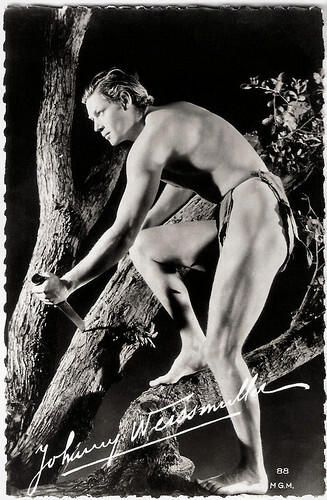
French postcard by Editions et Publications Cinematographiques, no. 88. Photo: Metro-Goldwyn-Mayer. Johnny Weissmuller .

Belgian postcard by Les Editions d'Art L.A.B., Bruxelles, no. 2022. Photo: Metro-Goldwyn-Mayer. Maureen O'Sullivan and Johnny Sheffield in Tarzan's Secret Treasure (Richard Thorpe, 1941).

German postcard by Rüdel-Verlag, Hamburg-Bergedorf, no. 449. Photo: Alex Kahle / RKO Radio Film. Lex Barker in Tarzan's Magic Fountain (Lee Sholem, 1949).

West German collectors card in the Filmstars der Welt series by Greiling-Sammelbilder, series C, no. 103. Photo: RKO. Virginia Huston and Lex Barker in Tarzan’s Peril (Byron Haskin, 1951).
An imposingly built Olympic swimming champion
In 1918, the first Tarzan film was released, the silent feature Tarzan of the Apes (Scott Sidney, 1918). Elmo Lincoln played Tarzan and Gordon Griffith played Tarzan as a child. Stellan Windrow, who initially portrayed the title character in the film, went into military service five weeks after filming began. Lincoln replaced Windrow, although author Edgar Rice Burroughs objected to the choice. It was one of the first films to gross over $1,000,000. Burroughs was able to move his family to the San Fernando Valley in 1919, converting a huge estate into Tarzana Ranch. Elmo Lincoln became famous for the role. He portrayed the character twice more, in The Romance of Tarzan (Wilfred Lucas, 1918) and in the serial The Adventures of Tarzan (Robert F. Hill, Scott Sidney, 1921) with Louise Lorraine as Jane Porter. The serial's prologue features Edgar Rice Burroughs himself.
Tarzan became world-famous, when the imposingly built Olympic swimming champion Johnny Weissmuller played the role of Tarzan, starting with Tarzan the Ape Man (W. S. Van Dyke, 1932) through twelve films until 1948. These films often featured Tarzan's chimpanzee companion Cheeta, his consort Jane (in the first films Maureen O'Sullivan and later Brenda Joyce), and an adopted son, usually known only as Boy (Johnny Sheffield). The most famous statement of the verbally bumbling Tarzan in front of the first human woman he encountered in the guise of Maureen was, "Me Tarzan, you Jane!" However, this is a misconception that has taken on a life of its own after an ill-informed journalist once wrote it down that way. In fact, those words were never spoken that way by Weissmuller. Indeed, in the film scene in question, he points to Jane, and mentions her name, only to point to himself and say "Tarzan". He then repeats the words.
However, the Weissmuller Tarzan version deviated hugely from the original Tarzan, as conceived by writer Burroughs. This was partly due to Burroughs himself, who had a contract with the film company MGM stipulating that no storyline or character from his original books could be used in the films. Only the names Tarzan and Jane could be used, with Jane even being given a surname other than the original one, Parker, instead of Porter. Burroughs would later, after seeing one of Weissmuller's Tarzan films, shake his head, saying "I give them a wonderfully intelligent hero, and they turn it into a country bumpkin".
There were also several serials and features that competed with the main franchise, including Tarzan the Fearless (Robert F. Hill, 1933) starring Buster Crabbe and The New Adventures of Tarzan (Edward Kull, Wilbur F. McGaugh, 1935) starring Olympic champion shot-putter Herman Brix, who would later call himself Bruce Bennett. The latter film serial in 12 chapters was unique for its period in that it was partially filmed on location in Guatemala and portrayed Tarzan as the cultured and well-educated gentleman in the original Edgar Rice Burroughs novels. It was the only Tarzan film project for which Burroughs was personally involved in the production. The New Adventures of Tarzan was later re-released in shorter versions as The New Adventures of Tarzan (1935) and Tarzan and The Green Goddess (1938). To this day, Brix is regarded by Burroughs fans as the most Burroughs-like Tarzan actor ever.
The 1950s saw a major resurgence in Tarzan's popularity. Books and comics were much in demand and Tarzan films and television series followed. Handsome Lex Barker became the new Tarzan in five films for RKO . During the following period, some of the best Tarzan films were made: Tarzan's Greatest Adventure (John Guillermin, 1959) and Tarzan The Magnificent (Robert Day, 1960), both starring the muscular Gordon Scott . These films are considered top of the genre and are much closer to the original than the films starring Weissmuller. The films Tarzan Goes To India (John Guillermin, 1962) and Tarzan's Three Challenges (Robert Day, 1963) with Jock Mahoney as Tarzan, are also brilliant productions in widescreen and colour. Tarzan Goes To India was financially even the most successful Tarzan film ever.
In the 1960s, the quality of the films quickly declined again. Ron Ely did still have a lot of success as the more intelligent Tarzan, in the 57-part television series Tarzan (1966-1968). Tarzan, the Ape Man (John Derek, 1981), starring Miles O'Keeffe and Bo Derek, was filmed from the point of view of Jane Parker. Greystoke: The Legend of Tarzan, Lord of the Apes (Hugh Hudson, 1984) goes back more to Burroughs' story and Tarzan is no longer portrayed as silly as in the Weissmuller films. The next Tarzan film, Tarzan and The Lost City (Carl Schenkel, 1998), with Casper Van Dien, was intended as a sequel to Greystoke, but a too-small budget and an unedifying screenplay made the film flop. Tony Goldwyn voiced Tarzan in Disney's animated film Tarzan (Chris Buck, Kevin Lima, 1999). It was the first major animated motion picture to star the Ape Man and his ape family was portrayed as gorillas in the film. The recent television series Tarzan (2003) with Travis Fimmel in the title role, was not a success either. In Tarzan (David Yates, 2016), Alexander Skarsgård plays the role of a modernised Tarzan. The story follows John Clayton (Tarzan), who, after moving to London, is convinced by George Washington Williams to return to his former home in the jungles of Africa, to investigate claims of slavery.
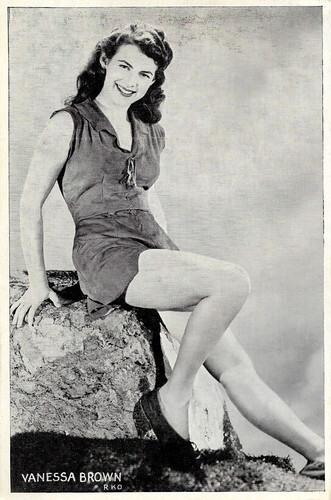
Vintage postcard. Photo: RKO. Vanessa Brown in Tarzan and the Slave Girl (Lee Sholem, 1950).

West German postcard by Kunst und Bild, Berlin, no. A 580. Photo: RKO. Lex Barker and Denise Darcel Tarzan And The Slave Girl (Lee Sholem, 1950).
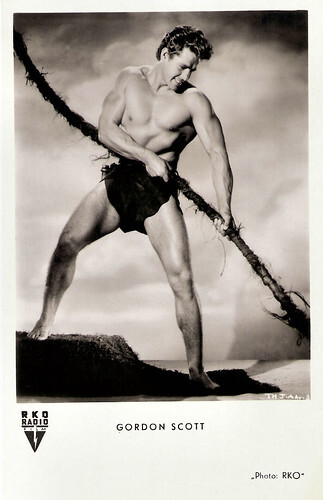
West German postcard by Kunst und Bild, no. I 411. Photo: RKO. Gordon Scott in Tarzan's Hidden Jungle (Harold D. Schuster, 1955).
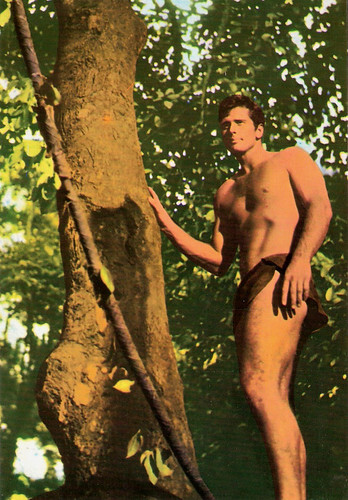
British postcard by Klasik Kards, no. 1588. Ron Ely in the TV series Tarzan (1966-1968).
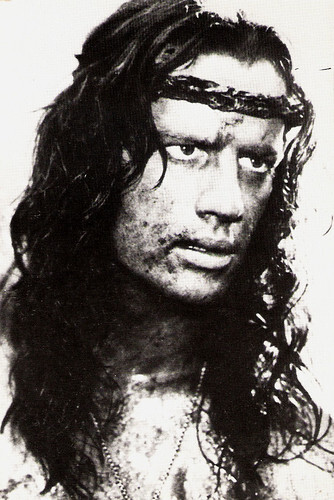
French postcard by Ebullations, no. 60. Christophe Lambert as Tarzan, Lord of the Apes in Greystoke (Hugh Hudson, 1984).
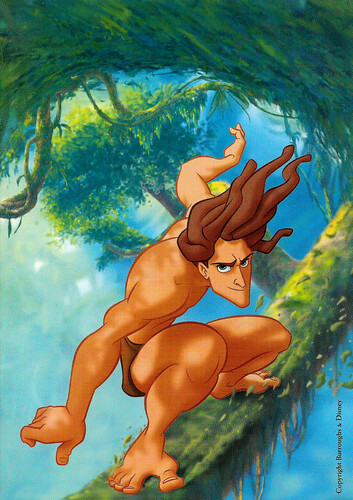
French double card. Image: Burroughs / Disney. Tarzan in Tarzan (Chris Buck, Kevin Lima, 1999).
Sources: (IMDb), Wikipedia (Dutch and English).

British postcard in the Picturegoer Series, London, no. 864. Photo: Metro-Goldwyn-Mayer. Johnny Weissmuller in Tarzan and his Mate (W. S. Van Dyke, 1934).

Spanish postcard by JDP, Barcelona, no. 1475. Lex Barker in Tarzan’s magic fountain (1949).

Italian Real Photo postcard, no. 401. Gordon Scott as Tarzan

German collectors card by Penny in the series 'Unsere Bambi-Lieblinge', no. 27. Ron Ely as Tarzan and Manuel Padilla Jr. as Jai with Cheeta in the TV series Tarzan (1966-1968).

French double card. Image: Burroughs / Disney. An animated Tarzan in Tarzan (Chris Buck, Kevin Lima, 1999).
White skin
American writer Edgar Rice Burroughs (1875-1950) published 'A Princess of Mars' under the title 'Under the Moons of Mars' in six parts between February and July of 1912. The same All-Story Magazine put out his immediately successful 'Tarzan of the Apes' in October of that year. Two years later the hardback book appeared.
Tarzan is the orphaned son of aristocratic English parents, John and Alice Clayton, or Lord and Lady Greystoke, who are stranded on the west coast of Africa in the late 19th century after a mutiny aboard the ship taking them to Africa. They try to survive in the coastal jungle.
When his parents die, the human baby is adopted and raised by the ape Kala, who has just lost her own young. Tarzan's real name is John Clayton, Lord Greystoke, but Tarzan ('white skin') is the new name given to him by Kala. The only people Tarzan comes into contact with during the first 18 years of his life are members of a cannibal tribe. One of them, Kulonga, kills Tarzan's nurse Kala, after which Tarzan takes bloody revenge.
Years later, Tarzan finds some children's books in his real parents' cabin. Using the pictures and letters, he teaches himself to read and write, but a human language he does not learn until much later - when he is discovered by white people.
The first people he meets are young American Jane Porter, her father and French lieutenant commander Paul D'Arnot. From the latter, he learns to speak the first human language, which is French, and later English. D'Arnot will also remain Tarzan's best friend for the rest of his life, taking him into the civilised world. The Porters, along with another group of people, are left behind in Africa by mutineers. Tarzan and Jane meet and instantly fall in love. When Jane returns to America, Tarzan eventually goes after her. In later books, the two are married and have a son named Jack, whose name in the monkey language is Korak ('the slayer').

British postcard in the Picturegoer Series, no. 680. Photo: M.G.M. Publicity still for Tarzan the Ape Man (W. S. Van Dyke, 1932) with Johnny Weissmuller and Maureen O'Sullivan .

British postcard by Real Photograph, London, no. FS 208. Photo: Metro-Goldwyn-Mayer (MGM). Johnny Weissmuller and Maureen O'Sullivan in Tarzan Finds A Son (Richard Thorpe, 1939).

Vintage postcard. Johnny Weissmuller .

British postcard in the Picturegoer series, London, no. W 370. Photo: Metro-Goldwyn-Mayer.

Dutch postcard, no. 751. Photo: M.G.M.
Eternal youth
'Tarzan of the Apes' was a great success, but Edgar Rice Burroughs's later books were often less well-received. A common criticism was that the books maintained too much of a fixed formula that was repeated over and over again. However, Tarzan is one of the world's best-known fictional characters. Apart from almost 30 books by Burroughs and some by other authors, he also appears in many films, television series, comic book series and radio plays. Although the copyright on the original Tarzan story has now expired in the United States, the Tarzan name is still copyrighted. The rights are held by Edgar Rice Burroughs, Inc.
Tarzan, in the original books by Burroughs, is a hero with mostly good qualities. He is a tall, very athletically built white man, with grey eyes and black hair. He is highly intelligent and learns a new language easily and quickly. Some elements in the Tarzan stories and films were racist. Burroughs was a child of his time. For instance, the African indigenous people featured in the stories are regularly portrayed in a stereotypical and negative way. On the other hand, the tribe of Waziri, whom Tarzan takes in when he helps them in their fight against Arab slave traders, are described by Burroughs as wonderful people. They play a significant role in several Tarzan novels.
Tarzan's upbringing among the great apes and his years living in the jungle gave him skills beyond those of most people. He has extra-sharp senses. For instance, he can hear an enemy approaching from miles away or smell danger. He usually wears only a loincloth. Preferably, he moves around by swinging and jumping from branch to branch in the high tree terraces. He rarely if ever uses lianas, although they are more often seen in films. Tarzan, through the use of special pills obtained through a mysterious Kavuru tribe and treatment by a black witch doctor, has 'eternal youth'.
In the last Tarzan book completed by Burroughs, set at the end of World War II, he looks like a man in his late twenties. In reality, however, he is by then close to 60. His wife Jane and his faithful monkey Nkima were also taking those pills regularly. Tarzan's love for his wife Jane is unconditional, and he regularly rejects advances by other women, even when they are more beautiful and interesting than Jane; in Edgar Rice Burroughs' novels, for instance, Queen Nemone and High Priestess La of the Lost City of Opar.
In battles with wild animals, he always emerges victorious. Of all the animals in the jungle, contrary to what non-experts think, Tarzan can only communicate with monkeys, although he also has a special bond with elephants, who somehow seem to understand him to some extent. Elephants also come to his rescue when he calls them to his aid in emergencies. In various film versions, Tarzan has intelligent animals as friends. The chimpanzee Cheetah is the best-known example. However, Cheetah does not appear in Burroughs' original books. Indeed, no chimpanzees appear in the books at all. Tarzan's constant companion, the very small monkey Nkima, is a troublemaker with a bloodthirsty nature, but very helpful in emergencies.
A large monkey species unknown to humans, grey in hair colour, called the 'Mangani' in the books, is the one in which Tarzan grew up and of which he later became 'king'. The gorillas ('Bolgani') are the mortal enemies of that tribe of apes, and thus also of Tarzan. With elephants, Tarzan has a special and strong bond. He calls this species 'Tantor' (that is, not the name of one specific elephant). Jad-Bal-Ja, the 'golden lion', is a giant lion with a black mane, trained by Tarzan who found the animal as a cub. Together with him, Tarzan has various adventures.

Big German card by Ross Verlag. Photo: Paramount. Buster Crabbe in Tarzan the Fearless (Robert F. Hill, 1933).

Spanish collectors cards by Exclusiva Ferber y Blay, no. 7 of 15 cromos. Photo: Sol Lesser Productions. Buster Crabbe in Tarzan the Fearless (Robert F. Hill, 1933). The Spanish release title was Tarzan de la las fieras.

French postcard by Editions et Publications Cinematographiques, no. 88. Photo: Metro-Goldwyn-Mayer. Johnny Weissmuller .

Belgian postcard by Les Editions d'Art L.A.B., Bruxelles, no. 2022. Photo: Metro-Goldwyn-Mayer. Maureen O'Sullivan and Johnny Sheffield in Tarzan's Secret Treasure (Richard Thorpe, 1941).

German postcard by Rüdel-Verlag, Hamburg-Bergedorf, no. 449. Photo: Alex Kahle / RKO Radio Film. Lex Barker in Tarzan's Magic Fountain (Lee Sholem, 1949).

West German collectors card in the Filmstars der Welt series by Greiling-Sammelbilder, series C, no. 103. Photo: RKO. Virginia Huston and Lex Barker in Tarzan’s Peril (Byron Haskin, 1951).
An imposingly built Olympic swimming champion
In 1918, the first Tarzan film was released, the silent feature Tarzan of the Apes (Scott Sidney, 1918). Elmo Lincoln played Tarzan and Gordon Griffith played Tarzan as a child. Stellan Windrow, who initially portrayed the title character in the film, went into military service five weeks after filming began. Lincoln replaced Windrow, although author Edgar Rice Burroughs objected to the choice. It was one of the first films to gross over $1,000,000. Burroughs was able to move his family to the San Fernando Valley in 1919, converting a huge estate into Tarzana Ranch. Elmo Lincoln became famous for the role. He portrayed the character twice more, in The Romance of Tarzan (Wilfred Lucas, 1918) and in the serial The Adventures of Tarzan (Robert F. Hill, Scott Sidney, 1921) with Louise Lorraine as Jane Porter. The serial's prologue features Edgar Rice Burroughs himself.
Tarzan became world-famous, when the imposingly built Olympic swimming champion Johnny Weissmuller played the role of Tarzan, starting with Tarzan the Ape Man (W. S. Van Dyke, 1932) through twelve films until 1948. These films often featured Tarzan's chimpanzee companion Cheeta, his consort Jane (in the first films Maureen O'Sullivan and later Brenda Joyce), and an adopted son, usually known only as Boy (Johnny Sheffield). The most famous statement of the verbally bumbling Tarzan in front of the first human woman he encountered in the guise of Maureen was, "Me Tarzan, you Jane!" However, this is a misconception that has taken on a life of its own after an ill-informed journalist once wrote it down that way. In fact, those words were never spoken that way by Weissmuller. Indeed, in the film scene in question, he points to Jane, and mentions her name, only to point to himself and say "Tarzan". He then repeats the words.
However, the Weissmuller Tarzan version deviated hugely from the original Tarzan, as conceived by writer Burroughs. This was partly due to Burroughs himself, who had a contract with the film company MGM stipulating that no storyline or character from his original books could be used in the films. Only the names Tarzan and Jane could be used, with Jane even being given a surname other than the original one, Parker, instead of Porter. Burroughs would later, after seeing one of Weissmuller's Tarzan films, shake his head, saying "I give them a wonderfully intelligent hero, and they turn it into a country bumpkin".
There were also several serials and features that competed with the main franchise, including Tarzan the Fearless (Robert F. Hill, 1933) starring Buster Crabbe and The New Adventures of Tarzan (Edward Kull, Wilbur F. McGaugh, 1935) starring Olympic champion shot-putter Herman Brix, who would later call himself Bruce Bennett. The latter film serial in 12 chapters was unique for its period in that it was partially filmed on location in Guatemala and portrayed Tarzan as the cultured and well-educated gentleman in the original Edgar Rice Burroughs novels. It was the only Tarzan film project for which Burroughs was personally involved in the production. The New Adventures of Tarzan was later re-released in shorter versions as The New Adventures of Tarzan (1935) and Tarzan and The Green Goddess (1938). To this day, Brix is regarded by Burroughs fans as the most Burroughs-like Tarzan actor ever.
The 1950s saw a major resurgence in Tarzan's popularity. Books and comics were much in demand and Tarzan films and television series followed. Handsome Lex Barker became the new Tarzan in five films for RKO . During the following period, some of the best Tarzan films were made: Tarzan's Greatest Adventure (John Guillermin, 1959) and Tarzan The Magnificent (Robert Day, 1960), both starring the muscular Gordon Scott . These films are considered top of the genre and are much closer to the original than the films starring Weissmuller. The films Tarzan Goes To India (John Guillermin, 1962) and Tarzan's Three Challenges (Robert Day, 1963) with Jock Mahoney as Tarzan, are also brilliant productions in widescreen and colour. Tarzan Goes To India was financially even the most successful Tarzan film ever.
In the 1960s, the quality of the films quickly declined again. Ron Ely did still have a lot of success as the more intelligent Tarzan, in the 57-part television series Tarzan (1966-1968). Tarzan, the Ape Man (John Derek, 1981), starring Miles O'Keeffe and Bo Derek, was filmed from the point of view of Jane Parker. Greystoke: The Legend of Tarzan, Lord of the Apes (Hugh Hudson, 1984) goes back more to Burroughs' story and Tarzan is no longer portrayed as silly as in the Weissmuller films. The next Tarzan film, Tarzan and The Lost City (Carl Schenkel, 1998), with Casper Van Dien, was intended as a sequel to Greystoke, but a too-small budget and an unedifying screenplay made the film flop. Tony Goldwyn voiced Tarzan in Disney's animated film Tarzan (Chris Buck, Kevin Lima, 1999). It was the first major animated motion picture to star the Ape Man and his ape family was portrayed as gorillas in the film. The recent television series Tarzan (2003) with Travis Fimmel in the title role, was not a success either. In Tarzan (David Yates, 2016), Alexander Skarsgård plays the role of a modernised Tarzan. The story follows John Clayton (Tarzan), who, after moving to London, is convinced by George Washington Williams to return to his former home in the jungles of Africa, to investigate claims of slavery.

Vintage postcard. Photo: RKO. Vanessa Brown in Tarzan and the Slave Girl (Lee Sholem, 1950).

West German postcard by Kunst und Bild, Berlin, no. A 580. Photo: RKO. Lex Barker and Denise Darcel Tarzan And The Slave Girl (Lee Sholem, 1950).

West German postcard by Kunst und Bild, no. I 411. Photo: RKO. Gordon Scott in Tarzan's Hidden Jungle (Harold D. Schuster, 1955).

British postcard by Klasik Kards, no. 1588. Ron Ely in the TV series Tarzan (1966-1968).

French postcard by Ebullations, no. 60. Christophe Lambert as Tarzan, Lord of the Apes in Greystoke (Hugh Hudson, 1984).

French double card. Image: Burroughs / Disney. Tarzan in Tarzan (Chris Buck, Kevin Lima, 1999).
Sources: (IMDb), Wikipedia (Dutch and English).
Published on January 31, 2023 22:00
January 30, 2023
Pierre de Guingand
Pierre de Guingand (1885-1964) was a French stage and film actor in the 1920s and 1930s, best known for his debut role as Aramis in the popular serial Les Trois Mousquetaires/The Three Musketeers (1921) and in its sequel Vingt ans après/The Return of the Musketeers (1922). He also played elegant, rich men in films like Au bonheur des dames/In the happiness of the ladies (1929) and Ich küsse Ihre Hand, Madame/I Kiss Your Hand Madame (1929).
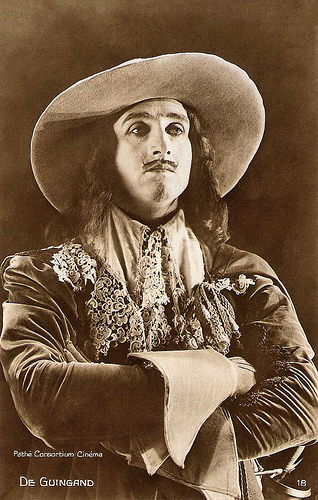
French postcard by Cinémagazine Edition, no. 18. Photo: Pathé Consortium Cinema. Publicity still for Les Trois Mousquetaires (Henri Diamant Berger, 1921).
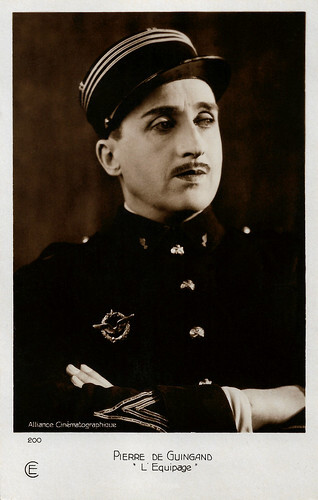
French postcard by Cinémagazine-Edition, Paris, no. 200. Photo: Alliance Cinématographique. Pierre de Guingand in L'équipage/Last Flight (Maurice Tourneur, 1928).
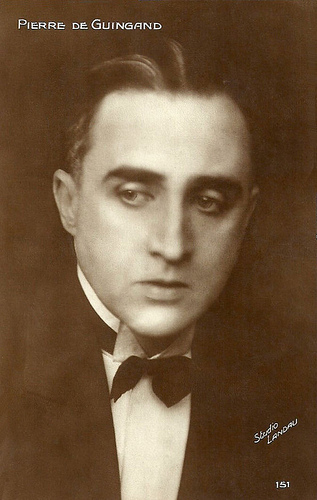
French postcard by Cinémagazine, no. 151. Photo: Studio Landau.
Musketeer Aramis
Octave-Pierre Deguingand a.k.a. Pierre de Guingand was born in Paris in 1885. In 1908, he probably debuted on stage in the play 'Ramuntcho' by Pierre Loti, directed by André Antoine at the Théâtre de l'Odéon. A few years later he performed in the play 'La Pèlerine écossaise' (1914) by Sacha Guitry , at the Théâtre des Bouffes-Parisiens.
In 1921 Guingand played in 'Une danseuse est morte' by Charles Le Bargy , at the Théâtre des Galeries Saint Hubert. Also in 1921, Guingand made his first appearance in the cinema and had a big role right away as Aramis in the 12-episode film Les Trois Mousquetaires/The Three Musketeers (Henri Diamant-Berger, 1921). He also played Aramis again in the sequel Vingt ans après/The Return of the Musketeers (Henri Diamant-Berger, 1922), a 10-episode serial.
Guingand stayed on with Diamant-Berger for the director's subsequent films Le Mauvais Garçon/Bad Boy (Henri Diamant-Berger, 1922) with Maurice Chevalier , L'Emprise/The influence (Henri Diamant-Berger, 1923), and Le Roi de la vitesse/King of the speed (Henri Diamant-Berger, 1923). In the following year, De Guingand played Lodovico Gonzaga in Le Vert Galant/The Courteous Green (René Leprince, 1924), this time a film in 8 episodes, and in 1925 he performed as marquis d'Aurilly in the 8-episode serial Fanfan La Tulipe/Fan Fan the Tulip (René Leprince, 1924), starring Aimé Simon-Girard .
In 1926-1927, De Guingand was absent from the screen, but he performed on stage in plays such as 'Le Prince charmant' (Prince Charming, 1925) by Tristan Bernard, at the Théâtre Michel, and 'Un perdreau de l'année' (A young partridge of the year, 1926), again by Tristan Bernard, and again at the Théâtre Michel.
In 1928, Pierre de Guingand returned to the film set for L'Équipage/Last Flight (Maurice Tourneur, 1928), starring Charles Vanel and Jean Murat , and La Possession/The Ownership (Léonce Perret, 1928) with Italian film diva Francesca Bertini in the female lead.
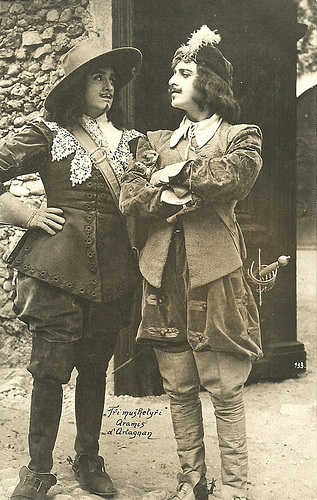
French postcard, no. 133. Pierre de Guingand as Aramis and Aimé Simon-Girard as D'Artagnan in Les trois mousquetaires/The Three Musketeers (Henri Diamant-Berger, 1921).
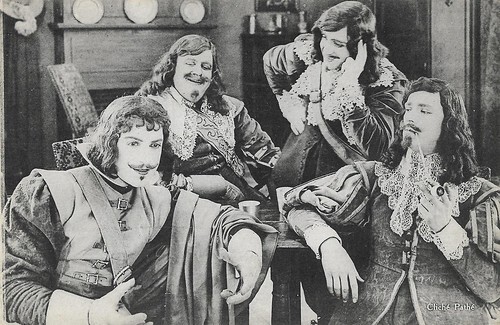
French postcard by M. Le Deley, Paris. Photo: Pathé. Les trois mousquetaires/The Three Musketeers (Henri Diamant-Berger, 1921) with Aimé Simon-Girard as D'Artagnan, Charles Martinelli as Porthos, Pierre de Guingand as Aramis, and Henri Rollan as Athos.
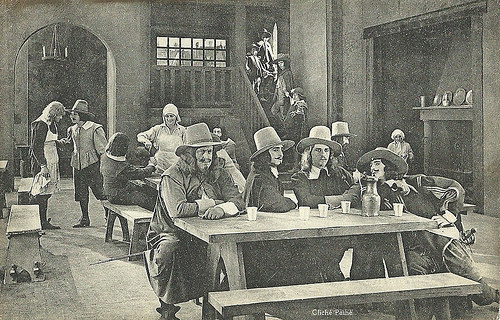
French postcard. Photo: Pathé. Publicity still for Vingt ans après/The Return of the Musketeers (Henri Diamant-Berger, 1922). The four musketeers: Porthos ( Charles Martinelli ), Aramis (Pierre de Guingand), Athos ( Henri Rollan ), and D'Artagnan (Jean Yonnel).
Marlene Dietrich's ex-husband
In the late silent film Au bonheur des dames/In the happiness of the ladies (Julien Duvivier, 1929), Pierre de Guingand played Octave Mouret, the rich owner of the department store Au Bonheur des dames, who falls for a young mannequin, Denise ( Dita Parlo ). Her uncle (Armand Bour), however, owns the little shop Mouret wants to tear down for the expansion of his own department store.
De Guingand also made another remarkable late silent performance in Germany in Ich küsse ihre hand, Madame/I Kiss Your Hand Madame (Robert Land, 1929) starring Marlene Dietrich . Guingand plays the ex-husband of Laurette Gerard (Dietrich), who is still infatuated with her despite the divorce. Laurette starts an affair with a gentleman ( Harry Liedtke ) until she discovers he works as a waiter. In reality, the waiter is a Russian count though.
In 1931, De Guingand played in the French version of the early sound film Der Ball, Le bal (Wilhelm Thiele, 1931), starring Germaine Dermoz and Danielle Darrieux . Next came La Chance/Luck (René Guissart, 1931) with Marie Bell , the comedy Une faible femme/A Weak Woman (Max de Vaucorbeil, 1932) with Meg Lemonnier , and Chourinette (André Hugon, 1934) with Mireille. He played a supporting part in the classic Le Grand jeu/The big game (Jacques Feyder, 1933) with Marie Bell .
Among his later films were L'Appel du silence/The Call (Léon Poirier, 1936) with Jean Yonnel as North Africa explorer Charles de Foucauld and Guingand as General Laperrine, Sarati, le terrible/Sarati the Terrible (André Hugon, 1937) with Harry Baur in the title role, and finally Remontons les Champs-Élysées/Champs Elysees (Sacha Guitry, 1938) with Guitry himself in a multiple lead role (a.o. Louis XV and Napoleon III) and Guingand as baron de Vitry.
Occasionally Guingand continued stage acting as well, as in 'Le Cyclone' (1931) by Somerset Maugham, directed by Jacques Baumer, at the Théâtre des Ambassadeurs, and 'Tout n'est pas noir' (1941) by André Birabeau, directed by Robert Blome, at the Théâtre Daunou. Pierre Guingand passed away in 1964 in Versailles. He was 79.
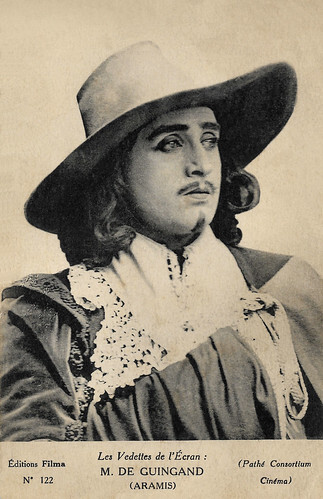
French postcard in the series Les Vedettes de l'Ecran by Editions Filma, no. 122. Photo: Pathé Consortium Cinéma. Pierre de Guingand as Aramis in the period piece serial Les trois mousquetaires/The Three Musketeers (Henri Diamant-Berger, 1921).
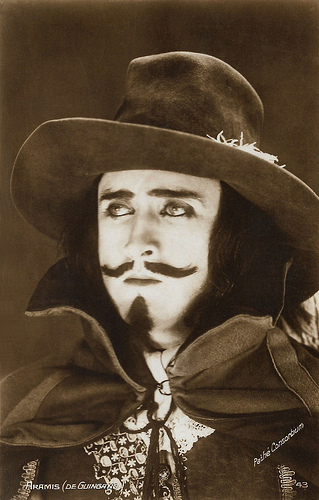
French postcard by Editions Cinémagazine no. 43. Photo: Pathé Consortium Cinéma. Pierre de Guingand as Aramis in Vingt ans après/The Return of the Musketeers (Henri Diamant-Berger, 1922).
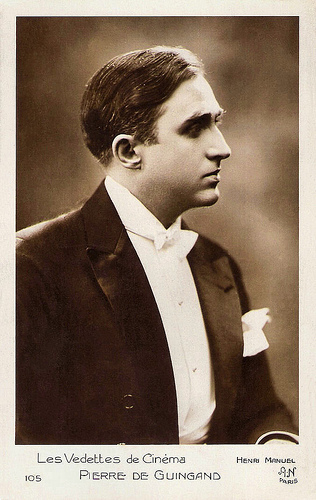
French postcard in the Les Vedettes du Cinéma series by A.N., Paris, no. 105. Photo: Henri Manuel.
Sources: Ciné-Ressources (French), Wikipedia (French) and .

French postcard by Cinémagazine Edition, no. 18. Photo: Pathé Consortium Cinema. Publicity still for Les Trois Mousquetaires (Henri Diamant Berger, 1921).

French postcard by Cinémagazine-Edition, Paris, no. 200. Photo: Alliance Cinématographique. Pierre de Guingand in L'équipage/Last Flight (Maurice Tourneur, 1928).

French postcard by Cinémagazine, no. 151. Photo: Studio Landau.
Musketeer Aramis
Octave-Pierre Deguingand a.k.a. Pierre de Guingand was born in Paris in 1885. In 1908, he probably debuted on stage in the play 'Ramuntcho' by Pierre Loti, directed by André Antoine at the Théâtre de l'Odéon. A few years later he performed in the play 'La Pèlerine écossaise' (1914) by Sacha Guitry , at the Théâtre des Bouffes-Parisiens.
In 1921 Guingand played in 'Une danseuse est morte' by Charles Le Bargy , at the Théâtre des Galeries Saint Hubert. Also in 1921, Guingand made his first appearance in the cinema and had a big role right away as Aramis in the 12-episode film Les Trois Mousquetaires/The Three Musketeers (Henri Diamant-Berger, 1921). He also played Aramis again in the sequel Vingt ans après/The Return of the Musketeers (Henri Diamant-Berger, 1922), a 10-episode serial.
Guingand stayed on with Diamant-Berger for the director's subsequent films Le Mauvais Garçon/Bad Boy (Henri Diamant-Berger, 1922) with Maurice Chevalier , L'Emprise/The influence (Henri Diamant-Berger, 1923), and Le Roi de la vitesse/King of the speed (Henri Diamant-Berger, 1923). In the following year, De Guingand played Lodovico Gonzaga in Le Vert Galant/The Courteous Green (René Leprince, 1924), this time a film in 8 episodes, and in 1925 he performed as marquis d'Aurilly in the 8-episode serial Fanfan La Tulipe/Fan Fan the Tulip (René Leprince, 1924), starring Aimé Simon-Girard .
In 1926-1927, De Guingand was absent from the screen, but he performed on stage in plays such as 'Le Prince charmant' (Prince Charming, 1925) by Tristan Bernard, at the Théâtre Michel, and 'Un perdreau de l'année' (A young partridge of the year, 1926), again by Tristan Bernard, and again at the Théâtre Michel.
In 1928, Pierre de Guingand returned to the film set for L'Équipage/Last Flight (Maurice Tourneur, 1928), starring Charles Vanel and Jean Murat , and La Possession/The Ownership (Léonce Perret, 1928) with Italian film diva Francesca Bertini in the female lead.

French postcard, no. 133. Pierre de Guingand as Aramis and Aimé Simon-Girard as D'Artagnan in Les trois mousquetaires/The Three Musketeers (Henri Diamant-Berger, 1921).

French postcard by M. Le Deley, Paris. Photo: Pathé. Les trois mousquetaires/The Three Musketeers (Henri Diamant-Berger, 1921) with Aimé Simon-Girard as D'Artagnan, Charles Martinelli as Porthos, Pierre de Guingand as Aramis, and Henri Rollan as Athos.

French postcard. Photo: Pathé. Publicity still for Vingt ans après/The Return of the Musketeers (Henri Diamant-Berger, 1922). The four musketeers: Porthos ( Charles Martinelli ), Aramis (Pierre de Guingand), Athos ( Henri Rollan ), and D'Artagnan (Jean Yonnel).
Marlene Dietrich's ex-husband
In the late silent film Au bonheur des dames/In the happiness of the ladies (Julien Duvivier, 1929), Pierre de Guingand played Octave Mouret, the rich owner of the department store Au Bonheur des dames, who falls for a young mannequin, Denise ( Dita Parlo ). Her uncle (Armand Bour), however, owns the little shop Mouret wants to tear down for the expansion of his own department store.
De Guingand also made another remarkable late silent performance in Germany in Ich küsse ihre hand, Madame/I Kiss Your Hand Madame (Robert Land, 1929) starring Marlene Dietrich . Guingand plays the ex-husband of Laurette Gerard (Dietrich), who is still infatuated with her despite the divorce. Laurette starts an affair with a gentleman ( Harry Liedtke ) until she discovers he works as a waiter. In reality, the waiter is a Russian count though.
In 1931, De Guingand played in the French version of the early sound film Der Ball, Le bal (Wilhelm Thiele, 1931), starring Germaine Dermoz and Danielle Darrieux . Next came La Chance/Luck (René Guissart, 1931) with Marie Bell , the comedy Une faible femme/A Weak Woman (Max de Vaucorbeil, 1932) with Meg Lemonnier , and Chourinette (André Hugon, 1934) with Mireille. He played a supporting part in the classic Le Grand jeu/The big game (Jacques Feyder, 1933) with Marie Bell .
Among his later films were L'Appel du silence/The Call (Léon Poirier, 1936) with Jean Yonnel as North Africa explorer Charles de Foucauld and Guingand as General Laperrine, Sarati, le terrible/Sarati the Terrible (André Hugon, 1937) with Harry Baur in the title role, and finally Remontons les Champs-Élysées/Champs Elysees (Sacha Guitry, 1938) with Guitry himself in a multiple lead role (a.o. Louis XV and Napoleon III) and Guingand as baron de Vitry.
Occasionally Guingand continued stage acting as well, as in 'Le Cyclone' (1931) by Somerset Maugham, directed by Jacques Baumer, at the Théâtre des Ambassadeurs, and 'Tout n'est pas noir' (1941) by André Birabeau, directed by Robert Blome, at the Théâtre Daunou. Pierre Guingand passed away in 1964 in Versailles. He was 79.

French postcard in the series Les Vedettes de l'Ecran by Editions Filma, no. 122. Photo: Pathé Consortium Cinéma. Pierre de Guingand as Aramis in the period piece serial Les trois mousquetaires/The Three Musketeers (Henri Diamant-Berger, 1921).

French postcard by Editions Cinémagazine no. 43. Photo: Pathé Consortium Cinéma. Pierre de Guingand as Aramis in Vingt ans après/The Return of the Musketeers (Henri Diamant-Berger, 1922).

French postcard in the Les Vedettes du Cinéma series by A.N., Paris, no. 105. Photo: Henri Manuel.
Sources: Ciné-Ressources (French), Wikipedia (French) and .
Published on January 30, 2023 22:00
January 29, 2023
Pina Menichelli
With her contorted postures and disdainful expression, the fascinating and enigmatic Pina Menichelli (1890-1984) was the most bizarre diva of the Italian silent film.
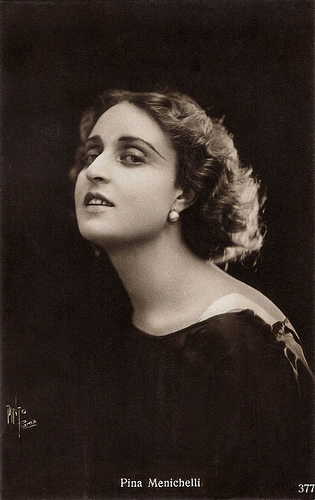
Italian postcard by Ed. A. Traldi, Milano, no. 377. Photo: Pinto, Roma.
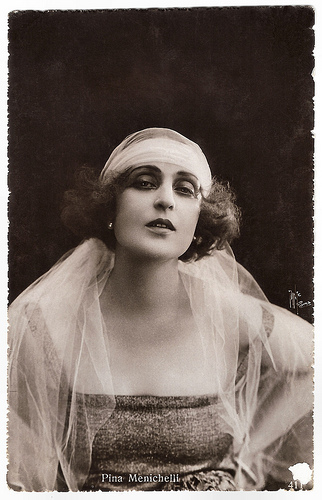
Italian postcard by Ed. A. Traldi, Milano, no. 411. Photo Pinto, Roma.
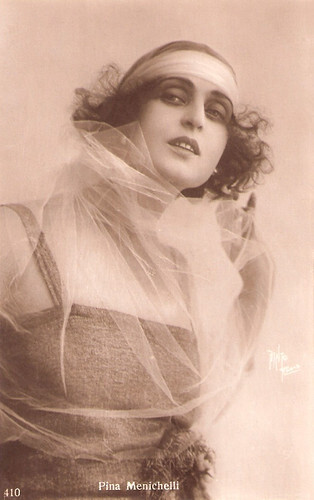
Italian postcard by Ed. A. Traldi, Milano (Milan), no. 410. Photo: Pinto.
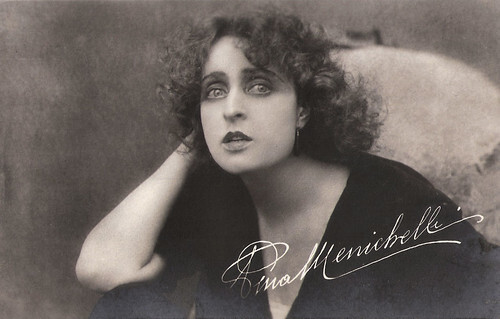
French postcard by BPA, Rueil.
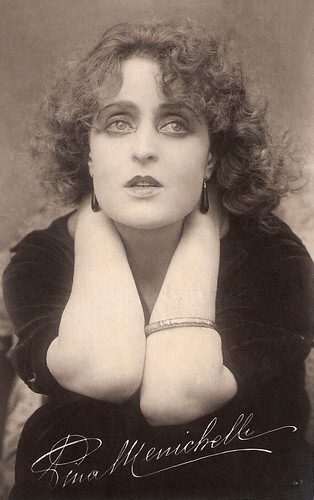
Italian postcard, no. 47.
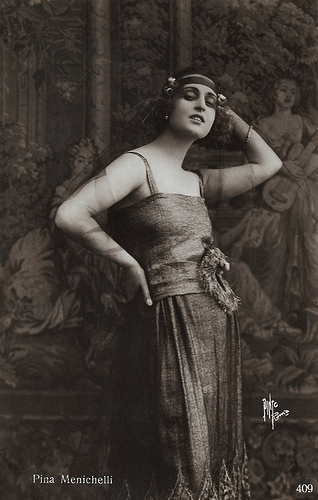
Italian postcard by Ed. A. Traldi, Milano, no. 409. Photo: Pinto, Roma.
Notre Dame des Spasmes
Giuseppina Menichelli was born in Castroreale, Italy, in 1890. She was the sister of singer and actress Dora Menichelli.
After starting her film career at the Roman Cines company in 1913, Pina was catapulted into stardom by Giovanni Pastrone's D'Annunzian film Il Fuoco/The Fire (1915) co-starring with Febo Mari . Il Fuoco tells the love story of a young, vulnerable painter and a wealthy woman. The film's erotic atmosphere caused it to be banned and prompted clerical demonstrations against the film.
Because of her femme fatale, men devouring type, and her extreme and sudden gestures she was nicknamed 'Notre Dame des Spasmes'. Menichelli did however know how to play also in a more restrained way, as Tigre Reale/Royal Tiger (Giovanni Pastrone, 1916) showed.
The script was based on a book by Giovanni Verga and was scripted by the author himself. Verga was a Sicilian writer known for his realist (verismo) fiction rather than for his symbolist-decadent works. Despite this, the story of Tigre Reale is a melodrama, full of unlikely twists and turns, but the public was held, mesmerised, by the fascinating and enigmatic Menichelli.
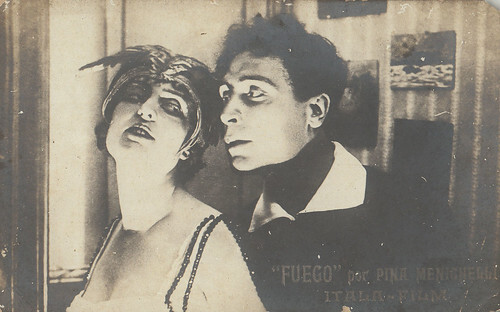
Spanish postcard. Photo: Itala-Film. Pina Menichelli and Febo Mari in Il Fuoco/The Fire (Giovanni Pastrone, 1915). Collection: Marlene Pilaete. Please note that Menichelli wears her famous owl headwear here.
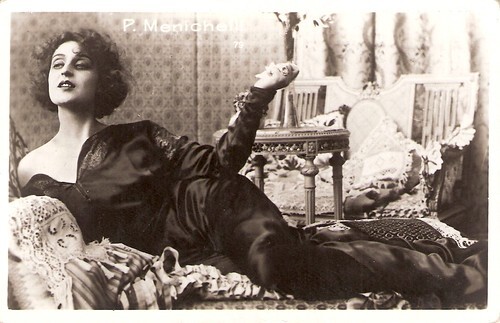
Italian postcard by Ed. Vettori, Bologna. Photo: Pina Menichelli in Tigre Reale (Giovanni Pastrone, 1916).
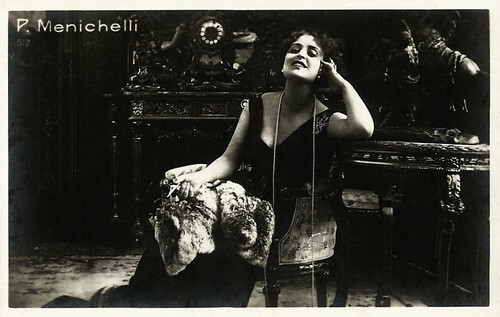
Italian postcard. Photo: Pina Menichelli in Tigre reale (Giovanni Pastrone, 1916).
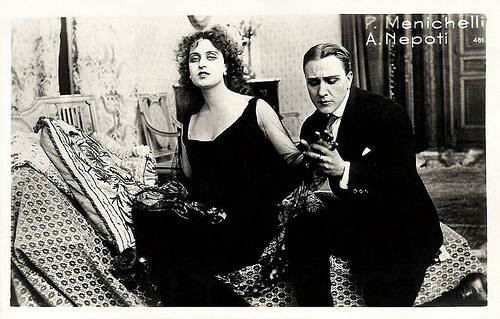
Italian postcard by Vettori, Bologna, no. 461. Pina Menichelli and Alberto Nepoti, probably in Tigre reale (Giovanni Pastrone, 1916).
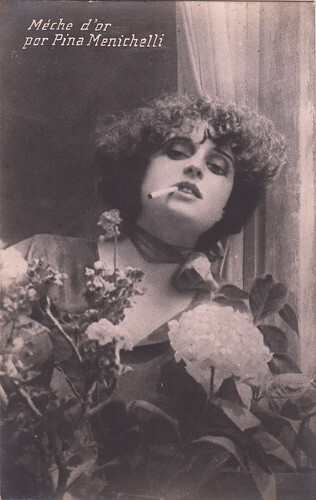
Spanish postcard. Photo: Pina Menichelli in L'olocausto/Méche d'or/Gold Plait (Gero Zambuto, 1918). Collection: Marlène Pilaete.
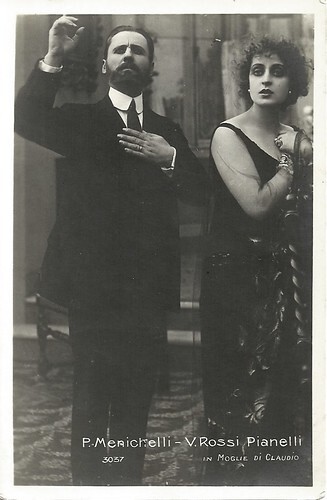
Italian postcard, no. 3037. Photo: Itala. Pina Menichelli and Vittorio Rossi-Pianelli in La moglie di Claudio (Gero Zambuto, 1918), based on 'La femme de Claude' by Alexandre Dumas fils. The film was found and restored in 2011 by Museo nazionale del cinema in Turin and Cineteca di Bologna. See Vimeo.com.
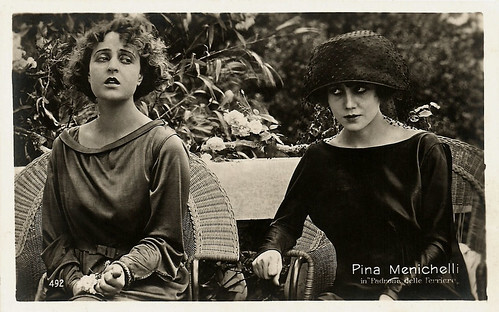
Italian postcard by Vettori, Bologna. Photo: Pina Menichelli in Il padrone delle ferriere (Eugenio Perego, 1919). The other actress must be Lina Millefleurs.
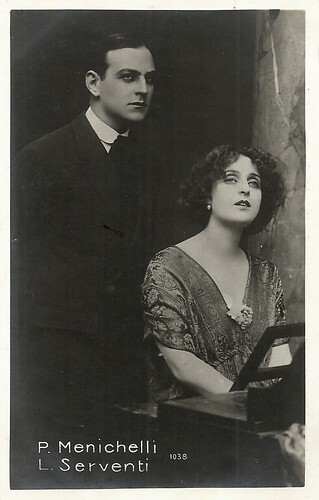
Italian postcard by Ed. Vettori, Bologna, no. 1038. Pina Menichelli and Luigi Serventi in Il romanzo di un giovane povero (Amleto Palermi, 1920), based on the novel 'Le Roman d'un jeune homme pauvre' (1858) by Octave Feuillet.
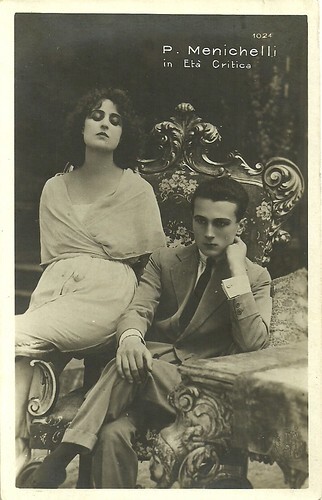
Italian postcard by Ed. Vettori, Bologna, no. 1024. Pina Menichelli and Giorgio Fini in the Italian silent film L'età critica (Amleto Palermi, 1921). Her co-stars were Livio Pavanelli , Giorgio Fini and Gemma De Ferrari. The film was based on the play by Max Dreyer, 'Die Siebzehnjährigen' (1904).
The Letter
La dama de chez Maxim's (Amleto Palermi, 1923) was one of Pina Menichelli's last films. With this film and with Occupati d'Amelia (Telemaco Ruggeri, 1925), both adaptations of French boulevard comedies by Georges Feydeau, Menichelli proved she was well able to do comedy and not only melodramatic and 'vampy' films. In both films, one of her co-stars was the French comedian Marcel Lévesque , on the far right on the card below.
After these comedies, however, Pina Menichelli withdrew from the cinema and held back any attempt to interview her.
Pina Menichelli died in 1984 in Milan at the age of 94. Fifteen years later she was one of the divas featured in Diva Dolorosa (Peter Delpeut, 1999), a montage of scenes featuring silent cinema divas, taken from 12 European films made between 1913 and 1920.
In her fascinating, ironic text, Short Manual for the Aspiring Scenario Writer, the French author Colette gave a typical description of the femme fatale in cinema, largely based on Pina Menichelli.
Talking about the 'arms' of the femme fatale Colette indicates the hat and the rising gorge: "The femme fatale' s hat spares her the necessity, at the absolute apex of her wicked career, of having to expend herself in pantomime. When the spectator sees the evil woman coiffing herself with a spread-winged owl, the head of a stuffed jaguar, a bifid aigrette, or a hairy spider, he no longer has any doubts; he knows just what she is capable of. And the rising gorge? The rising gorge is the imposing and ultimate means by which the evil woman informs the audience that she is about to weep, that she is hesitating on the brink of crime, that she is struggling against steely necessity, or that the police have gotten their hands on the letter. What letter? THE letter."
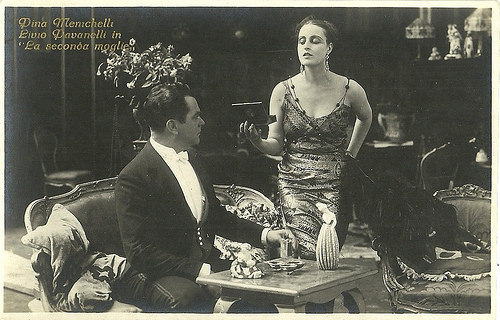
Italian postcard by Edizione G.B. Falci, no. 262. Photo: Pina Menichelli and Livio Pavanelli in La seconda moglie (Amleto Palermi, 1922).
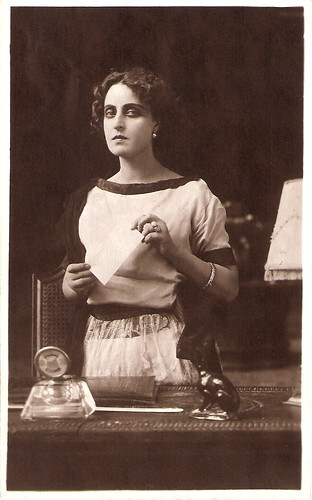
Italian postcard by Rinascimento Film, Roma. Photo: Pina Menichelli in La seconda moglie (Amleto Palermi, 1922).
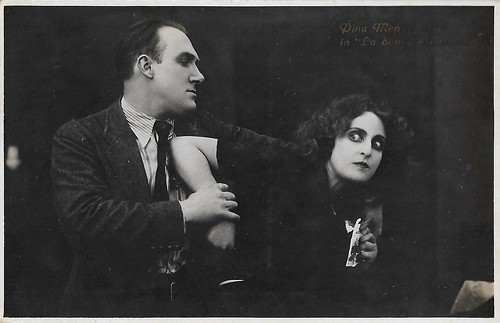
Italian postcard by Ed. G.B. Falci, Milano. Pina Menichelli and Milton Rosmer in La donna e l'uomo (Amleto Palermi, 1923), produced by Rinascimento Film and distributed by UCI.
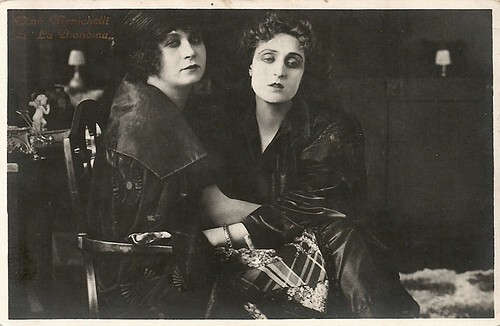
Italian postcard by G.B. Falci, Milano Milan. Pina Menichelli in La biondina (Amleto Palermi, 1923), based on a book by Marco Praga. It tells the tragedy of a woman whose husband kills her in the end. It seems that Italian censorship forced the scriptwriter to add morality to the film, so Praga's tragedy is framed within a story about a modest, conventional wife who, encouraged by her friend, dreams of breaking out, but then she reads Praga's book and decides to remain honest and loyal. The actress on the left of the card could be the friend (Gemma de' Ferrari).

Italian postcard by G.B. Falci, Milano. Photo: Fotominio. Pina Menichelli and Giovanni Grasso in Malafemmina, a title unknown to IMDb, but it is the alternative title of L' ospite sconosciuta/The Unknown Guest (Telemaco Ruggeri, 1923).

Italian postcard by G.B. Falci, Milano. Photo: Pina Menichelli in her last film La dama de Chez Maxim (Amleto Palermi, 1923). Menichelli played the legendary Môme Crevette in one of the many film adaptations of Georges Feydeau's classic boulevard comedy.
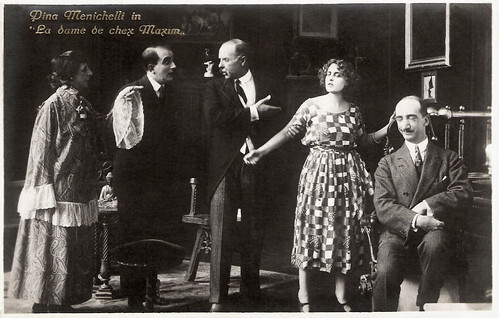
Italian postcard. Photo: G.B. Falci, Milano. Publicity still for La dama de chez Maxim's (1923) with Marcel Lévesque at far right.
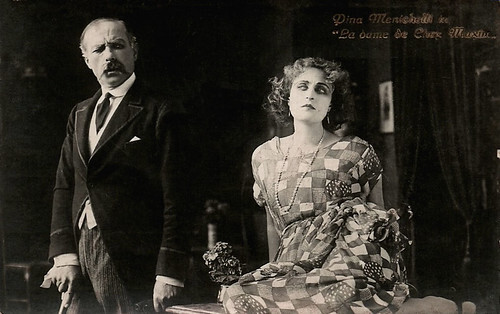
Italian postcard. Photo: G.B. Falci, Milano. Publicity still for La dama de chez Maxim's (1923).
Sources: Vittorio Martinelli (Le dive del silenzio), Greta de Groat (Unsung Divas of the Silent Screen), Il Cinema Ritrovato 2015 and .

Italian postcard by Ed. A. Traldi, Milano, no. 377. Photo: Pinto, Roma.

Italian postcard by Ed. A. Traldi, Milano, no. 411. Photo Pinto, Roma.

Italian postcard by Ed. A. Traldi, Milano (Milan), no. 410. Photo: Pinto.

French postcard by BPA, Rueil.

Italian postcard, no. 47.

Italian postcard by Ed. A. Traldi, Milano, no. 409. Photo: Pinto, Roma.
Notre Dame des Spasmes
Giuseppina Menichelli was born in Castroreale, Italy, in 1890. She was the sister of singer and actress Dora Menichelli.
After starting her film career at the Roman Cines company in 1913, Pina was catapulted into stardom by Giovanni Pastrone's D'Annunzian film Il Fuoco/The Fire (1915) co-starring with Febo Mari . Il Fuoco tells the love story of a young, vulnerable painter and a wealthy woman. The film's erotic atmosphere caused it to be banned and prompted clerical demonstrations against the film.
Because of her femme fatale, men devouring type, and her extreme and sudden gestures she was nicknamed 'Notre Dame des Spasmes'. Menichelli did however know how to play also in a more restrained way, as Tigre Reale/Royal Tiger (Giovanni Pastrone, 1916) showed.
The script was based on a book by Giovanni Verga and was scripted by the author himself. Verga was a Sicilian writer known for his realist (verismo) fiction rather than for his symbolist-decadent works. Despite this, the story of Tigre Reale is a melodrama, full of unlikely twists and turns, but the public was held, mesmerised, by the fascinating and enigmatic Menichelli.

Spanish postcard. Photo: Itala-Film. Pina Menichelli and Febo Mari in Il Fuoco/The Fire (Giovanni Pastrone, 1915). Collection: Marlene Pilaete. Please note that Menichelli wears her famous owl headwear here.

Italian postcard by Ed. Vettori, Bologna. Photo: Pina Menichelli in Tigre Reale (Giovanni Pastrone, 1916).

Italian postcard. Photo: Pina Menichelli in Tigre reale (Giovanni Pastrone, 1916).

Italian postcard by Vettori, Bologna, no. 461. Pina Menichelli and Alberto Nepoti, probably in Tigre reale (Giovanni Pastrone, 1916).

Spanish postcard. Photo: Pina Menichelli in L'olocausto/Méche d'or/Gold Plait (Gero Zambuto, 1918). Collection: Marlène Pilaete.

Italian postcard, no. 3037. Photo: Itala. Pina Menichelli and Vittorio Rossi-Pianelli in La moglie di Claudio (Gero Zambuto, 1918), based on 'La femme de Claude' by Alexandre Dumas fils. The film was found and restored in 2011 by Museo nazionale del cinema in Turin and Cineteca di Bologna. See Vimeo.com.

Italian postcard by Vettori, Bologna. Photo: Pina Menichelli in Il padrone delle ferriere (Eugenio Perego, 1919). The other actress must be Lina Millefleurs.

Italian postcard by Ed. Vettori, Bologna, no. 1038. Pina Menichelli and Luigi Serventi in Il romanzo di un giovane povero (Amleto Palermi, 1920), based on the novel 'Le Roman d'un jeune homme pauvre' (1858) by Octave Feuillet.

Italian postcard by Ed. Vettori, Bologna, no. 1024. Pina Menichelli and Giorgio Fini in the Italian silent film L'età critica (Amleto Palermi, 1921). Her co-stars were Livio Pavanelli , Giorgio Fini and Gemma De Ferrari. The film was based on the play by Max Dreyer, 'Die Siebzehnjährigen' (1904).
The Letter
La dama de chez Maxim's (Amleto Palermi, 1923) was one of Pina Menichelli's last films. With this film and with Occupati d'Amelia (Telemaco Ruggeri, 1925), both adaptations of French boulevard comedies by Georges Feydeau, Menichelli proved she was well able to do comedy and not only melodramatic and 'vampy' films. In both films, one of her co-stars was the French comedian Marcel Lévesque , on the far right on the card below.
After these comedies, however, Pina Menichelli withdrew from the cinema and held back any attempt to interview her.
Pina Menichelli died in 1984 in Milan at the age of 94. Fifteen years later she was one of the divas featured in Diva Dolorosa (Peter Delpeut, 1999), a montage of scenes featuring silent cinema divas, taken from 12 European films made between 1913 and 1920.
In her fascinating, ironic text, Short Manual for the Aspiring Scenario Writer, the French author Colette gave a typical description of the femme fatale in cinema, largely based on Pina Menichelli.
Talking about the 'arms' of the femme fatale Colette indicates the hat and the rising gorge: "The femme fatale' s hat spares her the necessity, at the absolute apex of her wicked career, of having to expend herself in pantomime. When the spectator sees the evil woman coiffing herself with a spread-winged owl, the head of a stuffed jaguar, a bifid aigrette, or a hairy spider, he no longer has any doubts; he knows just what she is capable of. And the rising gorge? The rising gorge is the imposing and ultimate means by which the evil woman informs the audience that she is about to weep, that she is hesitating on the brink of crime, that she is struggling against steely necessity, or that the police have gotten their hands on the letter. What letter? THE letter."

Italian postcard by Edizione G.B. Falci, no. 262. Photo: Pina Menichelli and Livio Pavanelli in La seconda moglie (Amleto Palermi, 1922).

Italian postcard by Rinascimento Film, Roma. Photo: Pina Menichelli in La seconda moglie (Amleto Palermi, 1922).

Italian postcard by Ed. G.B. Falci, Milano. Pina Menichelli and Milton Rosmer in La donna e l'uomo (Amleto Palermi, 1923), produced by Rinascimento Film and distributed by UCI.

Italian postcard by G.B. Falci, Milano Milan. Pina Menichelli in La biondina (Amleto Palermi, 1923), based on a book by Marco Praga. It tells the tragedy of a woman whose husband kills her in the end. It seems that Italian censorship forced the scriptwriter to add morality to the film, so Praga's tragedy is framed within a story about a modest, conventional wife who, encouraged by her friend, dreams of breaking out, but then she reads Praga's book and decides to remain honest and loyal. The actress on the left of the card could be the friend (Gemma de' Ferrari).

Italian postcard by G.B. Falci, Milano. Photo: Fotominio. Pina Menichelli and Giovanni Grasso in Malafemmina, a title unknown to IMDb, but it is the alternative title of L' ospite sconosciuta/The Unknown Guest (Telemaco Ruggeri, 1923).

Italian postcard by G.B. Falci, Milano. Photo: Pina Menichelli in her last film La dama de Chez Maxim (Amleto Palermi, 1923). Menichelli played the legendary Môme Crevette in one of the many film adaptations of Georges Feydeau's classic boulevard comedy.

Italian postcard. Photo: G.B. Falci, Milano. Publicity still for La dama de chez Maxim's (1923) with Marcel Lévesque at far right.

Italian postcard. Photo: G.B. Falci, Milano. Publicity still for La dama de chez Maxim's (1923).
Sources: Vittorio Martinelli (Le dive del silenzio), Greta de Groat (Unsung Divas of the Silent Screen), Il Cinema Ritrovato 2015 and .
Published on January 29, 2023 22:00
January 28, 2023
Rob Lowe
Hunky American actor Rob Lowe (1964) was one of the members of the Brat Pack and a teenage idol during the 1980s. He is also known for the television series The West Wing, in which he played the role of Sam Seaborn.
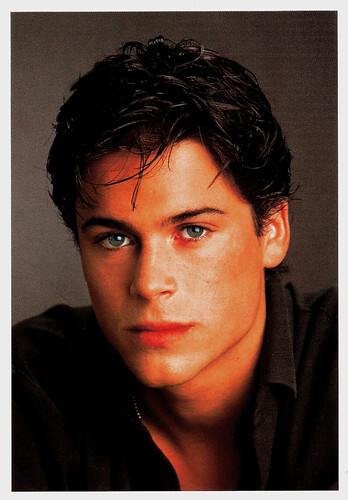
British postcard by Santoro Graphics Ltd, no. C245.

French postcard by Spotlight Magazine.

British postcard by Just Seventeen, one of a set of six postcards. Photo: Retna Pictures Ltd.
Among the original members of the Brat Pack
Robert Hepler (Rob) Lowe was born in Charlottesville, Virginia, in 1964. He was the son of Charles Lowe and Barbara Hepler and grew up in Dayton (Ohio) and Los Angeles. Lowe has one brother, the actor Chad Lowe (1968), and a younger half-brother from his father's second marriage, Justin.
His career began when he was eight years old, with appearances on the local television station and summer theatre. After his parents' divorce, Lowe moved with his mother and brother to Los Angeles where, along with Emilio Estevez and others, he was educated at Santa Monica High School. In 1979, Lowe got the role of Tony Flanagan, the teenage son of star Eileen Brennan, in the television sitcom A New Kind of Family (1979-1980). The series ended after only 11 episodes.
However, his name stuck when newspaper and magazine articles began aligning the handsome, sensitive young actor with the up-and-coming members of the Brat Pack. Along with Judd Nelson, Mare Winningham, Anthony Michael Hall, Demi Moore , Andrew McCarthy, Molly Ringwald, Matt Dillon , Emilio Estevez, Charlie Sheen, and Ally Sheedy, he was among the original members of the Brat Pack. He did a number of television films and earned his first Golden Globe nomination for the teen drama Thursday's Child (David Lowell Rich, 1983). Lowe appeared alongside Matt Dillon , Patrick Swayze , Emilio Estevez and Tom Cruise in The Outsiders (Francis Ford Coppola, 1983).
The following year, he got the lead role in the film The Hotel New Hampshire (Tony Richardson, 1984), alongside Jodie Foster and Nastassja Kinski . Lowe starred with his fellow Brat packers in the coming-of-age film St. Elmo's Fire (Joel Schumacher, 1985). Lowe won his first award for this film: a Razzie Award for worst male supporting actor. Partly because of his looks, Lowe became one of the Pack's most famous members. In between, Lowe starred in less noteworthy productions. In 1988, Lowe received his second Golden Globe nomination for the film Square Dance (Daniel Petrie, 1987).
In 1988, however, his popularity suffered serious damage when a video emerged showing Lowe filming himself having sex with two girls, one of whom appeared to be underage. This happened in Atlanta, where Lowe was attending the 1988 Democratic National Convention. Lowe claimed he did not know she was underage, which was confirmed by the doorman of the bar where they met. She had also lied to get into the bar. For this, Lowe performed 20 hours of community service in Dayton. Around the same time, a leaked home video, in which Lowe could be seen with a model called Jennifer and a boyfriend, Justin Morris, while they were doing a threesome in a hotel room in Paris, was commercially marketed. This was one of the first celebrity sex videos to be sold commercially. Both videos caused a lot of damage to Lowe's career.
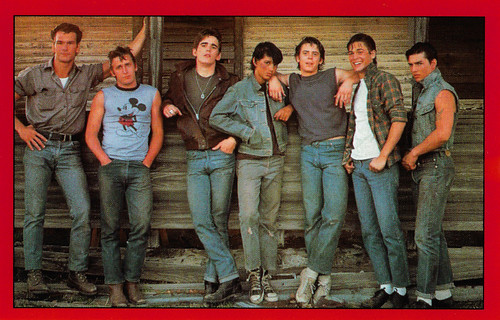
Australian postcard by TV Hits. Photo: N. Moran / Sygma / Austral International. Patrick Swayze , Emilio Estevez, Matt Dillon , Ralph Macchio, C. Thomas Howell, Rob Lowe and Tom Cruise in The Outsiders (Francis Coppola, 1983).
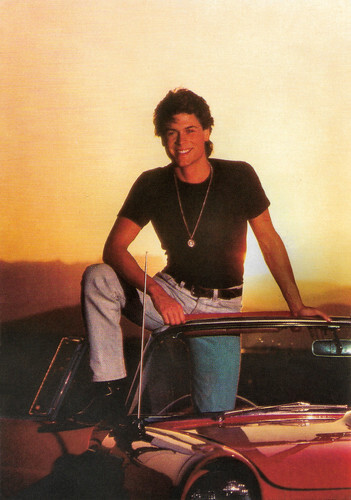
British postcard by Box Office, no. BOPC 3006.
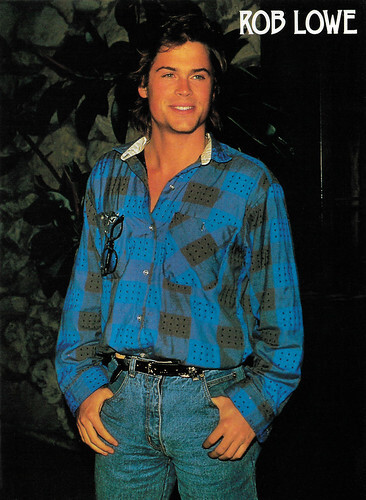
British postcard by Minerva, Edinburgh, no. PC253, 1989.
After the scandals faded into oblivion
After these scandals, Rob Lowe sought treatment at a clinic for alcohol and sex addiction. After the scandals faded into oblivion, Lowe's career revived. This was partly because he mocked his irresponsible behaviour during an appearance as host of Saturday Night Live. In one of his appearances with the church lady, played by Dana Carvey, the latter promises to keep quiet about sex videos during the interview. In return, Lowe gets spanked by her live on TV.
When Lowe is also spanked at the end of the skit, it turns out that, to the dismay of the church lady, this gets him sexually aroused. She starts exclaiming that Satan should be expelled from Lowe's buttocks, to which Lowe tells reporters, "I love getting spanked. I love the feeling of a glowing ass so much".
In 1989, he sang the song 'Proud Mary' with the band Snow White at the Academy Awards, which was not a success. His role opposite James Spader in the film Bad Influence (Curtis Hanson, 1990), in which he had to portray a villain, brought Lowe positively back into the limelight. In 1992, he made his Broadway debut in the play 'A Little Hotel on the Side'. The roles he was offered improved and in the same year Lowe appeared in Wayne's World (Penelope Spheeris, 1992) with Mike Myers and Dana Carvey.
For his portrayal of the deaf-mute and strangely plague-immune Nick Andros opposite Gary Sinise and Molly Ringwald in the miniseries The Stand (Mick Garris, 1994) based on a book by Stephen King, Lowe received rave reviews. After this, Lowe temporarily disappeared behind the camera, where he produced the Western Frank & Jesse (Robert Boris, 1994) in which he also co-starred with Bill Paxton.
In 1997, he wrote and directed the television film Desert's Edge (Rob Lowe, 1997). Also in 1997, he played the role of the right-wing leader of a Christian movement in the Sci-Fi film Contact (Robert Zemeckis, 1997), starring Jodie Foster . In the comedy Austin Powers: The Spy Who Shagged Me (Jay Roach, 1999) starring Mike Myers, he imitated the voice of Robert Wagner for the role of Young Number Two and did an extra as the Decapitated Henchman's Friend.
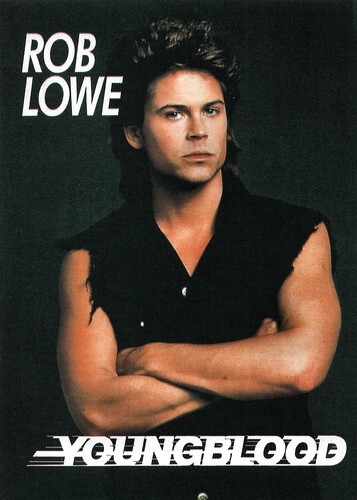
Belgian promotion card by U.I.P. S.N.C., Bruxelles. Photo: United Artists. Rob Lowe in Youngblood (Peter Markle, 1986).
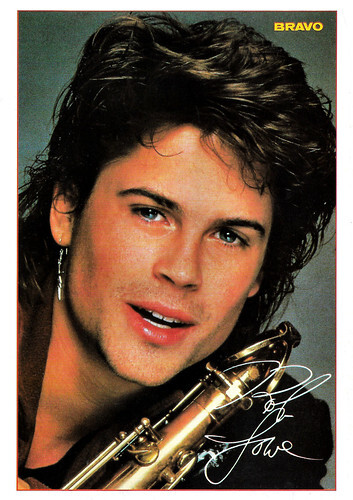
German collectors card by Bravo, ca. 1986.
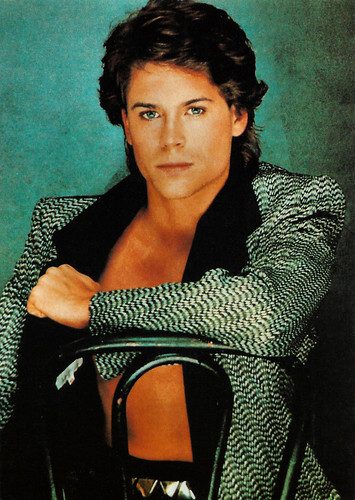
Italian postcard by Vitorius Roma, no. VR 461.
The West Wing
In 1999, Rob Lowe was back on television regularly when he got the role of acting head of communications Sam Seaborn in the NBC hit series The West Wing, about the life of President Bartlett (Martin Sheen). Basically, the series was supposed to revolve around his role, which was then the focus of the pilot episode, but the reviews for the complete cast were so raved, that a shift was made in the role assignment.
In 2000 and 2001, Lowe received Golden Globe nominations in the "Best Actor" category for this, and in 2001 he also received an Emmy Award in the same category. In 2002, however, Lowe left the series because he could not agree on his role and salary. He wanted a more prominent role in the series with an accompanying salary than NBC was willing to give him. Although the other actors and especially Martin Sheen tried to keep him in the series, the episode featuring his departure was aired in February 2003, earlier than expected. During the final season of The West Wing, Lowe returned to his role of Sam Seaborn, appearing in two of the final four episodes.
After this, he featured in the series Lyon's Den (2003), where he plays an idealistic attorney trying to get out of the shadow of his father, who is a senator. The series flopped and was taken off TV after 13 episodes. The same happened with the series Dr. Vegas (2004-2005), also produced by Lowe. It stopped after 10 episodes due to a lack of success. Lowe starred in the remake of the Stephen King miniseries Salem's Lot (Mikael Salomon, 2004) with Donald Sutherland and Samantha Mathis.
In 2005, Lowe played the role of Lieutenant Daniel Kaffee in the theatre production of Aaron Sorkin's play 'A Few Good Men' in West End London. Lowe played a supporting role as a movie agent in the satirical black comedy Thank You for Smoking (Jason Reitman, 2006) starring Aaron Eckhart. In 2013, Lowe played a notable role as the evil plastic surgeon Dr Jack Startz in Behind the Candelabra (Steven Soderbergh, 2013), the successful film about the last decade of pianist and entertainer Liberace's life.
In 2017, Lowe made a reality series with his two sons, the then 24-year-old Matthew and 22-year-old Jon Owen, The Lowe Files. With the exception of the hour-long pilot, the series featured 30-minute road trips with the Lowe boys, and occasional TV guest stars known in the field, investigating common urban myths and legends that Rob has loved since he was a young boy and has shared with his boys throughout their growth. Recently, he starred in and produced the TV series 9-1-1: Lone Star (2020-2023) about firefighters in Austin, Texas. In 2015, Lowe received a star on the Hollywood Walk of Fame. Lowe has been married to makeup artist Sheryl Berkoff since 1991. They met on a blind date in 1983.
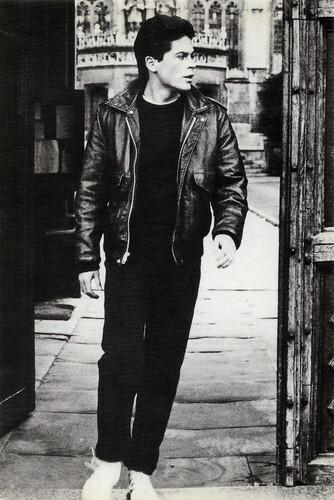
British postcard by Photographs, no. 130.
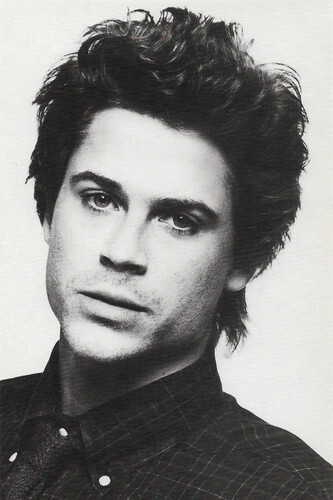
British postcard by Photographs, no. 135.
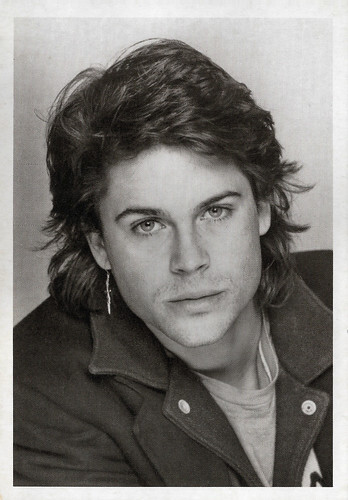
French postcard by Editions Humour à la Carte, Paris, no. ST - 133.
Sources: Hal Erickson (AllMovie), Wikipedia and .

British postcard by Santoro Graphics Ltd, no. C245.

French postcard by Spotlight Magazine.

British postcard by Just Seventeen, one of a set of six postcards. Photo: Retna Pictures Ltd.
Among the original members of the Brat Pack
Robert Hepler (Rob) Lowe was born in Charlottesville, Virginia, in 1964. He was the son of Charles Lowe and Barbara Hepler and grew up in Dayton (Ohio) and Los Angeles. Lowe has one brother, the actor Chad Lowe (1968), and a younger half-brother from his father's second marriage, Justin.
His career began when he was eight years old, with appearances on the local television station and summer theatre. After his parents' divorce, Lowe moved with his mother and brother to Los Angeles where, along with Emilio Estevez and others, he was educated at Santa Monica High School. In 1979, Lowe got the role of Tony Flanagan, the teenage son of star Eileen Brennan, in the television sitcom A New Kind of Family (1979-1980). The series ended after only 11 episodes.
However, his name stuck when newspaper and magazine articles began aligning the handsome, sensitive young actor with the up-and-coming members of the Brat Pack. Along with Judd Nelson, Mare Winningham, Anthony Michael Hall, Demi Moore , Andrew McCarthy, Molly Ringwald, Matt Dillon , Emilio Estevez, Charlie Sheen, and Ally Sheedy, he was among the original members of the Brat Pack. He did a number of television films and earned his first Golden Globe nomination for the teen drama Thursday's Child (David Lowell Rich, 1983). Lowe appeared alongside Matt Dillon , Patrick Swayze , Emilio Estevez and Tom Cruise in The Outsiders (Francis Ford Coppola, 1983).
The following year, he got the lead role in the film The Hotel New Hampshire (Tony Richardson, 1984), alongside Jodie Foster and Nastassja Kinski . Lowe starred with his fellow Brat packers in the coming-of-age film St. Elmo's Fire (Joel Schumacher, 1985). Lowe won his first award for this film: a Razzie Award for worst male supporting actor. Partly because of his looks, Lowe became one of the Pack's most famous members. In between, Lowe starred in less noteworthy productions. In 1988, Lowe received his second Golden Globe nomination for the film Square Dance (Daniel Petrie, 1987).
In 1988, however, his popularity suffered serious damage when a video emerged showing Lowe filming himself having sex with two girls, one of whom appeared to be underage. This happened in Atlanta, where Lowe was attending the 1988 Democratic National Convention. Lowe claimed he did not know she was underage, which was confirmed by the doorman of the bar where they met. She had also lied to get into the bar. For this, Lowe performed 20 hours of community service in Dayton. Around the same time, a leaked home video, in which Lowe could be seen with a model called Jennifer and a boyfriend, Justin Morris, while they were doing a threesome in a hotel room in Paris, was commercially marketed. This was one of the first celebrity sex videos to be sold commercially. Both videos caused a lot of damage to Lowe's career.

Australian postcard by TV Hits. Photo: N. Moran / Sygma / Austral International. Patrick Swayze , Emilio Estevez, Matt Dillon , Ralph Macchio, C. Thomas Howell, Rob Lowe and Tom Cruise in The Outsiders (Francis Coppola, 1983).

British postcard by Box Office, no. BOPC 3006.

British postcard by Minerva, Edinburgh, no. PC253, 1989.
After the scandals faded into oblivion
After these scandals, Rob Lowe sought treatment at a clinic for alcohol and sex addiction. After the scandals faded into oblivion, Lowe's career revived. This was partly because he mocked his irresponsible behaviour during an appearance as host of Saturday Night Live. In one of his appearances with the church lady, played by Dana Carvey, the latter promises to keep quiet about sex videos during the interview. In return, Lowe gets spanked by her live on TV.
When Lowe is also spanked at the end of the skit, it turns out that, to the dismay of the church lady, this gets him sexually aroused. She starts exclaiming that Satan should be expelled from Lowe's buttocks, to which Lowe tells reporters, "I love getting spanked. I love the feeling of a glowing ass so much".
In 1989, he sang the song 'Proud Mary' with the band Snow White at the Academy Awards, which was not a success. His role opposite James Spader in the film Bad Influence (Curtis Hanson, 1990), in which he had to portray a villain, brought Lowe positively back into the limelight. In 1992, he made his Broadway debut in the play 'A Little Hotel on the Side'. The roles he was offered improved and in the same year Lowe appeared in Wayne's World (Penelope Spheeris, 1992) with Mike Myers and Dana Carvey.
For his portrayal of the deaf-mute and strangely plague-immune Nick Andros opposite Gary Sinise and Molly Ringwald in the miniseries The Stand (Mick Garris, 1994) based on a book by Stephen King, Lowe received rave reviews. After this, Lowe temporarily disappeared behind the camera, where he produced the Western Frank & Jesse (Robert Boris, 1994) in which he also co-starred with Bill Paxton.
In 1997, he wrote and directed the television film Desert's Edge (Rob Lowe, 1997). Also in 1997, he played the role of the right-wing leader of a Christian movement in the Sci-Fi film Contact (Robert Zemeckis, 1997), starring Jodie Foster . In the comedy Austin Powers: The Spy Who Shagged Me (Jay Roach, 1999) starring Mike Myers, he imitated the voice of Robert Wagner for the role of Young Number Two and did an extra as the Decapitated Henchman's Friend.

Belgian promotion card by U.I.P. S.N.C., Bruxelles. Photo: United Artists. Rob Lowe in Youngblood (Peter Markle, 1986).

German collectors card by Bravo, ca. 1986.

Italian postcard by Vitorius Roma, no. VR 461.
The West Wing
In 1999, Rob Lowe was back on television regularly when he got the role of acting head of communications Sam Seaborn in the NBC hit series The West Wing, about the life of President Bartlett (Martin Sheen). Basically, the series was supposed to revolve around his role, which was then the focus of the pilot episode, but the reviews for the complete cast were so raved, that a shift was made in the role assignment.
In 2000 and 2001, Lowe received Golden Globe nominations in the "Best Actor" category for this, and in 2001 he also received an Emmy Award in the same category. In 2002, however, Lowe left the series because he could not agree on his role and salary. He wanted a more prominent role in the series with an accompanying salary than NBC was willing to give him. Although the other actors and especially Martin Sheen tried to keep him in the series, the episode featuring his departure was aired in February 2003, earlier than expected. During the final season of The West Wing, Lowe returned to his role of Sam Seaborn, appearing in two of the final four episodes.
After this, he featured in the series Lyon's Den (2003), where he plays an idealistic attorney trying to get out of the shadow of his father, who is a senator. The series flopped and was taken off TV after 13 episodes. The same happened with the series Dr. Vegas (2004-2005), also produced by Lowe. It stopped after 10 episodes due to a lack of success. Lowe starred in the remake of the Stephen King miniseries Salem's Lot (Mikael Salomon, 2004) with Donald Sutherland and Samantha Mathis.
In 2005, Lowe played the role of Lieutenant Daniel Kaffee in the theatre production of Aaron Sorkin's play 'A Few Good Men' in West End London. Lowe played a supporting role as a movie agent in the satirical black comedy Thank You for Smoking (Jason Reitman, 2006) starring Aaron Eckhart. In 2013, Lowe played a notable role as the evil plastic surgeon Dr Jack Startz in Behind the Candelabra (Steven Soderbergh, 2013), the successful film about the last decade of pianist and entertainer Liberace's life.
In 2017, Lowe made a reality series with his two sons, the then 24-year-old Matthew and 22-year-old Jon Owen, The Lowe Files. With the exception of the hour-long pilot, the series featured 30-minute road trips with the Lowe boys, and occasional TV guest stars known in the field, investigating common urban myths and legends that Rob has loved since he was a young boy and has shared with his boys throughout their growth. Recently, he starred in and produced the TV series 9-1-1: Lone Star (2020-2023) about firefighters in Austin, Texas. In 2015, Lowe received a star on the Hollywood Walk of Fame. Lowe has been married to makeup artist Sheryl Berkoff since 1991. They met on a blind date in 1983.

British postcard by Photographs, no. 130.

British postcard by Photographs, no. 135.

French postcard by Editions Humour à la Carte, Paris, no. ST - 133.
Sources: Hal Erickson (AllMovie), Wikipedia and .
Published on January 28, 2023 22:00
Paul van Yperen's Blog
- Paul van Yperen's profile
- 13 followers
Paul van Yperen isn't a Goodreads Author
(yet),
but they
do have a blog,
so here are some recent posts imported from
their feed.



